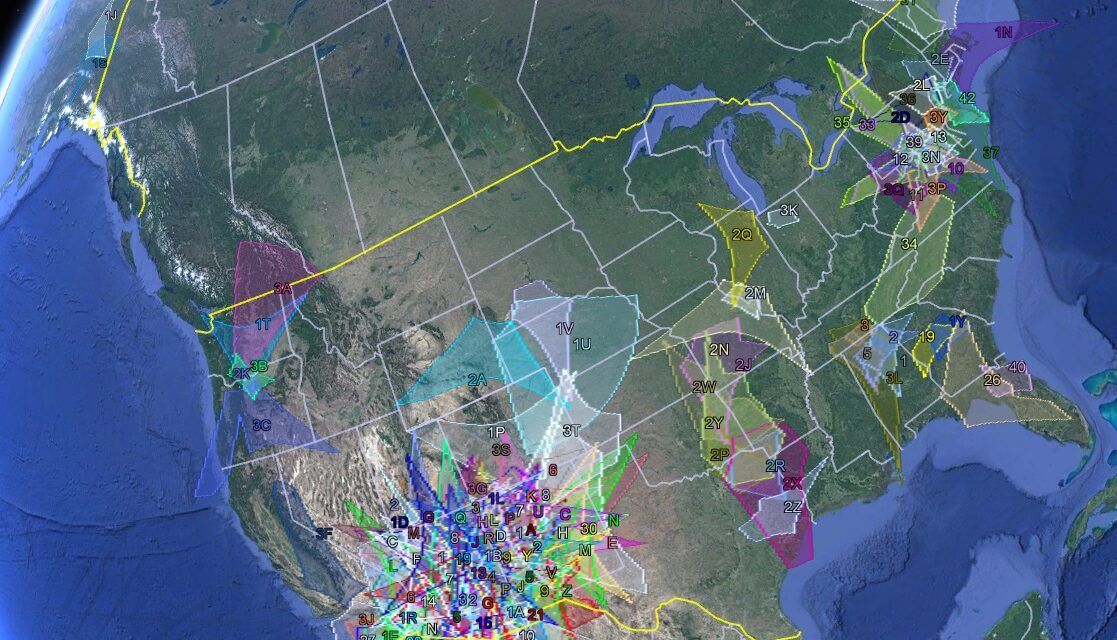By Paul Roggemans, Peter Campbell-Burns, Milan Kalina, Mark McIntyre, James M. Scott, Damir Šegon, Radim Stano, and Denis Vida.
Abstract: A status report is presented for the Global Meteor Network. Since the start of the network, 1174205 orbits have been collected until end of 2023, 425 different meteor showers have been identified among these orbits. During 2023 more than 430 new GMN cameras started contributing successfully paired meteors. 451895 orbits were collected in 2023. The development of the Global Meteor Network in different regions is described. The coverage of the camera fields of view is shown on maps.
1 Introduction
Over the past 15 years many video camera networks were created, both regional and national, with the aim of obtaining meteor trajectories through multi-station registrations. Most of these networks specialise in fireballs and meteorite droppers, others are dedicated to a fainter magnitude range comparable to what visual observers used to cover. The orbit data obtained by these networks brought a tremendous progress in our knowledge of meteoroid streams.
The Global Meteor Network is the most recent development in this domain. Its success builds on the many years of expertise of the Croatian Meteor Network, one of the pioneers in the field of video meteor observations and the origin of GMN (Gural and Šegon, 2009). Based on RMS, the significantly improved Raspberry Pi solution introduced by Zubović et al. (2015) and Vida et al. (2016), the Global Meteor Network began its operation at the end of 2018; its first six cameras located in New Mexico used IP cameras controlled by a Raspberry running its own dedicated software and reduction pipeline (Vida et al., 2021). GMN became the fastest growing meteor video network with 73 operational cameras at the end of 2019, 155 at the end of 2020, 341 at the end of 2021, 700 at the end of 2022 and 1066 in 2023. The analog cameras of the EDMOND network are being replaced gradually by RMS cameras and many new volunteers got involved worldwide with many amateur networks now building and installing RMS cameras.
2 Joining the Global Meteor Network
More information about this project can be found in Vida et al. (2019; 2020; 2021; 2022) and on the GMN website. An informative video presentation about the Global Meteor Network project can be watched online. Many sites and participants are still waiting to find partners to improve the coverage on their cameras. New participants are welcome to expand the network.
To obtain a camera for participation you can either buy it plug&play from Istream, or you buy the components and build your own camera for about 250 US$ or ~200 €. The RMS cameras are easy to build and operate. If you are interested in building your own camera you can find detailed instructions online.
The daily status of most (not all) meteor stations can be followed on a webpage. The GMN results and data are publicly available and daily updated online. The UK meteor network maintains a comprehensive archive and daily update which may inspire others. Their Wiki-page may be helpful to people outside the UK as well as their github repos (Pi tools, UKMON shared).
The meteor map is an online tool for visualizing meteor cameras and ground tracks of observed meteors. Each participant can check the results obtained with each camera, check the location of the meteor trajectories and combinations with other camera stations. The tool has been described in an article (Dijkema, 2022).
As the static maps of camera FoVs presented in this report sometimes become overcrowded, the aggregated kml files valid for end of 2023 can be downloaded. The individual up-to-date kml-files for all GMN cameras can be downloaded from the GMN website. Camera operators are encouraged to point new cameras in function of optimal coverage with other cameras. Opening the kml files in Google Earth allows to toggle cameras on and off to get a better view on the actual coverage. Make sure to compare kml files at the same elevation (e.g. 100km) and prevent 3D perspective by changing the properties in the Google Earth graphical interface to “clamped to ground” instead of the default setting “absolute”. A handy tool to check overlap between two cameras is available online.
If you have a dark site with a free view and if you are looking to make a scientifically useful contribution, with just five RMS cameras with 3.6 mm lenses (FoV 88° × 47°) pointed at azimuths 0° (North), 70°, 140°, 220° and 290°, between 35° and 40° elevation, you cover all the sky except your zenith. Avoid pointing a camera at the meridian (180° azimuth) as the transit of the Full Moon will take full effect in this position. Also do not point lower than 35° elevation: there are no meteors in the local scenery, trees or buildings. If you use 6 mm lenses, recommended where light pollution is an issue, you need six RMS to cover the sky with a royal overlap between the camera edges. Six cameras with 6 mm lenses (FoV 54° × 30°) pointed at azimuths 30°, 90°, 150°, 210°, 270° and 330°, between 35° and 40° elevation, would make you a key video meteor hub in the network. Building the cameras at the cost of the purchased components, or bought plug & play, both remain a low-cost project, affordable to many amateurs, observatories and societies.
The unavailability of Raspberry Pi because of production limitations due to Covid in former years has been meanwhile solved, but inspired people to explore alternative systems for unavailable RPi’s. A cheap Linux PC can handle multiple cameras and a system has been developed to operate multiple GMN cameras using a single PC. Read the article written by Harman et al. (2023) and check the Wiki pages for the latest updates.
3 Annual GMN meeting 2023 (online)
The annual meeting of the Global Meteor Network got more than 100 people participating online from around the globe. The meeting took place in two sessions on February 25–26, 2023 in order to allow people from all time zones to participate. 12 presentations were given with enough time for questions and discussions, each session ended with a Q&A workshop session. Both sessions can be viewed online:
4 The GMN Outreach project
The GMN identified a great educational potential of the GMN cameras and a small team formed in 2022. After the initial discussion, it was decided that the Outreach project would focus on the high school level in the beginning with the potential to adapt the project for younger pupils and also university students, with different levels maintained. The team started to discuss and form the outlines of the curriculum and started to work on the materials. Denis Vida was able to secure funding and we are grateful to the anonymous donor who sponsored 15 GMN cameras for high schools around the world, plug-and-play and kits included. The team was working on preparations, project plan, demand for cameras from team members, hardware sourcing and distribution included.
Table 1 – The schools which are part of the project with their locations.
| School name | Country |
| Bundesrealgymnasium Kepler Graz | Austria |
| Friedrich-Schiller-Gymnasium Preetz | Germany |
| Gymnasium Untergriesbach | Germany |
| Peebles High School | Scotland, UK |
| Inverclyde Academy | Scotland, UK |
| Wick High School | Scotland, UK |
| Laingsburg High School | South Africa |
| Touwsrivier Primary School | South Africa |
The cameras were distributed in the spring of 2023 to the team members who later identified the schools and distributed them locally. In parallel the preparation of materials continued and the website was created to inform the general public about our project and to announce that the project will be made freely available for everybody interested via the website.
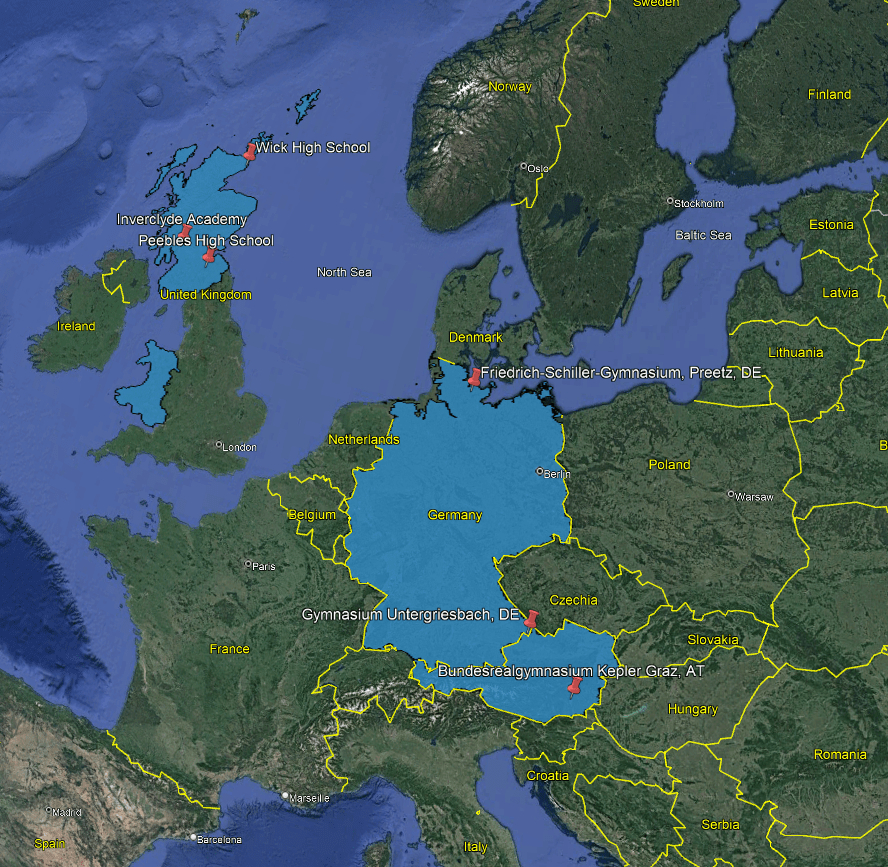
Figure 1 – Locations of European schools participating in the GMN-outreach project.
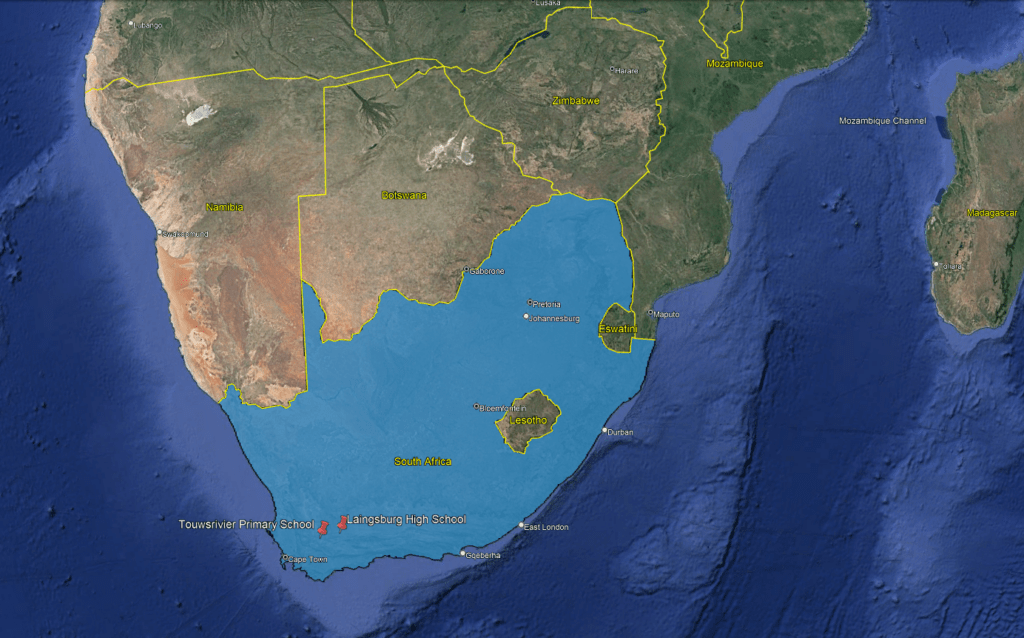
Figure 2 – Locations of South African schools participating in the GMN-outreach project.
In the summer of 2023, three cameras were successfully installed in Washington state during a summer camp. The official start of the project was set for September 2023 when the school year in Europe starts (Figure 1). The cameras were distributed to the schools in Austria (where it will be the first GMN camera), Germany, Scotland, Wales and South Africa (Table 1). We are grateful to The Astronomical Society of Edinburgh which decided to fund three more cameras to the schools in Scotland and whose two members are also part of the Outreach team. In 2023 the first materials were published on the website. South African schools are starting later in January 2024 with the start of the school year (Figure 2). Austrian, German and Scottish schools started to assemble the camera from parts and install them, and good progress has been made. The project continues in 2024 where we expect all the cameras to be installed, operational and the end project presentations held.
Last but not least, the GMN outreach project team members are: Radim Stano, Denis Vida, Tim Cooper, Paul Roche, Laurie Stanton, Mirjana Malarić, Rob Steele, Mary McIntyre and Horst Meyerdierks.
5 GMN camera coverage
The aim of the GMN is to cover all latitudes and longitudes to assure a global coverage of meteor activity in order to let no unexpected meteor event pass unnoticed. This is an ambitious goal especially for a project that depends for most efforts entirely on volunteers’ work. In this report we describe the progress that was made by GMN during 2023 in different regions of the world. The status of the camera coverage is illustrated with maps showing the fields of view intersected at an elevation of 100 km in the atmosphere, projected and clamped to the ground. This way the actual overlap between the camera fields is shown without any effects of 3D perspectives. Where possible the camera ID has been mentioned on the plots. The status at the end of 2023 can be compared to the 2022 annual report (Roggemans et al., 2023).
Many RMS cameras with 4 mm optics have the horizon at the bottom of their field of view what results in a huge camera field at 100 km elevation. Rather few meteors will be bright enough to get registered near the horizon. The large distance between the camera station and the meteor also reduces the chances to obtain a useable triangulation. The number of paired meteors at the outskirts of these large camera fields is very small. However, cameras pointing so low towards the horizon turn out to be very useful regarding obtaining coverage at lower heights where meteorite dropping fireballs end their visible path. When looking for camera overlap, it is strongly recommended to look for an optimized overlap between cameras. An interesting study on this topic for the New Mexico Meteor Array has been published by Mroz (2021). Camera operators are encouraged to optimize their camera overlap.
The number of multi-station events mentioned per country corresponds to the number of orbits, unless an orbit was based on camera data from different countries, then it was counted once for each country. This can also be visualized on the MeteorMap (Dijkema, 2022). The current camera coverage is presented per country or per region for reason of readability. To consider the real overlap for most European countries it is necessary to look at the camera coverage of neighboring countries. In several regions the camera coverage is too dense to visualize it in a single map. We strongly recommend to view the camera FoVs in Google Earth. The required kml-files have been grouped per country and can be downloaded for: Asia, Europe, North America and Southern hemisphere.
5.1 Australia
The first 31 meteor orbits by Australian RMS cameras were registered in September 2021 when the first five cameras got ready to harvest meteors. By the end of 2021, 12 cameras managed to obtain 1871 orbits in the final 4 months of 2021. A real breakthrough was achieved in 2022 as the number of RMS cameras in Australia increased to 29, good for 12460 orbits in 2022. The expansion of the network accelerated even more in 2023 which ended with 67 operational cameras which contributed 41887 orbits making Australia one of the major contributors to GMN (see Table 5). Most cameras were installed in Western Australia (Figure 3) but a significant progress was made in the eastern states of Australia with more cameras in Victoria, Queensland and New South Wales (Figure 4). Australia being a very large country, describing its camera networks as a single network is a bit unfair as it is like considering all European countries as a single EU network.
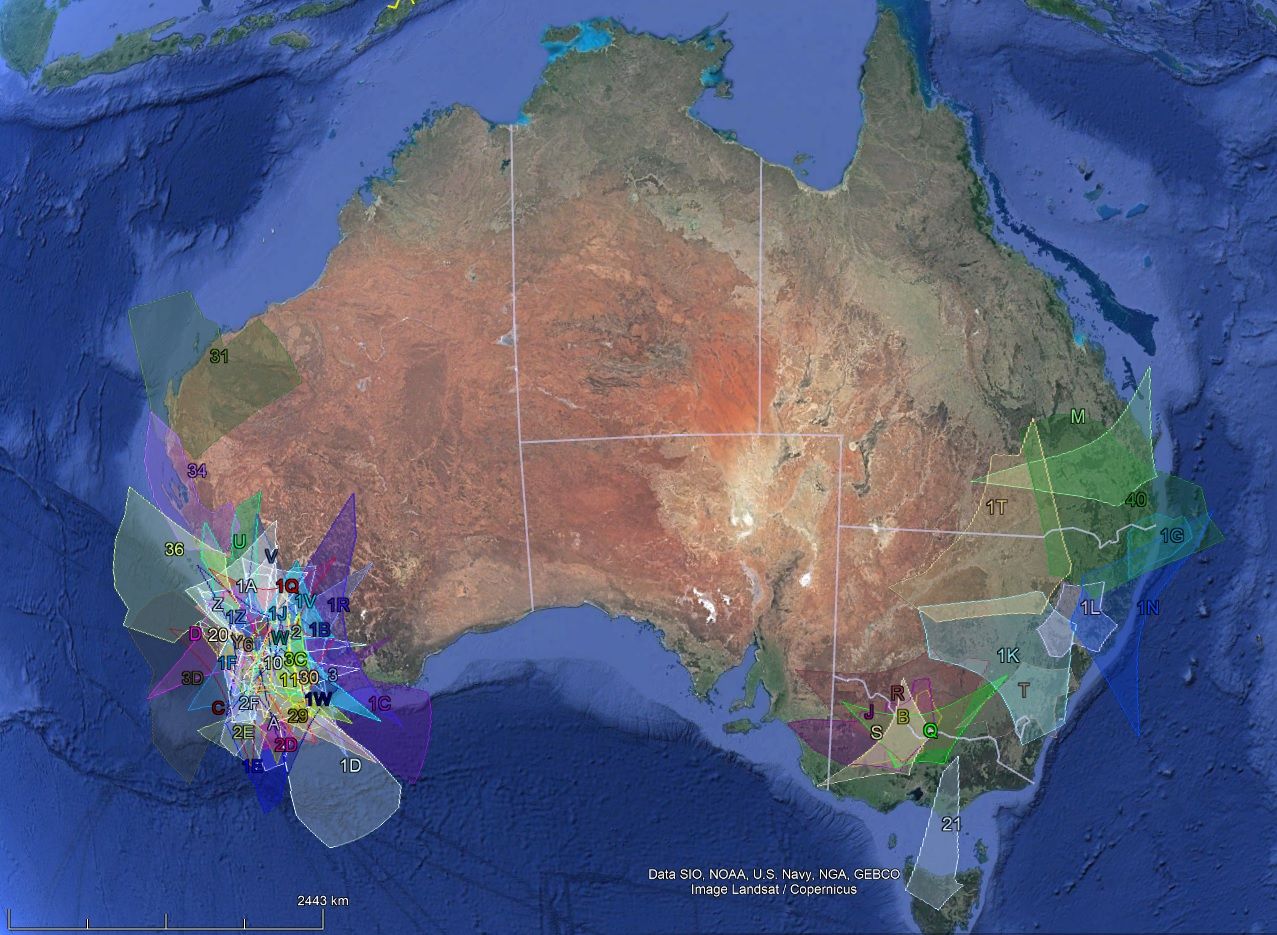
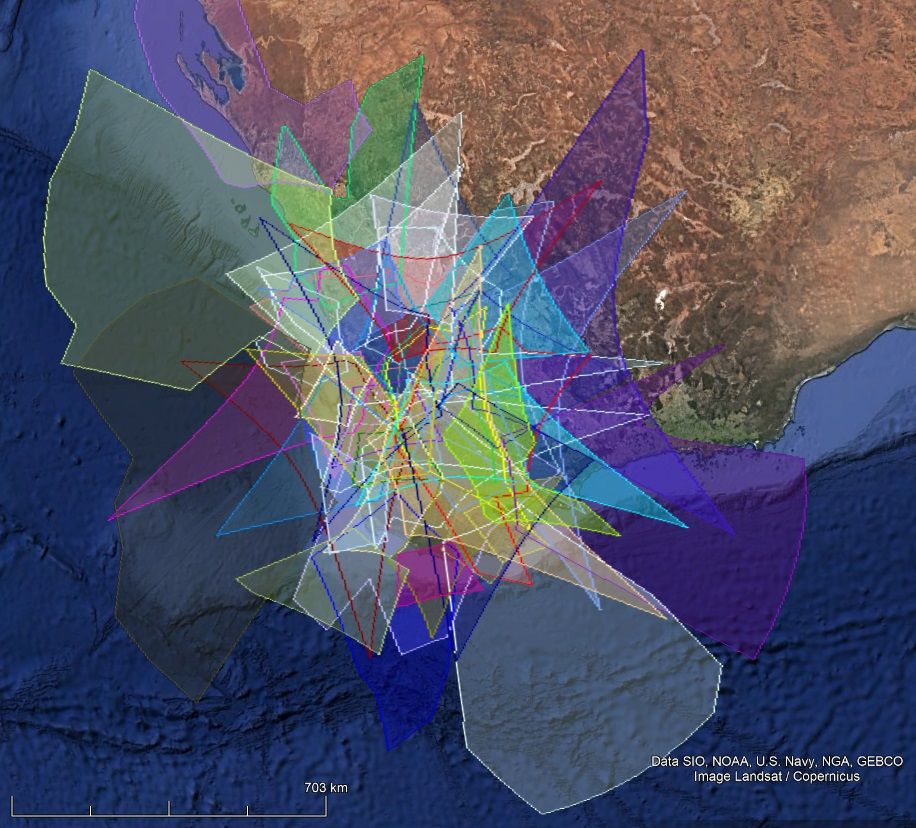
Figure 3 – GMN camera fields in 2023 intersected at 100 km elevation, for cameras active in Australia, global view on top and a close up for Western Australia at bottom.
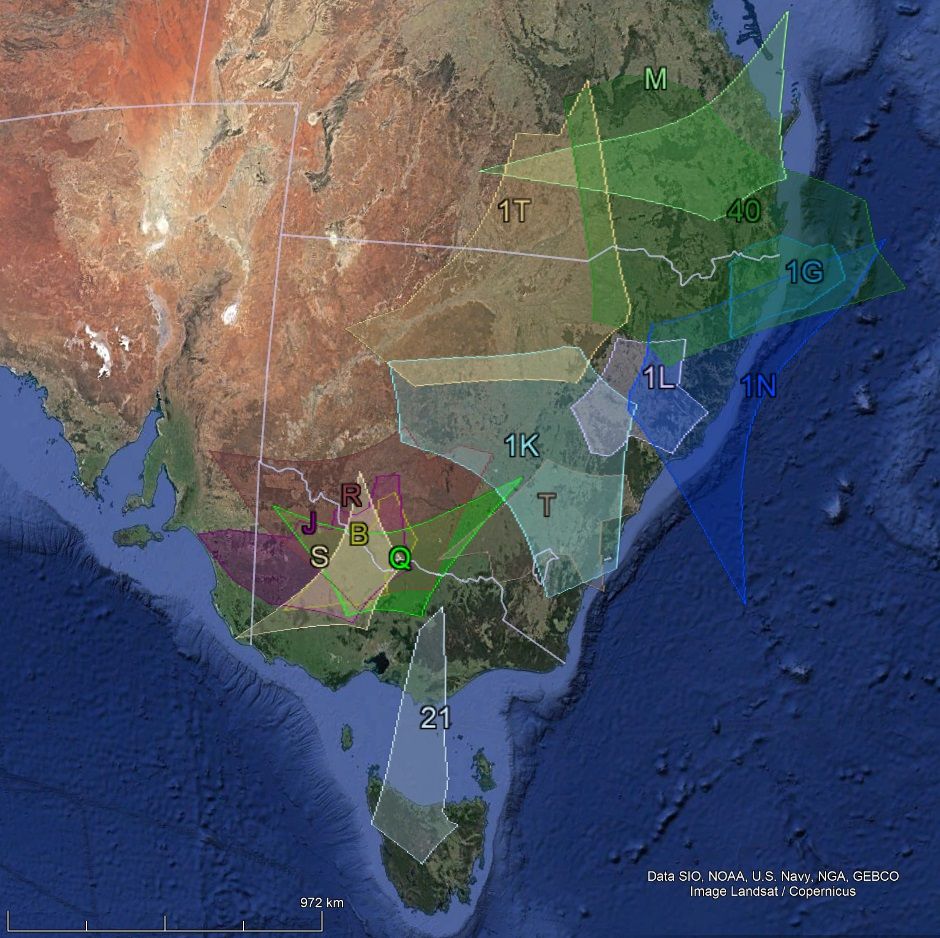
Figure 4 – GMN camera fields in 2023 intersected at 100 km elevation, for cameras active in Australia (eastern states).
5.2 Belgium
Belgium had its first RMS cameras operational in early 2019. Figure 5 shows the GMN coverage at the end of 2023 for Belgium. The map can be compared with the situation end of 2022 in the previous GMN annual report (Roggemans et al., 2023).
Most of the Belgian RMS cameras are being installed for the reinforcement of the CAMS-BeNeLux network. For this purpose, the 6 mm lenses are preferred which have less distortion than the 3.6 mm and detect more fainter meteors. The weather in 2023 was significantly less favorable than during the exceptional year 2022, but Belgian cameras still contributed to 25720 orbits in 2023 compared to 23174 a year before. The number of cameras increased from 20 in 2022 to 24 in 2023. Belgian cameras have many paired meteors with those in neighboring countries, France, Germany, Netherlands and the UK.
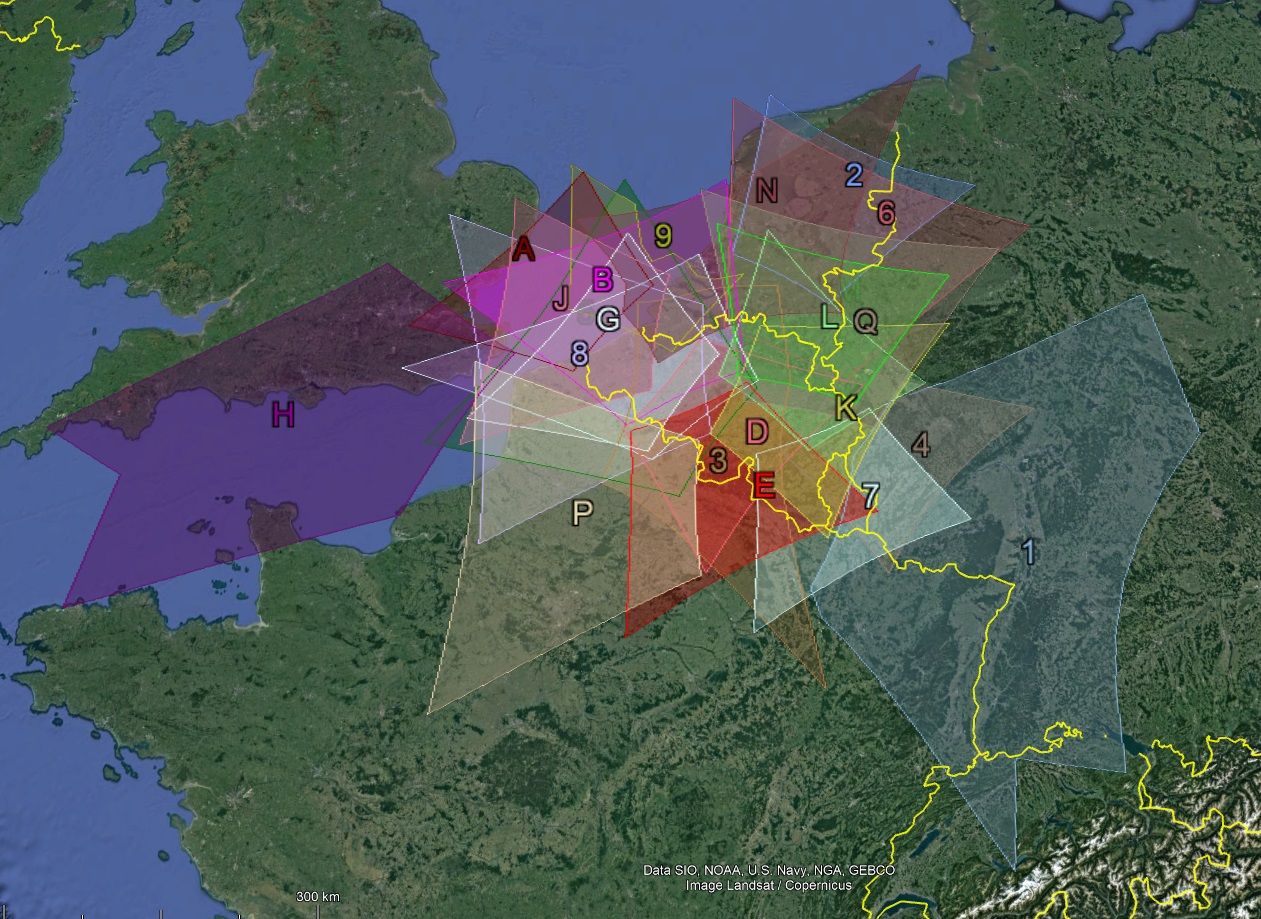
Figure 5 – GMN camera fields intersected at 100 km elevation, for 24 cameras installed in Belgium, status 2023.
5.3 Brazil
The BRAMON network had its first two RMS cameras getting paired meteors in October 2020 good for 40 orbits with two cameras in the last quarter of 2020. The network expanded to 13 operational cameras, good for 1645 orbits in 2021. In 2022 the number of cameras increased to 20 and 2760 orbits were obtained. In 2023 the number of cameras increased to 34 but the number of paired meteors dropped to 2331, it is not clear why but many cameras had several months without paired meteors. Brazil is a huge country and most RMS cameras are installed in the southern part (Figure 6).
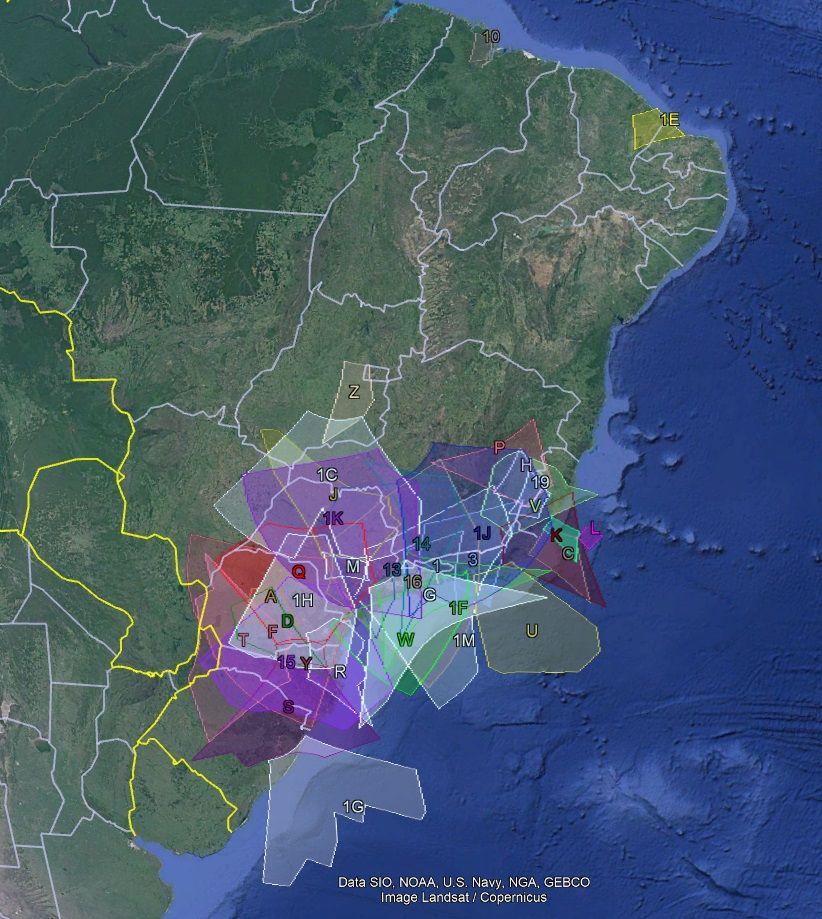
Figure 6 – GMN camera fields in 2023 intersected at 100 km elevation, for 34 cameras active in Brazil.
5.4 Bulgaria
Bulgaria got its first RMS camera operational in June 2021 and got three cameras installed by the end of 2021 of which two had 419 multi-station events. In April 2022 a 4th RMS and in July 2022, two extra cameras were installed. With 6 cameras in 2022, 3877 orbits could be collected. In 2023 three more cameras became operational, but BG0005 and BG0006 didn’t have paired meteors in 2023. Seven operational cameras had 3530 orbits in 2023 (Figure 7). The new cameras were added in the last months of 2023 when the weather was less favorable. The Bulgarian RMS cameras also get paired meteors with cameras in Greece and in Romania.
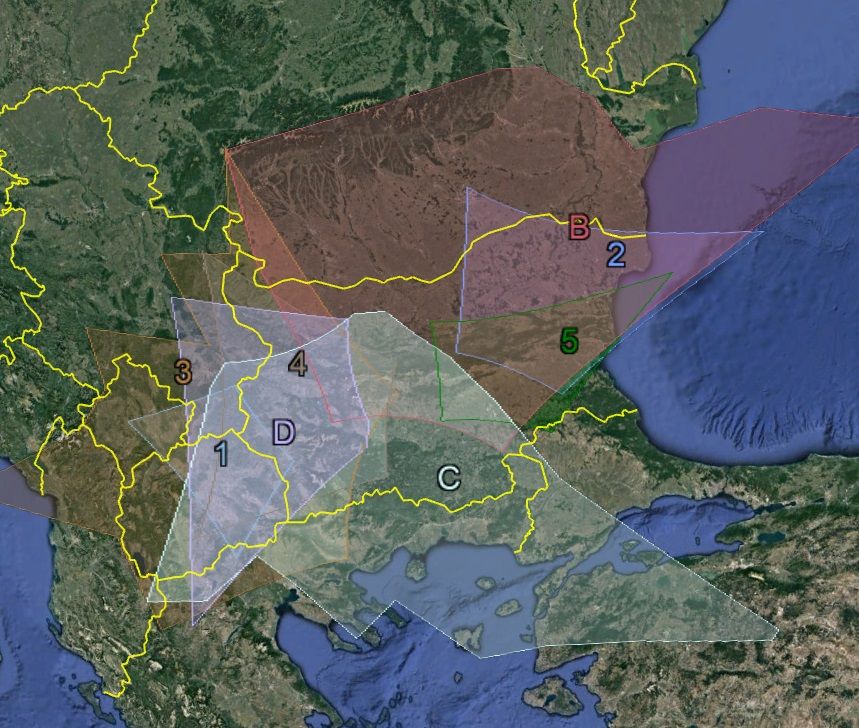
Figure 7 – GMN camera fields in 2023 intersected at 100 km elevation, for 7 cameras active in Bulgaria.
5.5 Canada
The Canadian GMN network got its first five operational RMS cameras providing orbits in June 2019 and expanded to 11 cameras by the end of 2019, good for 3599 orbits. The number of cameras increased to 18 by the end of 2020 with 10815 orbits registered. During 2021, 15 new camera IDs appeared in the list and 8809 orbits were recorded with 29 cameras in 2021, less than the year before despite the extra cameras. The number of cameras doubled from 29 to 58 in 2022 resulting in 16232 orbits. Some cameras in New Found Land still wait for a multi-station partner (Figure 8).
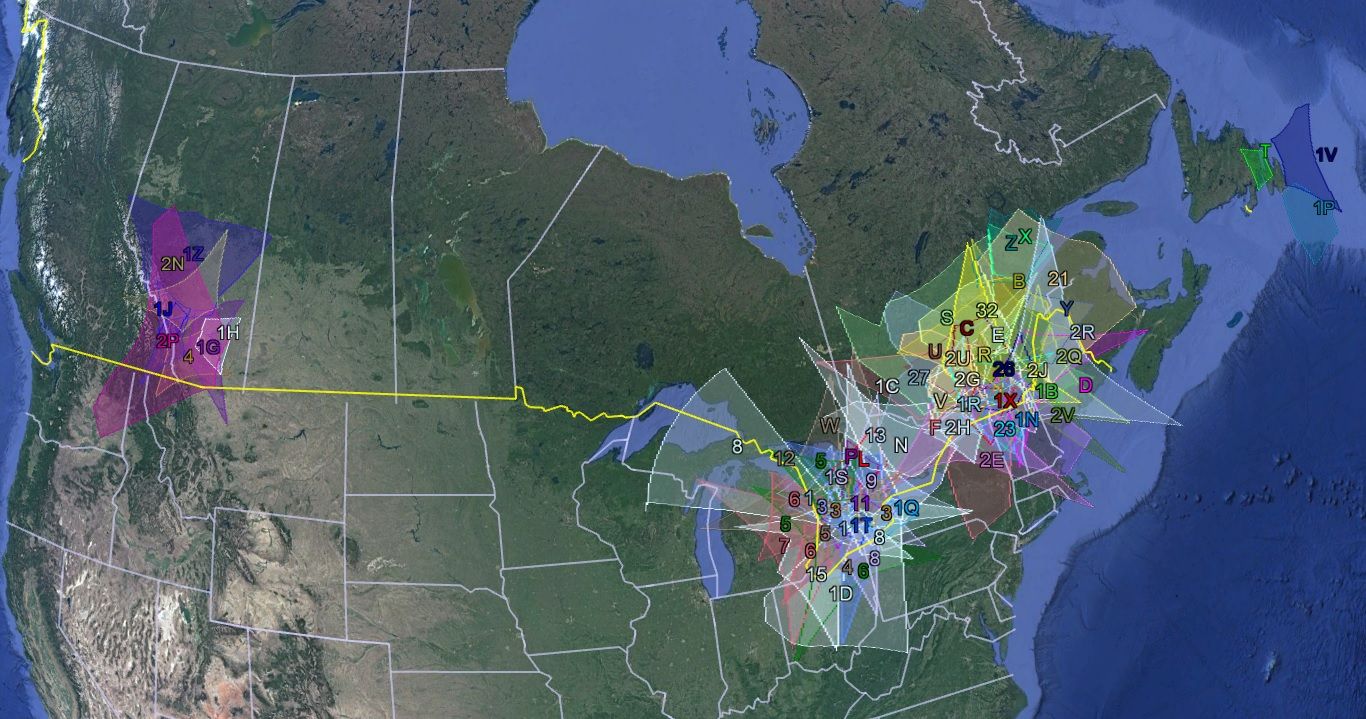
Figure 8 – GMN camera fields in 2023 intersected at 100 km elevation, for cameras active in Canada, overview.
Most cameras are installed in Quebec and Southern Ontario, ideal for volunteers south of the Canadian border in the US (Figure 9). In 2023 the number of contributing cameras increased to 67 resulting in 15023 orbits. As many as 16 Camera IDs that worked in previous years have disappeared from the list in 2023. Two smaller sub-networks exist, CAWE (Elginifield) which had 425 orbits and CAWT (Tavistock) which had 193 orbits in 2023, both networks being composed of eight cameras. A small network in the Calgary region of Alberta had its first orbits in 2022
(Figure 10) and improved coverage in 2023.
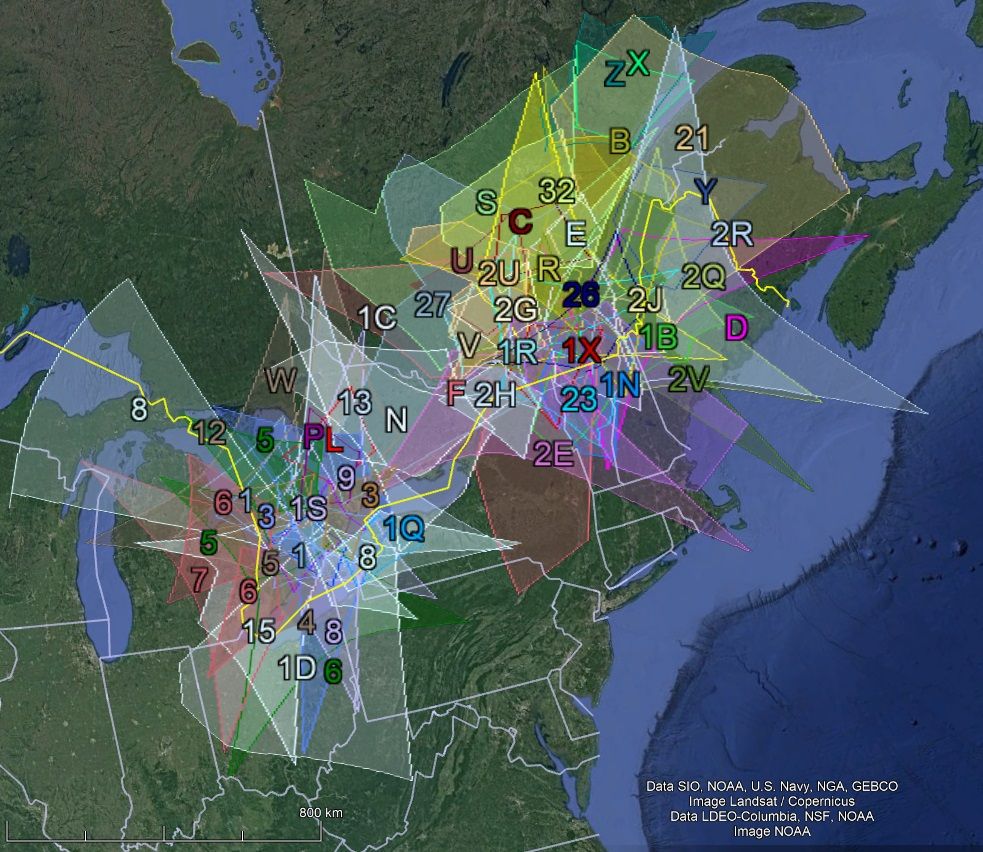
Figure 9 – GMN camera fields intersected at 100 km elevation, for cameras active in Canada, Quebec and Ontario in 2023.
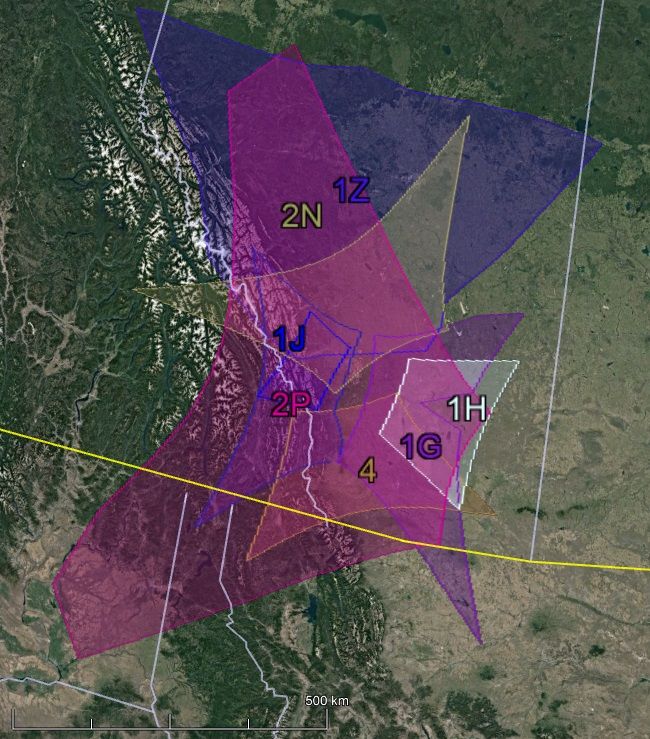
Figure 10 – GMN camera fields intersected at 100 km elevation, for cameras active in Canada, Alberta in 2023.
5.6 Croatia
Croatia was the first European country in May 2019 to harvest orbits with three RMS cameras. By the end of 2019 Croatia had already 23 cameras successfully contributing in triangulations, good for 12221 multi-station events. The number of cameras increased to 32 in 2020 resulting in 35099 orbits that year. 38370 multi-station events were recorded in 2021 with 48 cameras. 2022 was slightly less successful with 31329 orbits and 45 operational cameras. In 2023 the number of cameras slightly decreased at 41 which contributed to 27721 orbits. 14 camera IDs from previous years didn’t appear in the 2023 data anymore. Lots of cameras were running on RPi3, for years – and the time has come for them to be replaced; some of those couldn’t be replaced due to the huge workload that IstraStream guys had supplying the rest of the world with new cameras. One camera operator passed away and a number of cameras couldn’t be reached anymore. The problems should be solved in 2024.
Croatia plays a major role in the coordination of GMN, maintaining the IstraStream service to produce and deliver new cameras for many countries and providing technical assistance to participants in the GMN project worldwide. The Croatian cameras provide a huge overlap on the neighboring countries (Figure 11). A number of Croatian cameras have a very small FoV to register fainter meteors with higher positional accuracy. To view these camera fields in detail we refer to the online KML files for consultation in Google Earth.
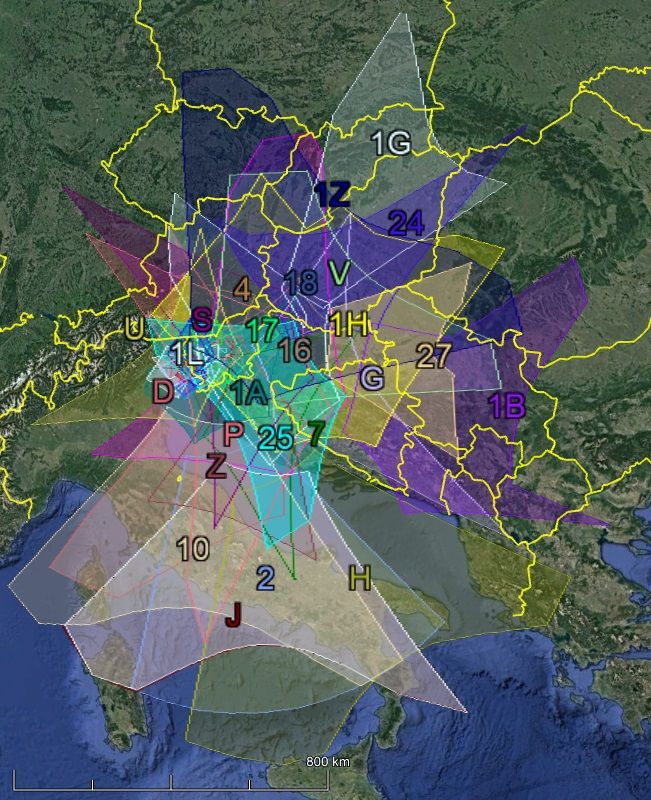
Figure 11 – GMN camera fields intersected at 100 km elevation, for cameras installed in Croatia, status 2023.
5.7 Czech Republic
The number of operational RMS cameras in the Czech Republic increased a lot in 2023 from six in 2022 to 20 in 2023. In total 11269 orbits were obtained in 2023 against 2490 in 2022 and 464 in 2021. The central location of the country in Europe and the increasing number of cameras installed in neighboring countries determine to a large extent the number of paired meteors (Figure 12).
Since the end of 2022, the Czech and Slovak GMN camera operators are grouped in the CSMON (Czech & Slovak Meteor Observation Network), which helps the new and current meteor enthusiasts to get on board. Started by skilled individuals, the network has recently grown thanks to several observatories located across the region.
In addition to GMN, the CEMeNt network has resumed the trajectory calculation from the past recordings, after a five years long break. It is hoped that many former analog cameras in this network will upgrade to RMS in the near future.
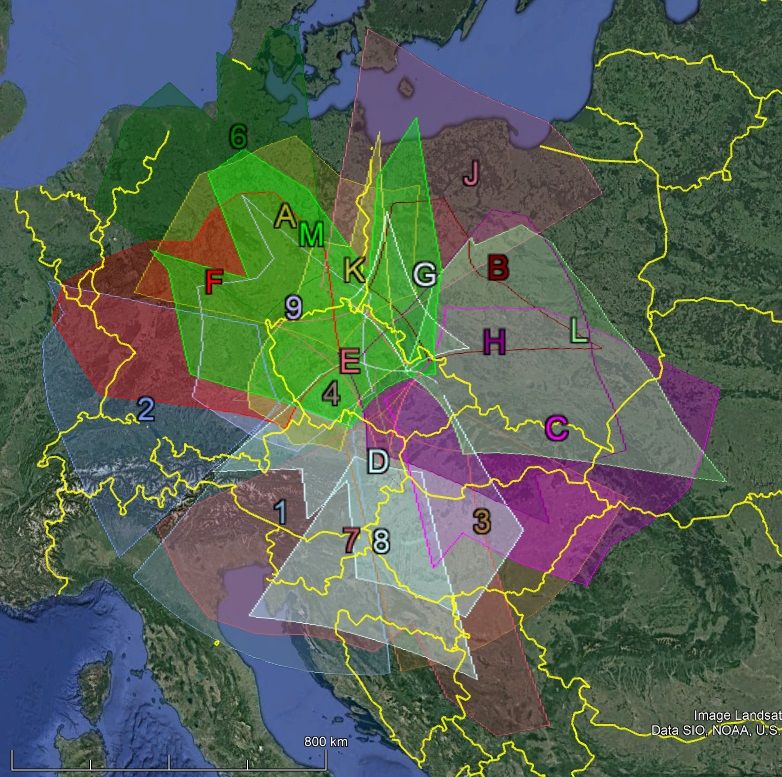
Figure 12 – GMN camera fields in 2023, intersected at 100 km elevation, for cameras active in the Czech Republic.
5.8 Denmark
In October 2022 a first GMN camera got operational in Denmark, good for 55 orbits in 2022. In 2023 four cameras were active in Denmark which obtained 1386 orbits (Figure 13). These northern cameras create possibilities for further camera coverage in southern Norway and Sweden.
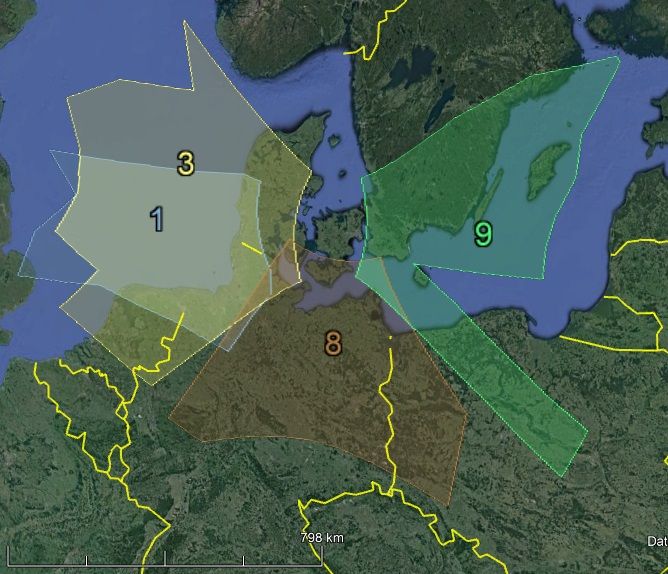
Figure 13 – GMN camera field in 2023 intersected at 100 km elevation, for cameras active in Denmark.
5.9 Finland
In October 2022 the first GMN cameras became operational at two sites in Finland, with 41 orbits as a first result (Figure 14). In 2023 there were five cameras active which resulted in 90 orbits.
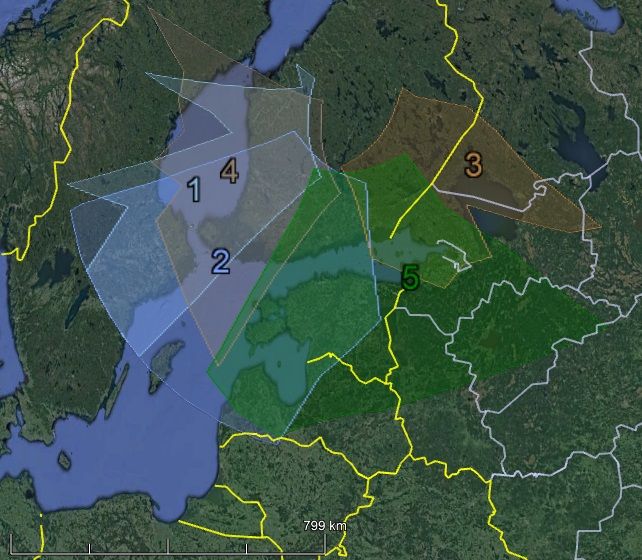
Figure 14 – GMN camera fields in 2023 intersected at 100 km elevation, for cameras active in Finland.
5.10 France
The number of RMS cameras in France increased gradually from 10 in 2020 to 14 devices in 2021 and 16 in 2022. More new cameras were installed in 2023 and 16682 orbits were obtained with 18 cameras, a much better result than in 2022 when 11990 orbits were obtained. In total 25 RMS cameras were installed since March 2020, but seven of them did not function anymore in 2023. A large part of France is still without GMN coverage (Figure 15).
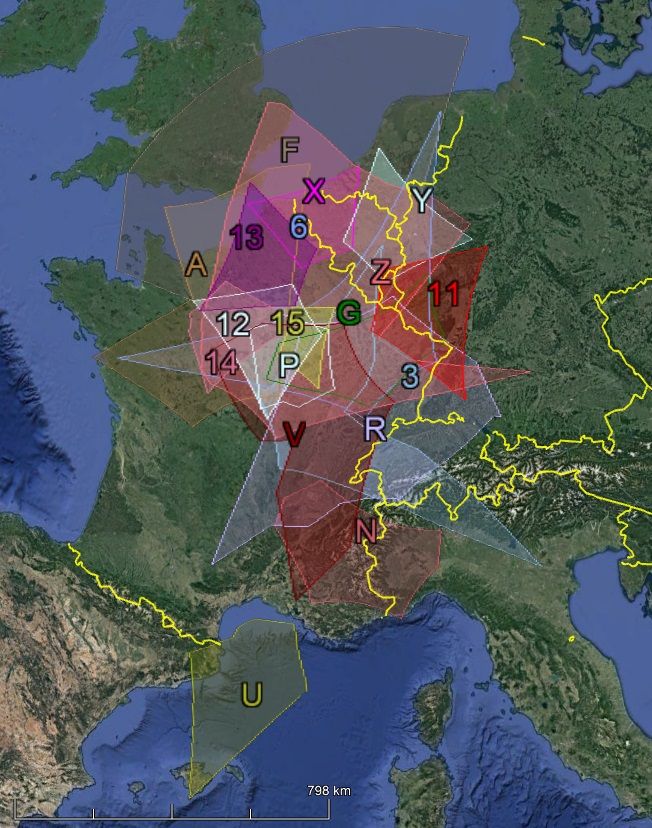
Figure 15 – GMN camera fields in 2023 intersected at 100 km elevation, for cameras active in France.
5.11 Germany
The first GMN camera in Germany had its first orbits in August 2019 with Belgian GMN cameras. By the end of 2019 there were four GMN cameras in Germany, good for 200 orbits. The number of cameras increased to 10 and the numbers of orbits to 3963 in 2020. With 12 cameras in 2021, 7009 orbits were collected, in 2022, with 18 cameras 9128 orbits were collected. In 2023 as many as 12194 orbits were recorded with 19 cameras. Some GMN cameras in the North-Western part of Germany also participate in the CAMS-BeNeLux network, supporting both GMN and CAMS (Figure 16).
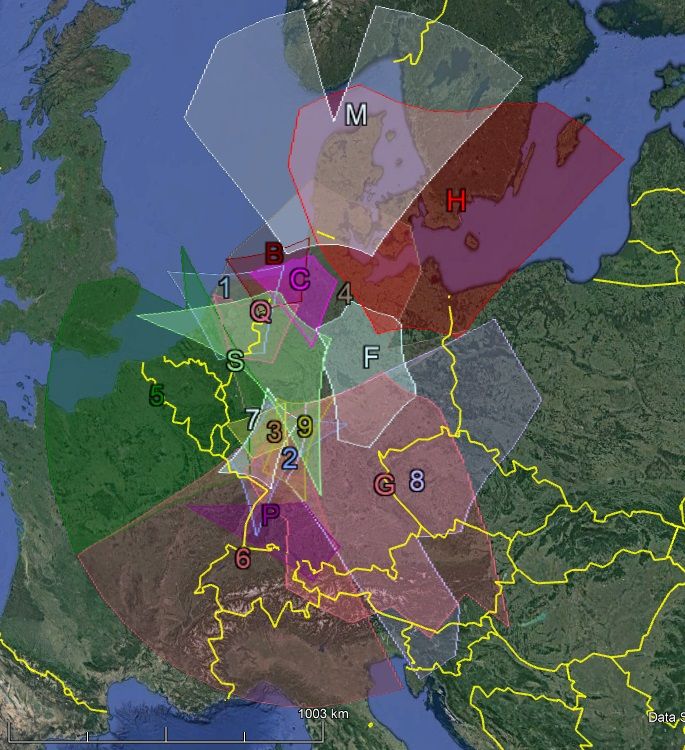
Figure 16 – GMN camera fields in 2023 intersected at 100 km elevation, for cameras active in Germany.
5.12 Greece
In September 2022 the first GMN camera got operational in Greece, ideally pointed to overlap with some Bulgarian GMN cameras, good for 977 paired meteors in the four last months of 2022. Three extra cameras were installed and with four cameras 3375 orbits were obtained in 2023 (Figure 17).
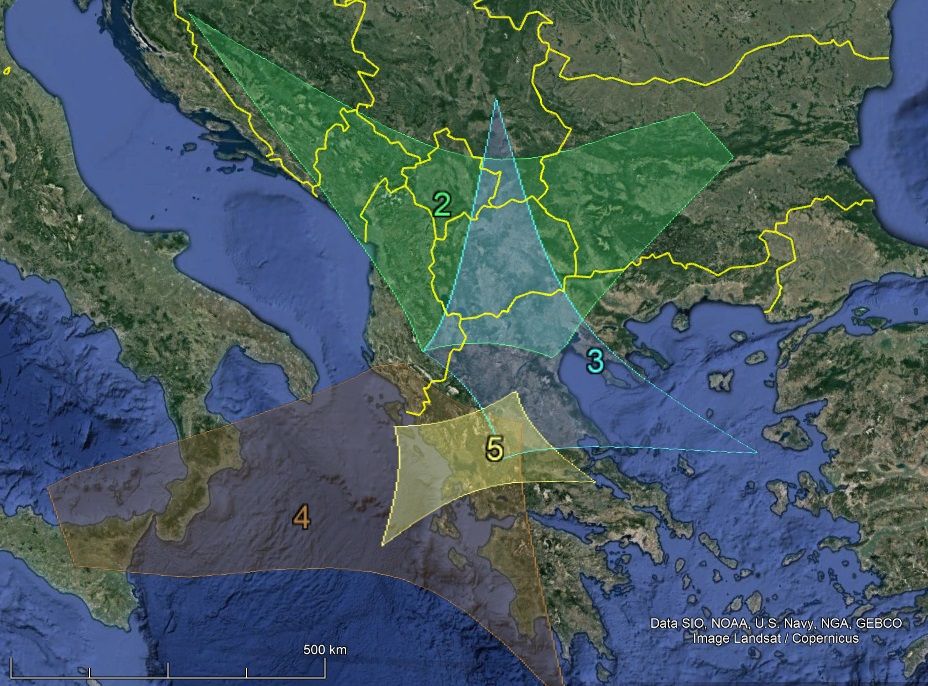
Figure 17 – GMN camera fields in 2023 intersected at 100 km elevation, for cameras active in Greece.
5.13 Hungary
A first GMN camera got operational in March 2022 in Hungary and by end of 2022, two Hungarian cameras had obtained 2114 orbits. One new camera was added in 2023 and last year, Hungarian cameras contributed to 7872 orbits, mainly paired meteors with Croatian and Czech cameras. Hungary has a long tradition in meteor astronomy and hopefully more GMN camera sites will get installed
(Figure 18).
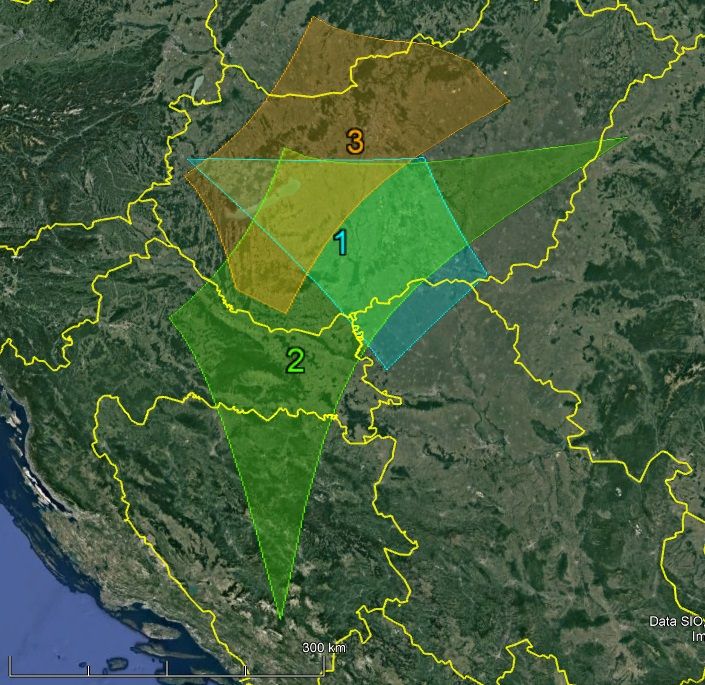
Figure 18 – GMN camera fields in 2023 intersected at 100 km elevation, for cameras active in Hungary.
5.14 Ireland
Ireland got a first GMN operational in October 2020 and a second one a month later, good for 120 orbits in 2020. With three cameras in 2021 the number of orbits increased to 424. 3490 orbits were recorded in 2022 with five GMN cameras. In 2023 the number of cameras remained unchanged (Figure 19) but the number of orbits dropped to 1954. Most of the paired meteors were obtained thanks to the overlap provided by GMN cameras in the UK. Many attributed GMN camera IDs don’t show up on the map.
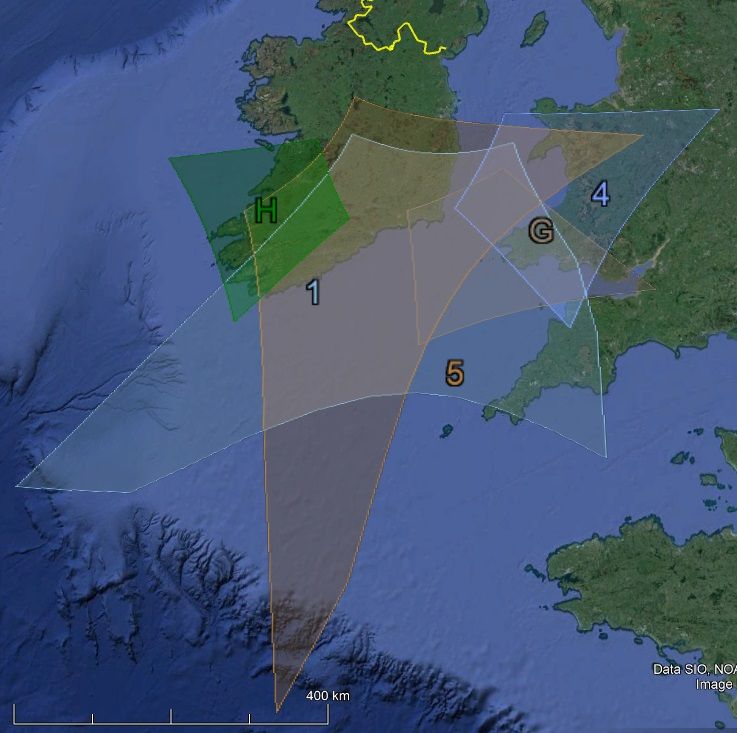
Figure 19 – GMN camera fields in 2023 intersected at 100 km elevation, for cameras active in Ireland.
5.15 Israel
Israel got its first three GMN cameras installed in November 2020, good for 553 orbits that year. In 2021 with three extra cameras 2009 orbits were obtained. In 2022 the cameras did not provide orbits during some time and one camera was discontinued, resulting in 975 orbits. In 2023, 1096 orbits were collected using six cameras (Figure 20).
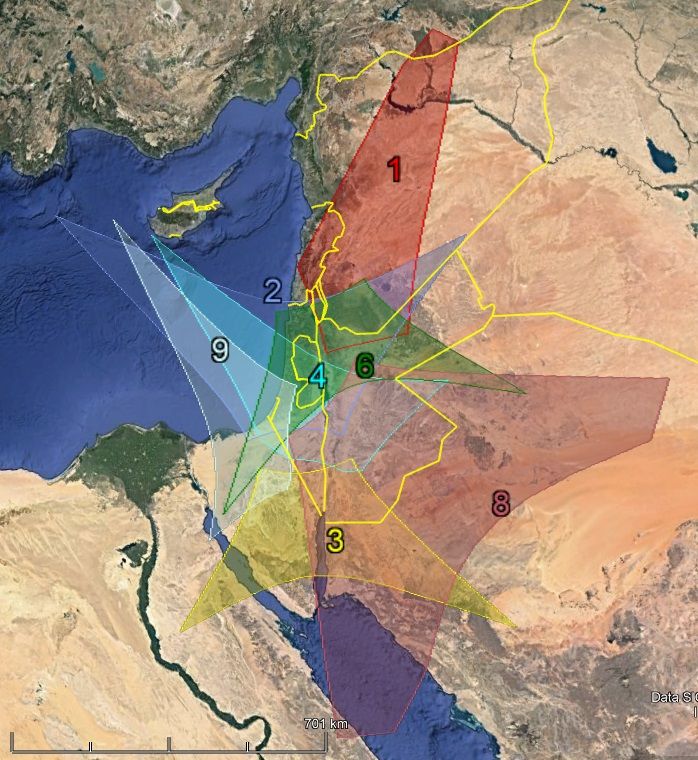
Figure 20 – GMN camera fields in 2023 intersected at 100 km elevation, for cameras active in Israel.
5.16 Italy
Italy got its first GMN camera installed and contributing to orbits in October 2019, good for 862 orbits in 2019. Italy remained with one GMN camera in 2020, which had as many as 5384 paired meteors with Croatian and Slovenian cameras. Italy increased its number of cameras from one to five and these cameras were involved in 5447 multi-station events in 2021. An extra camera was added in Bologna in 2022 when 4943 orbits were collected. With seven cameras in 2023, 5064 orbits were obtained (Figure 21).
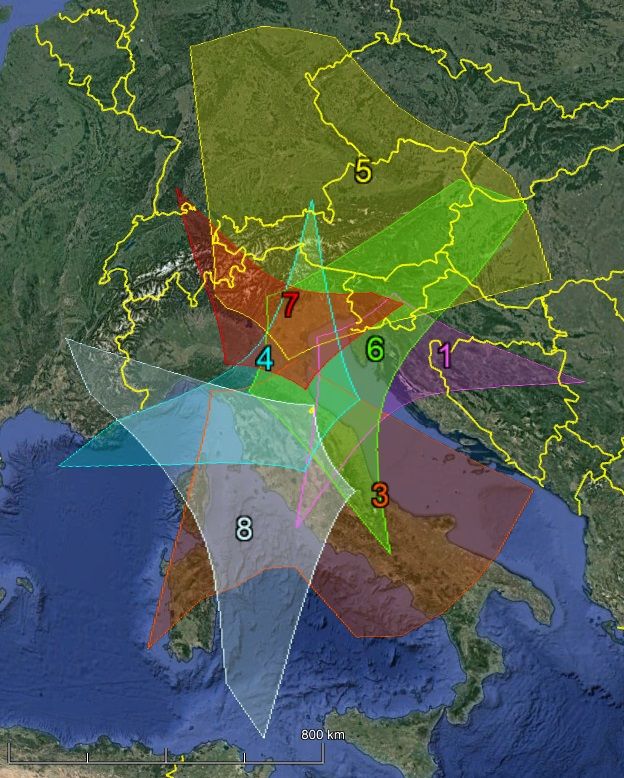
Figure 21 – GMN camera fields in 2023 intersected at 100 km elevation, for cameras active in Italy.
5.17 Japan
A first GMN camera got installed in Japan in 2022, waiting for some multi-station partners at suitable distance for triangulation. In 2023 a second camera was installed which allowed to obtain 629 orbits (Figure 22). Japan has the very active SonotaCo network which uses analog Watec cameras. RMS cameras deliver UFO capture output which may offer opportunities for the SonotaCo network.
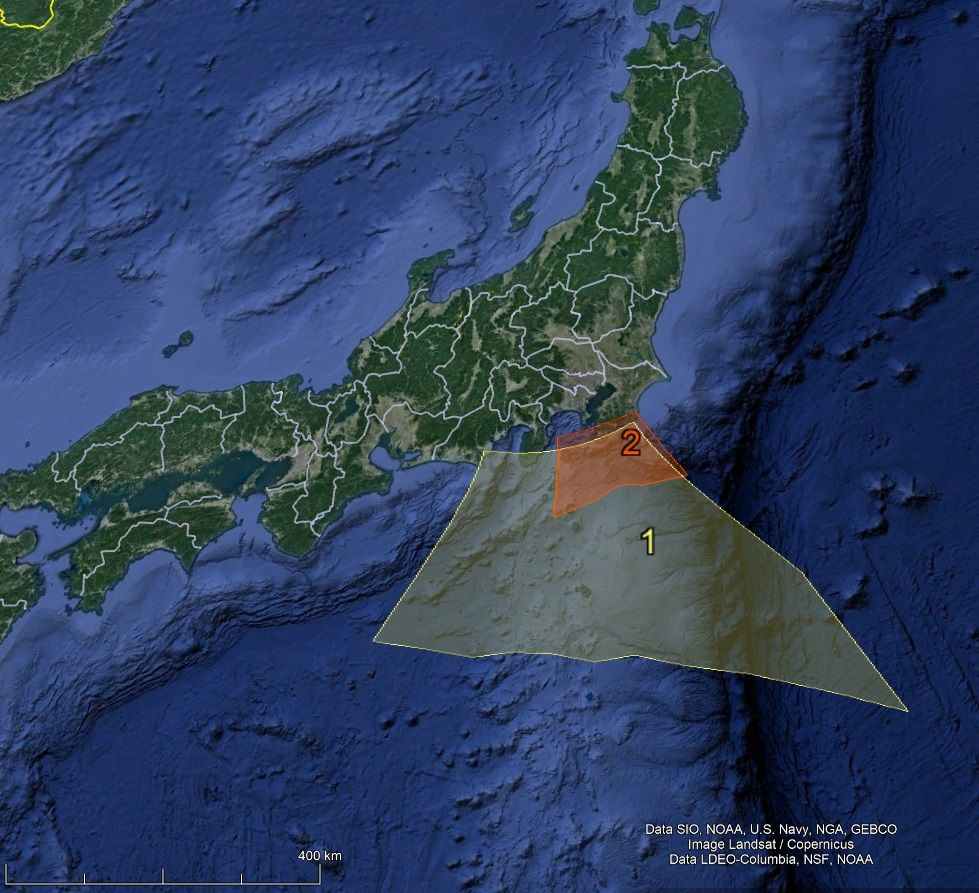
Figure 22 – GMN camera fields in 2023 intersected at 100 km elevation, for cameras active in Japan.
5.18 Korea (South)
A most impressive deployment of GMN cameras took place in 2022 in South Korea with a first few cameras obtaining orbits in September and as many as 47 GMN cameras installed in November and December 2022. The cameras were installed and pointed to obtain an optimal overlap resulting in 7711 orbits during the first year. In 2023 the number of cameras rapidly increased to 125 (!) collecting 34044 orbits. This fast deployment made the RMS network in South Korea a major contributor at a strategic geo location at the northern hemisphere for a 24 on 24-hour monitoring of meteor activity.
The dense coverage of overlapping camera fields in 2023 can be compared to the situation end of 2022 in Figure 23. If any RMS cameras get installed in South-Western Japan, these would generate many paired meteors with the Korean cameras.
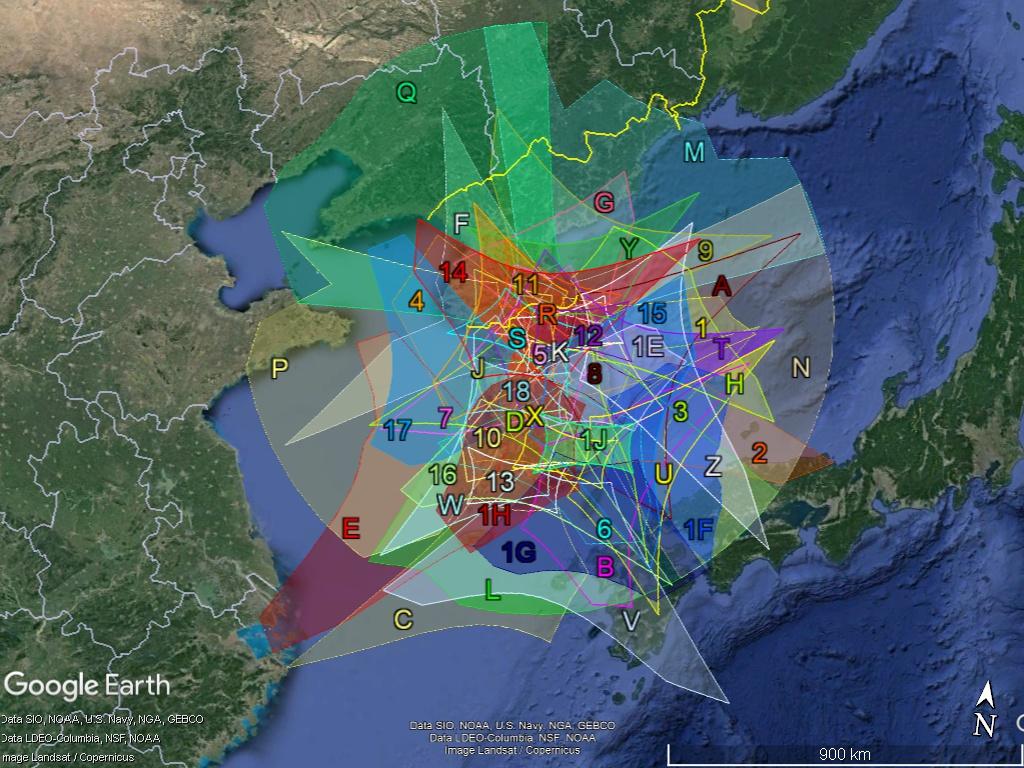
GMN camera fields in 2022 intersected at 100 km elevation, for cameras active in South Korea. The code refers to the camera ID, e.g., E = KR000E.
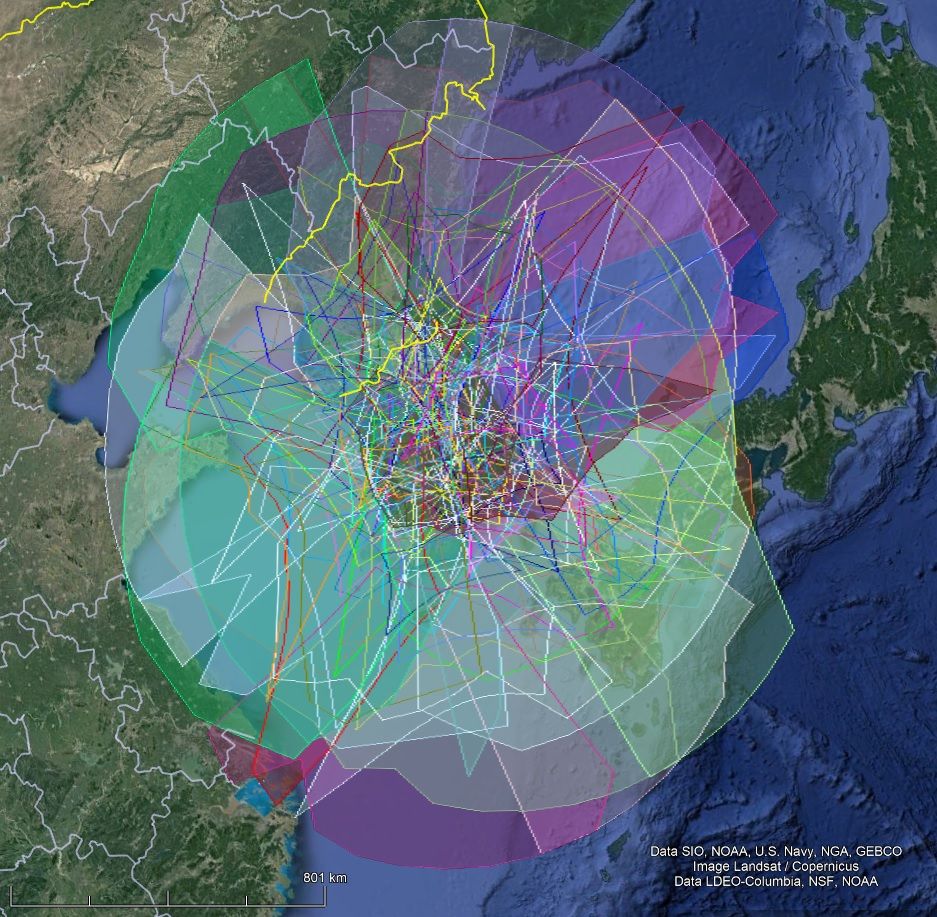
Figure 23 – GMN camera fields in 2022 (top) and in 2023 (bottom) intersected at 100 km elevation, for cameras active in South Korea.
5.19 Luxembourg
In October 2022 a first GMN camera got installed in Luxembourg contributing to 622 orbits combining with Belgian, Dutch, French, German and even Czech GMN cameras (Figure 24). In 2023 this camera had 2018 paired meteors with orbits. This camera covers a strategic volume of atmosphere for Belgian, Dutch, French and German cameras and cannot be missed.
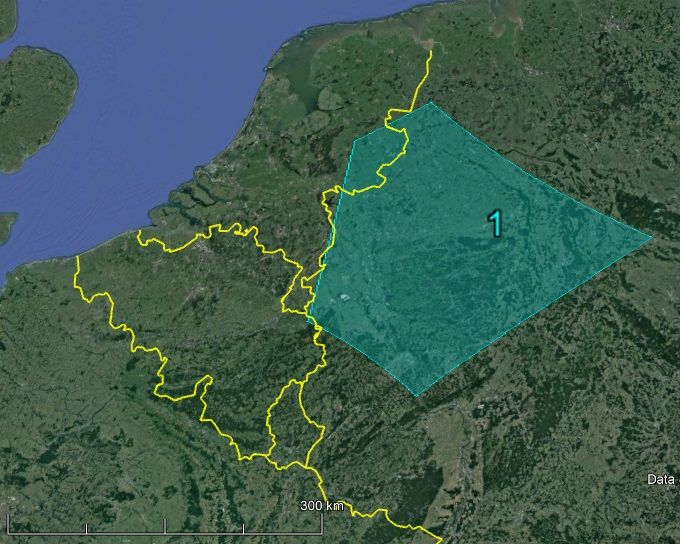
Figure 24 – GMN camera field in 2023 intersected at 100 km elevation, for cameras active in Luxembourg.
5.20 Mexico
An impressive deployment of GMN cameras took place in Mexico in 2022. The first few installed cameras obtained the first orbits in February 2022 and soon 12 cameras got installed with a good overlap. A total of 1769 meteor orbits could be collected in 2022. The number of cameras increased to 15 in 2023 with 2953 orbits as result. The efforts in Mexico are crucial in getting coverage for both the northern and especially the southern hemisphere at these longitudes (Figure 25).
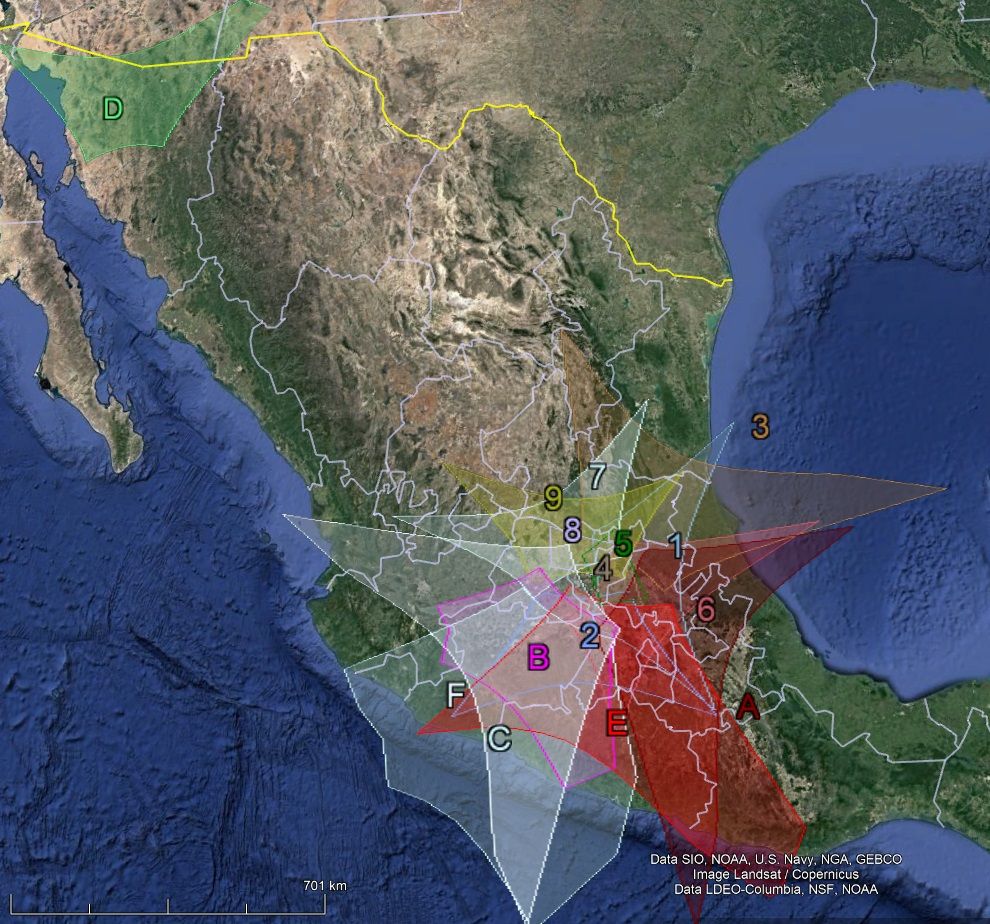
Figure 25 – GMN camera fields in 2023 intersected at 100 km elevation, for cameras active in Mexico.
5.21 Malaysia
A first GMN camera had been installed in Malaysia in 2021 waiting for coverage from cameras installed at a suitable distance to get good triangulations. Some extra cameras got installed in 2022 and in June 2022 the first orbits were obtained. In total 50 orbits were obtained in 2022 with three cameras. In 2023 a ten-fold of orbits, 551, were collected with five cameras (Figure 26). Further extensions of the Malaysian network are very welcome.
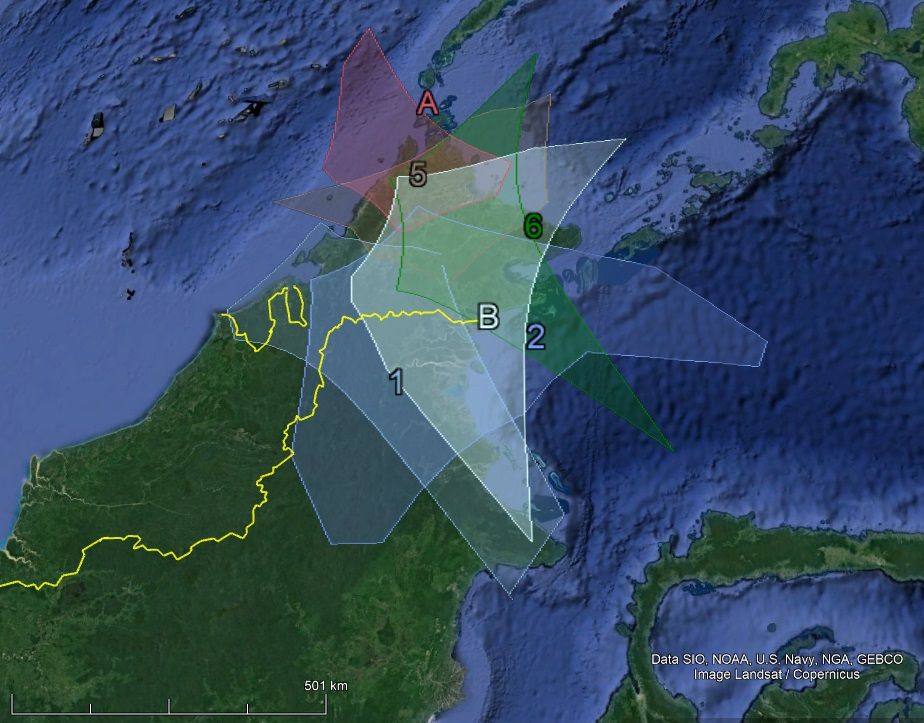
Figure 26 – GMN camera fields in 2023 intersected at 100 km elevation, for cameras active in Malaysia.
5.22 Netherlands
The Netherlands started collecting orbits within GMN in August 2019 and had 278 orbits in its first year. The number of GMN cameras increased to 11 in 2020 with 4337 orbits as a result. The number of cameras remained unchanged in 2021 but the better overlap from neighboring countries resulted in 7605 orbits. Some cameras dropped off in 2022 and few new got installed, resulting in 9139 orbits with 13 cameras. In 2023, 14 Dutch RMS cameras had 9421 orbits (Figure 27). Dutch cameras get mainly multi-station coverage from cameras in Belgium, Germany, the UK and Denmark.
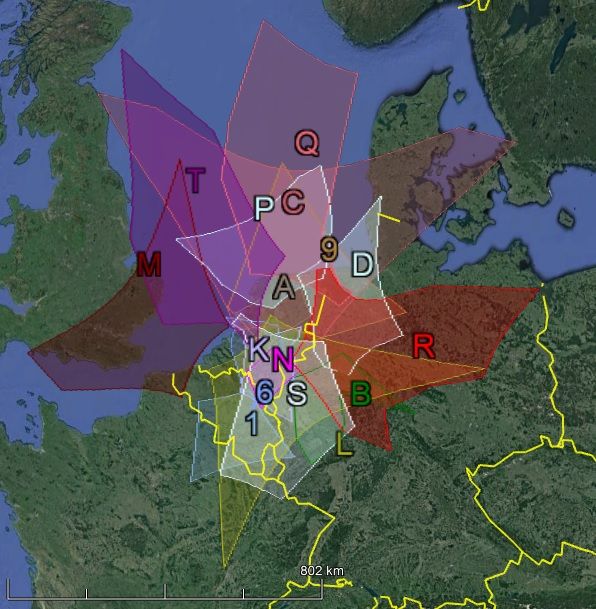
Figure 27 – GMN camera fields in 2023 intersected at 100 km elevation, for cameras active in the Netherlands.
5.23 New Zealand
The first two GMN cameras were installed in July 2021 in New Zealand and 1146 orbits were obtained that year. From March 2022 more cameras were installed month by month with an impressive deployment of strategically placed well pointed cameras covering the huge surface of the country. With 28 active cameras at the end of 2022, 6280 orbits were recorded. The New Zealand GMN network, known as Fireballs Aotearoa, was further expanded in 2023 and with a total of 111 cameras 47436 orbits were obtained, making New Zealand one of the most important providers of orbit data for the Southern Hemisphere. The density of the camera coverage can be seen in Figure 29 and compared to the situation one year earlier. Another 20 or so cameras are in states of install. The network has focused on having all the cameras hosted by members of the public, schools and observatories, and is now linked with the Royal Astronomical Society of New Zealand. Most of the country is now covered at 25 km elevation – assuming the weather is conducive! The monthly captures are now in the 1000s of meteors, with more than 6300 in Jan 2024 whereas only 100–200 per month were detected 1.5 years ago. The network also contributed to optical identification of the Lamda Sculptorids, which is a meteor shower associated with Comet 46P/Wirtanen (Roggemans et al., 2024). There have been a number of impressive asteroidal and cometary fireballs detected and trajectories determined from the camera data, but we await the discovery of any meteorites.
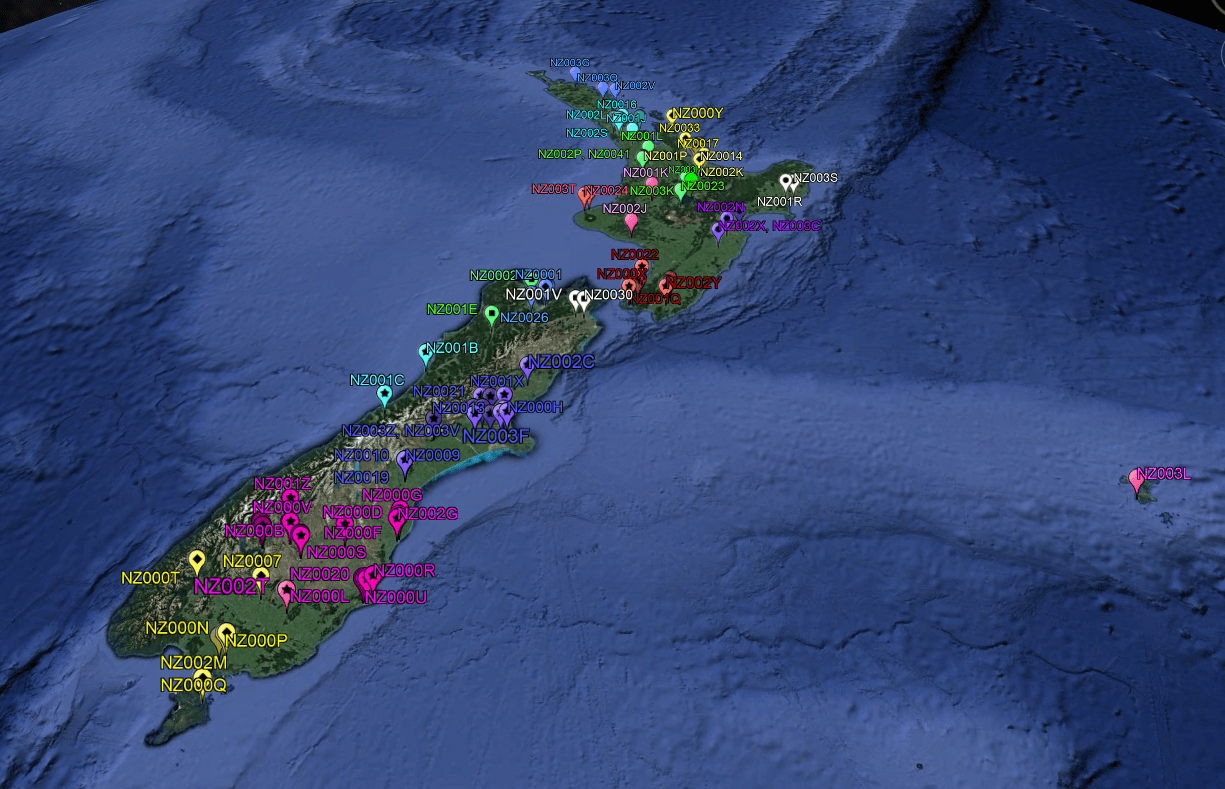
Figure 28 – GMN camera positions in New-Zealand, situation as end of 2023.
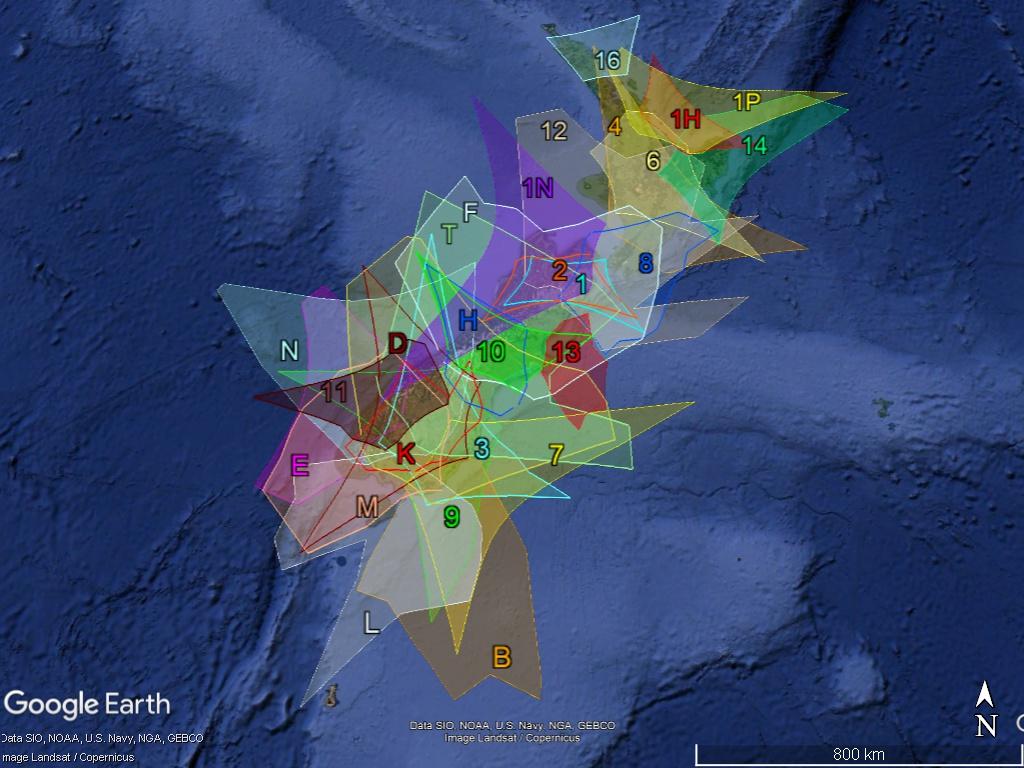
GMN camera fields in 2022 intersected at 100 km elevation, for cameras active in New Zealand. The code refers to the camera ID, e.g., 1P = NZ001P.
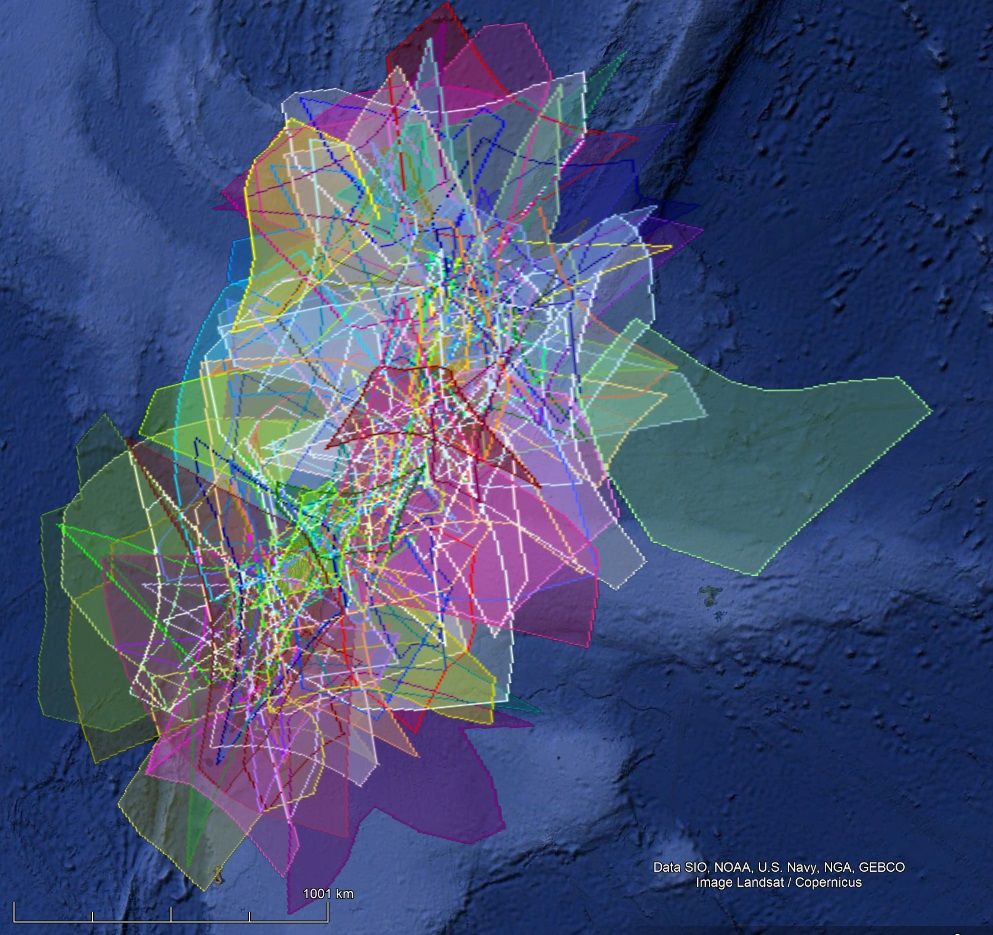
Figure 29 – GMN camera fields in 2022 (top) and in 2023 (bottom) intersected at 100 km elevation, for cameras active in New Zealand.
5.24 Poland
The first GMN camera got installed in September 2020 and remained long the only Polish GMN camera. In March 2022 two extra Polish GMN cameras got their first orbits. The cameras didn’t function all the time but the number of orbits obtained increased from 67 in 2021 to 398 in 2022. The number of cameras remained unchanged in 2023 and collected 456 orbits (Figure 30). Polish GMN cameras get mainly paired meteors with cameras in stalled in Czechia.
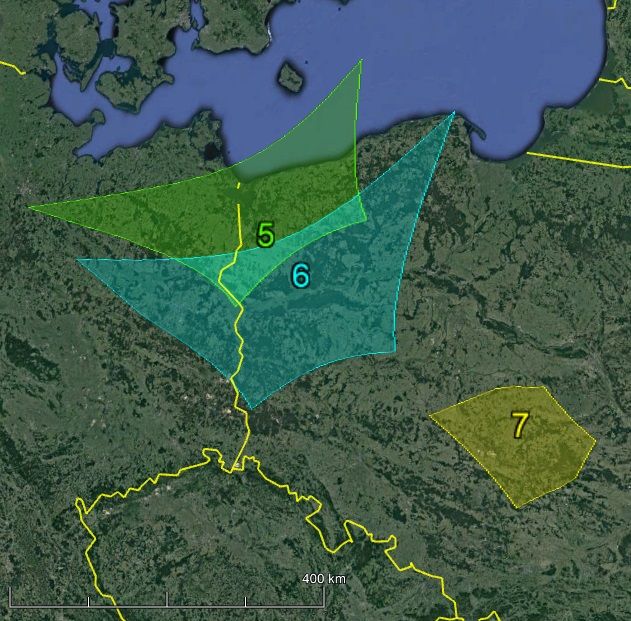
Figure 30 – GMN camera fields in 2023 intersected at 100 km elevation, for cameras active in Poland.
5.25 Portugal
A first GMN camera got its first orbits in September 2022 in Portugal. A vast coverage from GMN cameras in Spain guarantees many paired meteors (Figure 31). In 2022, 398 orbits were recorded, in 2023 the total increased to 3322 orbits. Any extra cameras installed in the western part of the Iberian Peninsula would significantly improve the multi-station coverage.
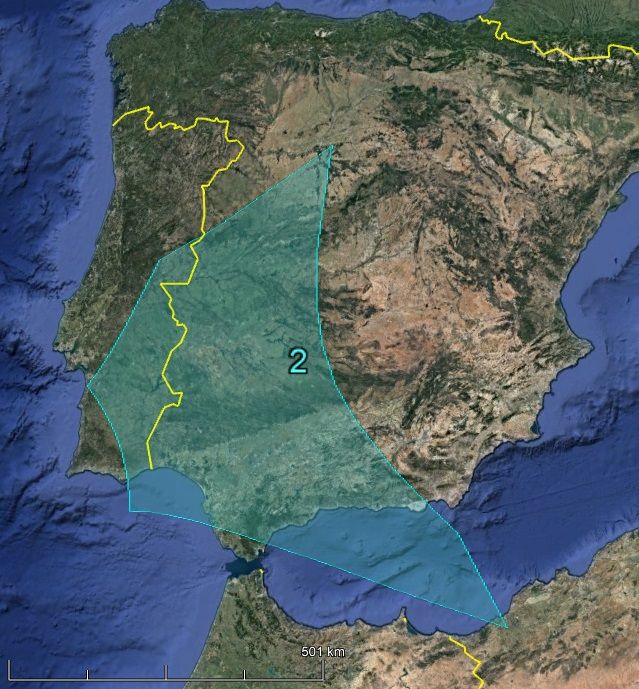
Figure 31 – GMN camera field in 2023 intersected at 100 km elevation, for cameras active in Portugal.
5.26 Romania
Romania was the only new country to install its first three RMS cameras in 2023 (Figure 32). Operational since October 2023 and despite unfavorable weather, 417 orbits were collected. These cameras had many paired meteors with Bulgarian, Croatian, Czech and Hungarian cameras. More cameras are planned for installation in 2024.
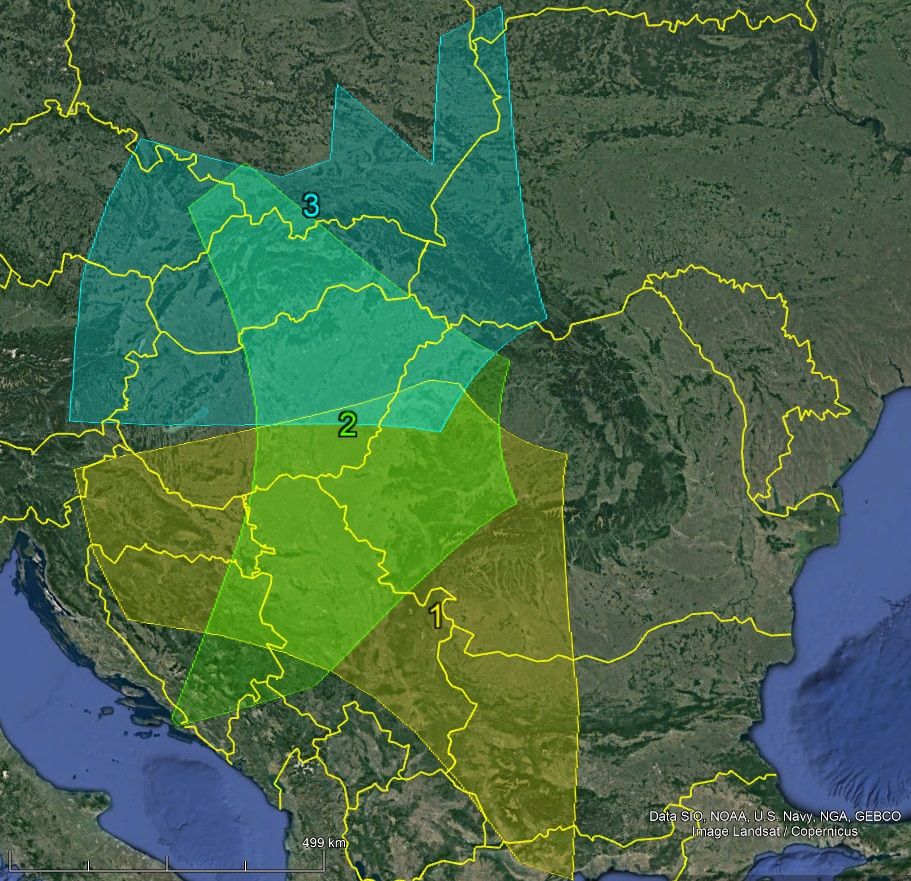
Figure 32 – GMN camera field in 2023 intersected at 100 km elevation, for cameras active in Romania.
5.27 Russia
The first two GMN cameras in Russia had orbits in July 2019. The first year had already 5715 orbits with 10 cameras. In 2020 the number of cameras increased to 21, good for as many as 13438 orbits. The number of RMS cameras having paired meteors remained stable at 21, but the number of orbits decreased to 6208 in 2021. Problems with the maintenance of some meteor stations reduced the number of paired observations. In 2022, 19 cameras in Russia had 5437 orbits. The number of Russian GMN cameras decreased further to 15 in 2023 and the number of paired meteors dropped to 1992. In total 12 of the formerly active cameras stopped contributing data. Some single RMS devices (Figure 33) got installed elsewhere in Russia, waiting for coverage from other RMS cameras at a suitable distance. Some cameras in the far east of Russia stopped uploading data.
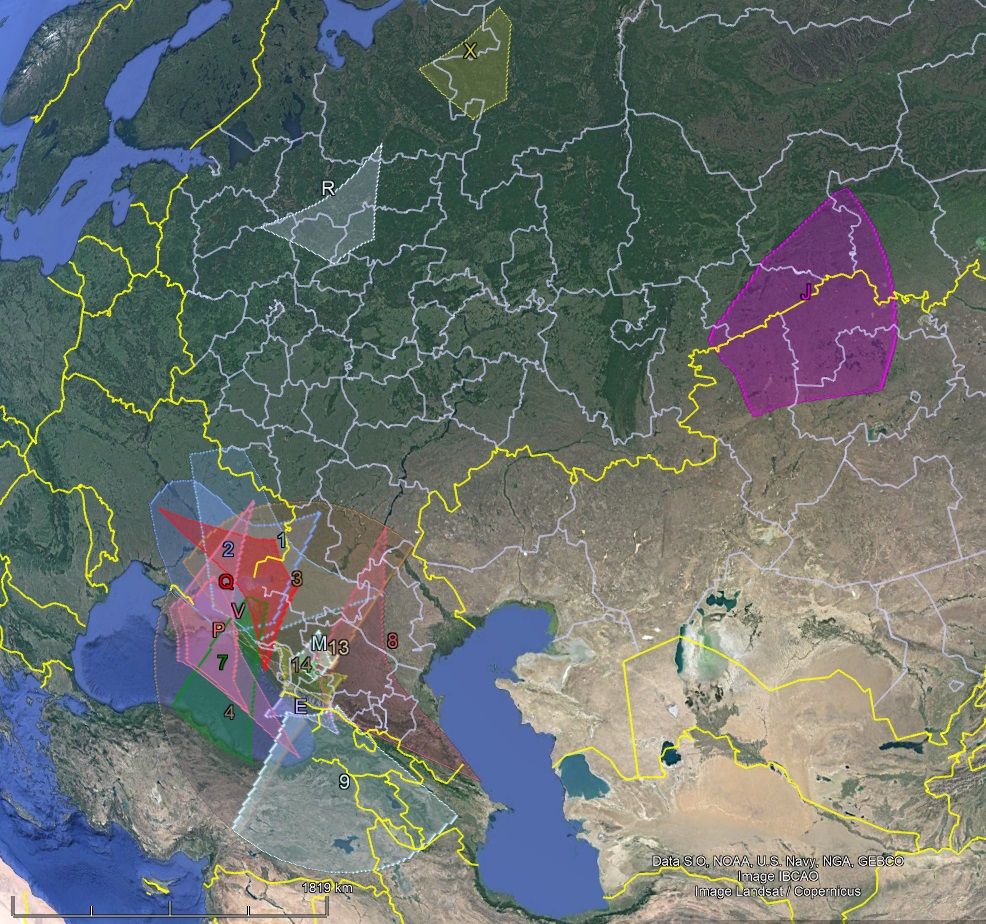
Figure 33 – GMN camera fields in 2023 intersected at 100 km elevation, for cameras active in Russia (West).
5.28 Singapore
A first camera got installed in 2022 and is waiting for multi-station partners, no orbits could be obtained yet in 2023 (Figure 34).
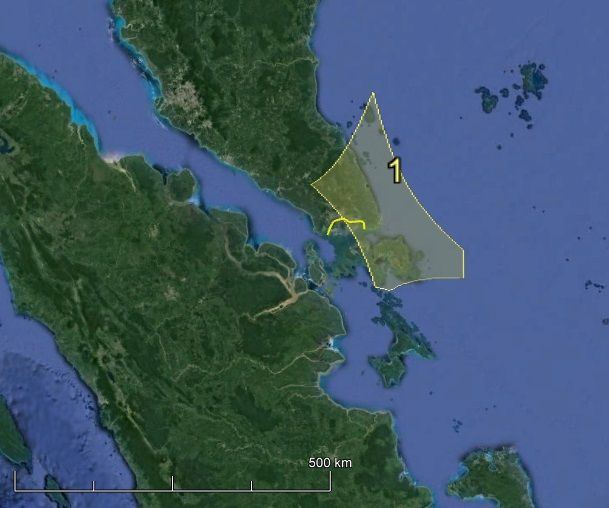
Figure 34 – GMN camera fields in 2023 intersected at 100 km elevation, for cameras active in Singapore.
5.29 Slovakia
Slovakia got its first camera in November 2021 with 37 paired meteors. In 2022, three GMN cameras got operational good for 2026 orbits. The number of cameras increased to four in 2023 and 5535 paired meteors with orbits were recorded by Slovakian cameras (Figure 35). Since the end of 2022, the Czech and Slovak GMN camera operators are grouped in the CSMON (Czech & Slovak Meteor Observation Network), which helps the new and current meteor enthusiasts to get on board.
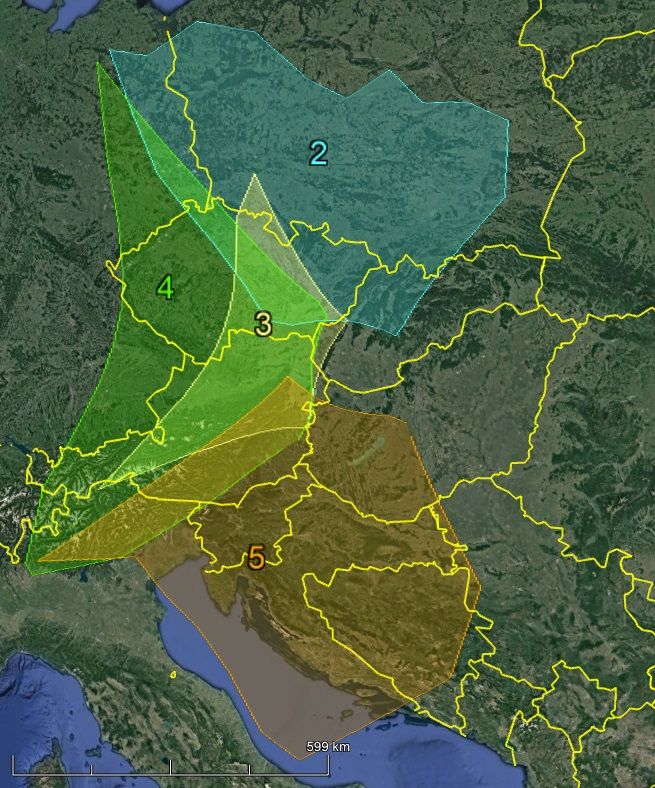
Figure 35 – GMN camera fields in 2023 intersected at 100 km elevation, for cameras active in Slovakia.
5.30 Slovenia
Slovenia got its first RMS contributing in August 2019 and a second RMS in August 2021. The coverage by cameras in neighboring Croatia resulted in 2753 orbits in 2019, 3999 in 2020 and 6001 in 2021. The two Slovenian cameras contributed to 5887 orbits in 2022. In 2023, four extra cameras were installed and 6789 orbits were collected (Figure 36).
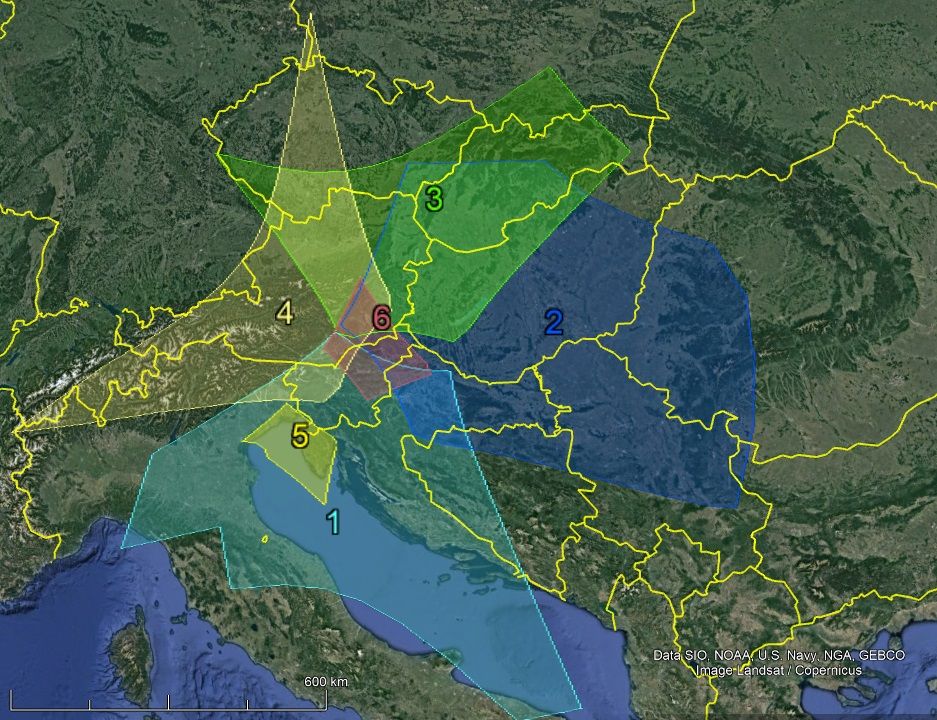
Figure 36 – GMN camera fields in 2023 intersected at 100 km elevation, for cameras active in Slovenia.
5.30 Spain
The GMN had its first orbits collected in Spain in April 2020. End of 2020, eight GMN cameras had collected 1207 orbits. A lot of progress was made in Spain in 2021 when the number of cameras increased from eight to 23. The 23 Spanish cameras were involved in 15113 multi-station events in 2021. The number of GMN cameras increased further to 30 in 2022 and resulted in 19301 orbits. In 2023, 22610 orbits were obtained with 35 cameras (Figure 38). Three cameras are installed at the Canary Islands (Figure 37).
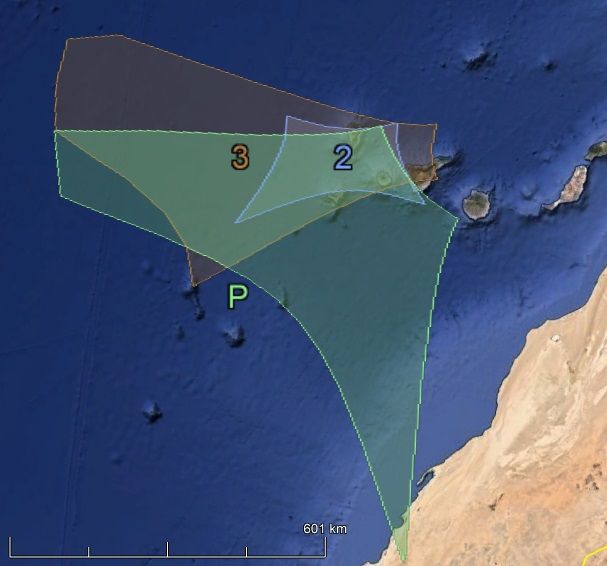
Figure 37 – GMN camera fields in 2023 intersected at 100 km elevation, for cameras active at the Canary Islands (Spain).
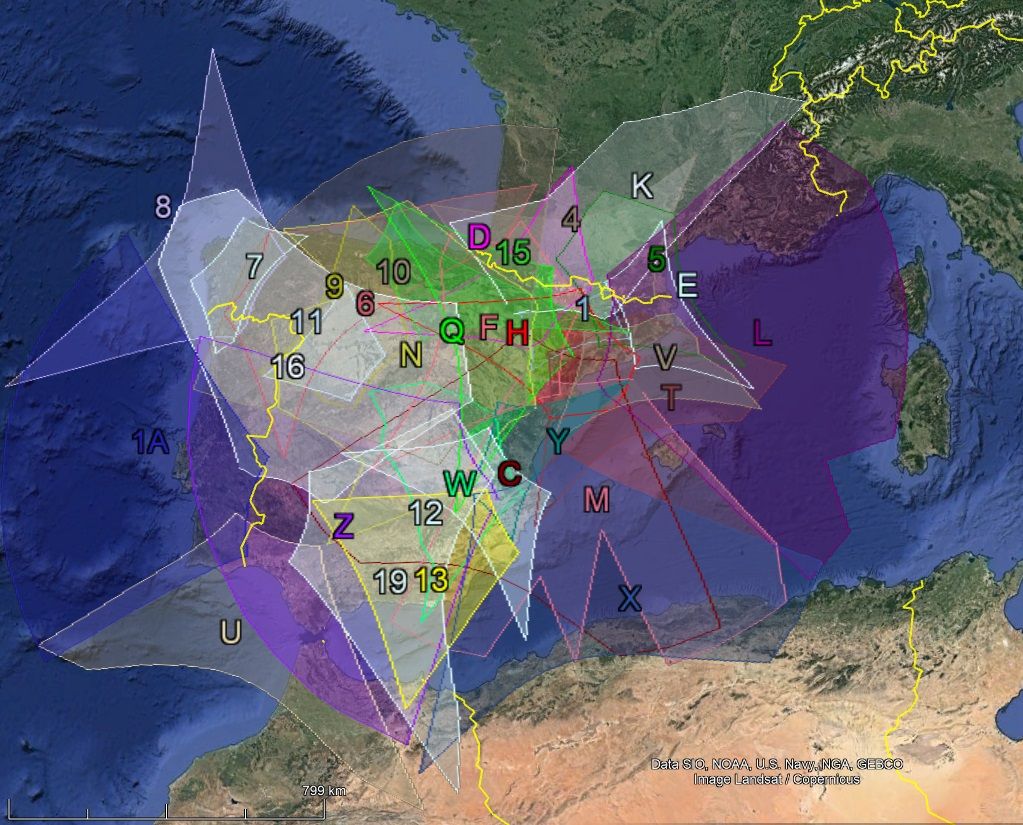
Figure 38 – GMN camera fields in 2023 intersected at 100 km elevation, for cameras active in Spain.
5.31 Switzerland
The first orbits were obtained in August 2021 but it took until May 2022 before extra cameras got installed and more orbits recorded. With five operational cameras 3439 orbits were obtained. The central location of Switzerland is ideal to obtain multi-station events with GMN cameras in the neighboring countries. The number of cameras remained unchanged in 2023 and the number of paired meteors increased to 4352 (Figure 39).
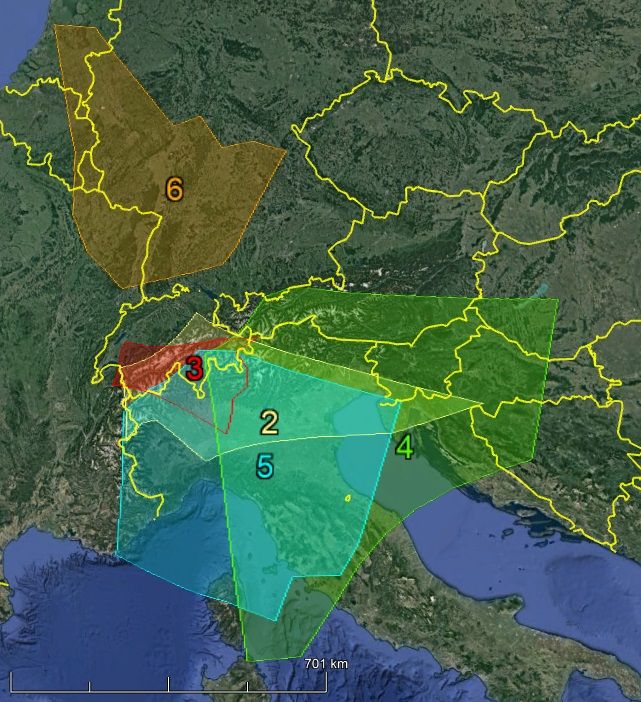
Figure 39 – GMN camera fields in 2023 intersected at 100 km elevation, for cameras active in Switzerland.
5.32 Ukraine
A first RMS camera contributes meteor data to Global Meteor Network in Ukraine, but so far, no paired meteors were recorded (Figure 40).
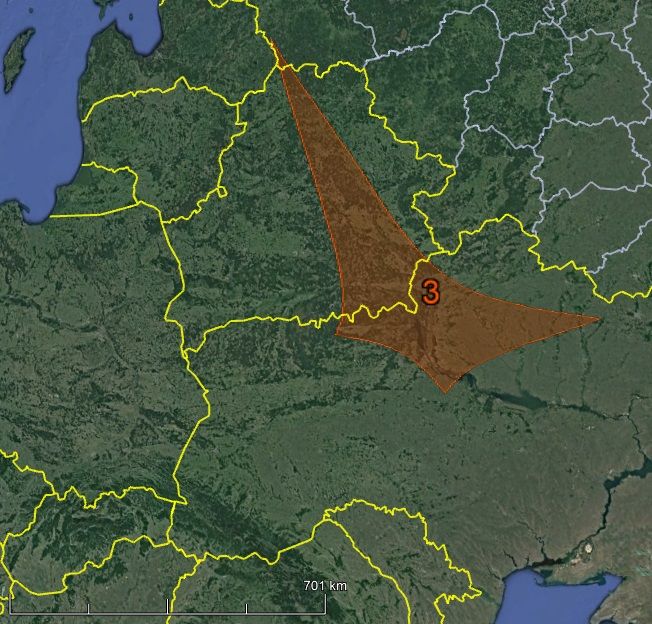
Figure 40 – GMN camera fields in 2023 intersected at 100 km elevation, for cameras active in Ukraine.
5.32 United Kingdom
The GMN got started with 13 cameras in 2020 in the UK and this number rapidly grew to 97 in 2021. The largest expansion came in 2022 when 169 cameras were contributing paired meteors. The network continued to grow throughout 2023 when 261 cameras contributed data (Figure 41). The number of orbits increased from 78652 in 2022 to 84688 orbits in 2023. The vast majority of these cameras are part of the UK Meteor Network which now provides complete coverage of the UK and Eire.
Cameras
Camera growth was similar to in 2023, rising from around 170 in January to 261 by year end. 224 of these are contributing to the UK Meteor Network and fourteen cameras dropped offline permanently during the year, typically due to changes in the owner’s interests or relocations, though sadly in one case, due to the death of the operator.
In terms of coverage, the UK is now extremely densely covered, with many locations visible to as many as 40 cameras and at 70km altitude the entire of the UK and Eire is covered by at least two cameras, with coverage at 100km extending as far as Norway, Central France and Southern Germany. There is considerable overlap with the BeNeLux network, and potential for overlap with cameras across Europe.
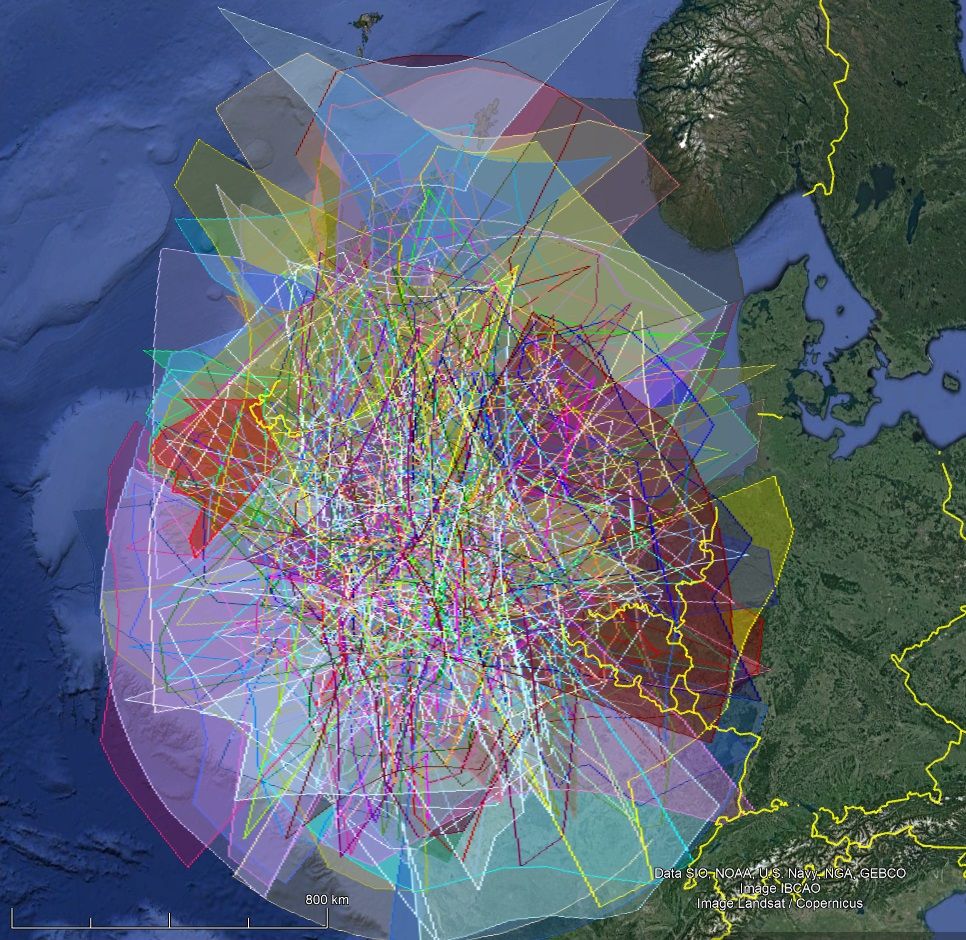
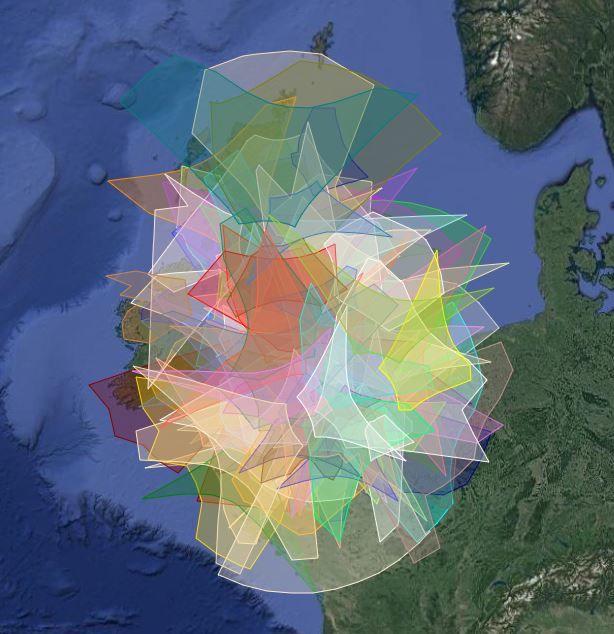
Figure 41 – GMN camera fields in 2023 intersected at 100 km elevation (top), and at 70 km elevation (bottom) for cameras active in the United Kingdom.
Detections and matches
GMN records that UK cameras made around a million single-station detections. This is less than in 2022 however the reduction reflects improvements in RMS’s ability to reject non-meteoric events and is a positive step.
These data contributed to 84688 orbit solutions in the GMN database (the UK Meteor Network, using the same solver but slightly different criteria, recorded 99600 orbits).
Matches were made as far afield as Norway, Germany and France, and on average, each detection involved five cameras, although some detections involved thirty or more cameras and one detection was picked up by 39 cameras.
On the other hand, RMS does occasionally miss earth-grazing and fireball meteors. This highlights the importance of engaging with the camera operators to encourage manual review of their data, whether via the GMN weblog or the UK Meteor Network’s live-stream. Several fireballs were spotted by team members or even members of the public who were reviewing these sources and notified us of interesting events. The introduction of the GMN EventViewer tool has proved invaluable in this respect, allowing us to collect data on several fireballs that might otherwise have been missed.
The most interesting event of the year was the detection of 2023CX1, an asteroid that was detected by telescopic observers shortly before entering the atmosphere, and went on to deposit meteorites in Northern France. Several UK cameras detected this bolide, although it was so bright that some cameras were washed out and only three could be used in a solution.
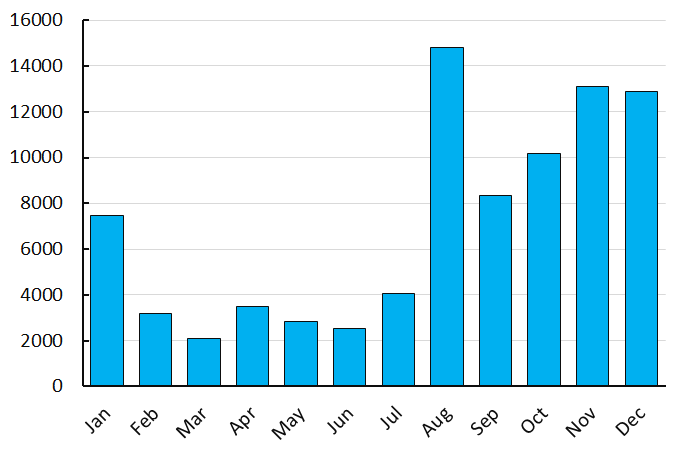
Figure 42 – UK matches in 2023 per month.
Showers
26466 shower meteors were measured in 2023. As in previous years the Perseid and Geminid showers dominate though the other autumn showers are well represented too. The top ten showers are shown in the table below.
Table 2 – Number of meteor shower matches in the UK.
| Shower | UK Matches |
| PER | 5393 |
| GEM | 4563 |
| ORI | 2033 |
| STA | 636 |
| LEO | 600 |
| NTA | 524 |
| HYD | 480 |
| COM | 359 |
| QUA | 298 |
| LYR | 206 |
Fireballs
UK cameras were involved in detection of 43 fireball meteors, the brightest of which was measured at magnitude –11 and occurred on the 30th of December, in addition to asteroid 2023CX1 which was recorded at magnitude –9. Five or six other fireballs may have dropped meteorites however most of these were over water or terrain that was too difficult to search, such as Dartmoor.
Looking Forward
Growth has slowed considerably, although several new cameras have been commissioned in the first three weeks of January 2024, and nearly 10,000 matched events have been recorded.
5.33 United States
The American New Mexico Meteor Array was the pioneering network of the GMN as it started to harvest meteors in December 2018 with six cameras, producing the first 497 orbits for GMN. It remained the only data provider for GMN until May 2019 when the first 3 Croatian cameras started to deliver orbits. At the end of 2019, the number of US cameras had increased to 20 when the network collected 27643 orbits that year. In 2020, the 33 operational cameras in the US collected as many as 50607 orbits. With 72 RMS cameras registering paired meteors in the US, a total of 91901 orbits were obtained in 2021.
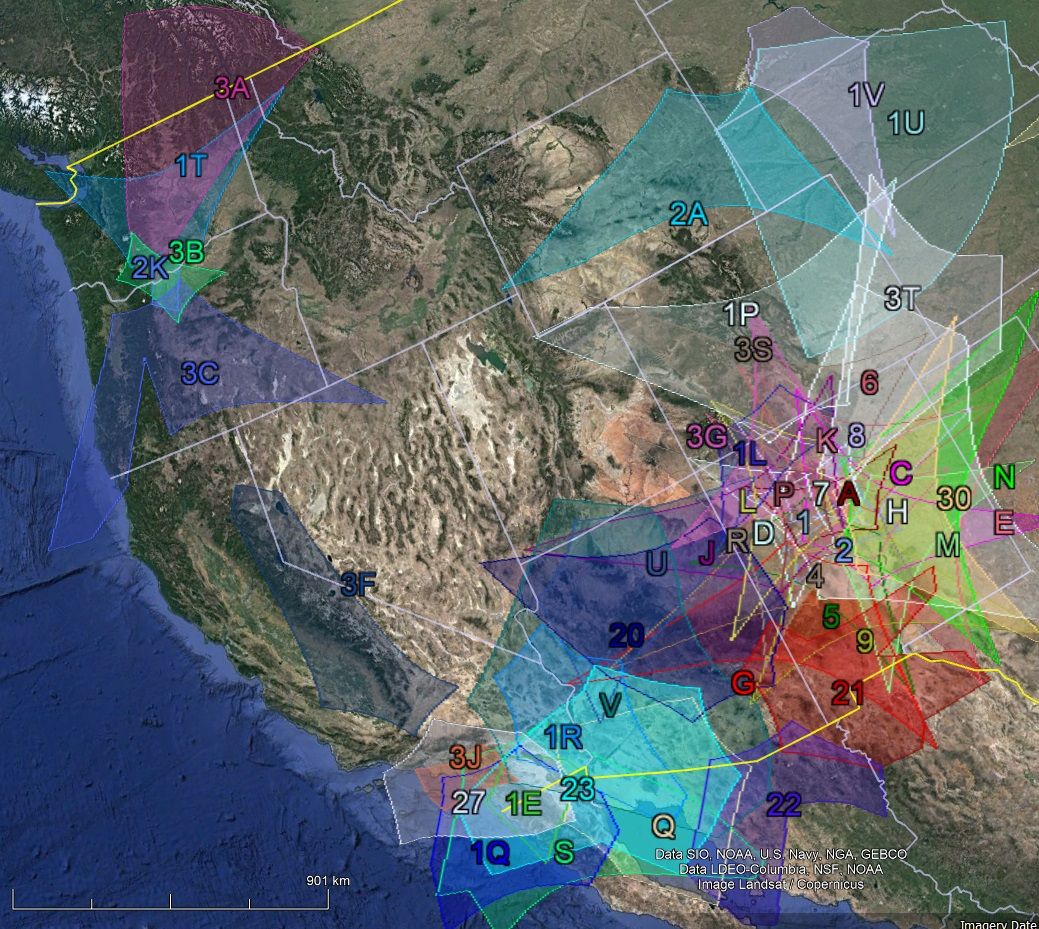
Figure 43 – GMN camera fields in 2023 intersected at 100 km elevation, for cameras in the western part of the USA.
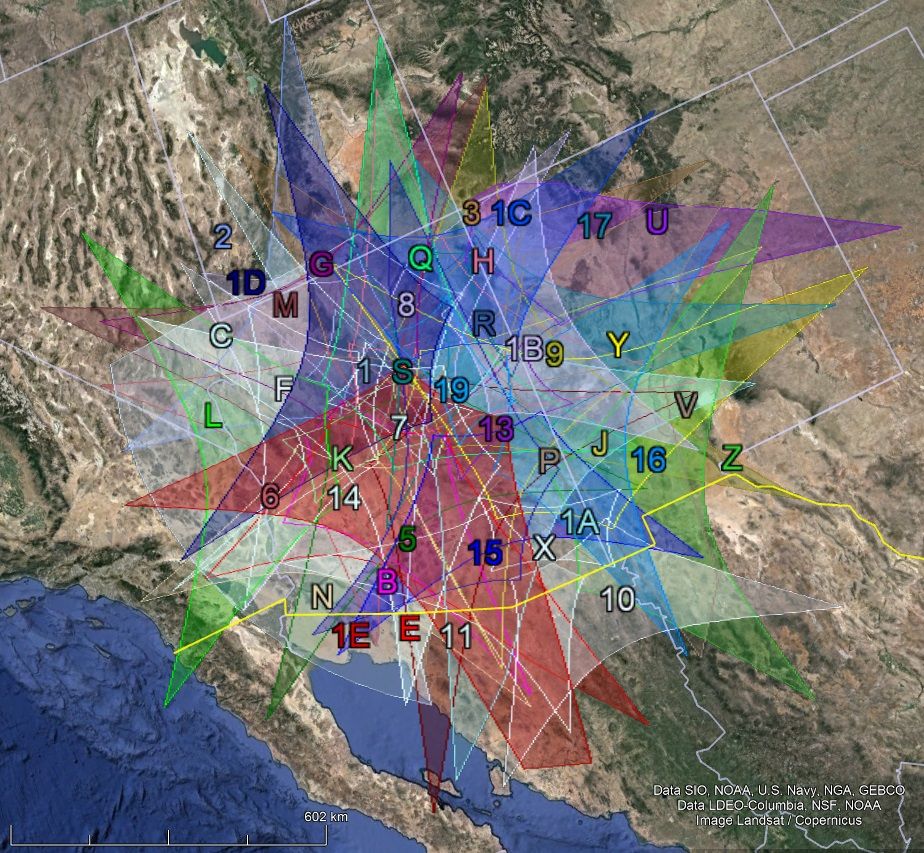
Figure 44 – GMN camera fields in 2023 intersected at 100 km elevation, for cameras of the Lowell Observatory in Arizona.
The number of GMN cameras involved in orbit determinations had increased to 100 in 2022, good for 114054 orbits. 2023 saw a further increase in cameras resulting in 120162 orbits.
Figure 45 shows the GMN status like it was at the end of 2023 with 128 GMN cameras in the US, most of which belong to the New Mexico Camera Array and the Lowell Observatory in Arizona. Both networks are independent in neighboring states but have a large overlap. Figure 44 shows the situation for the Lowell network in Arizona. The Lowell Observatory cameras also benefit coverage from other GMN cameras in the state as well as in California (Figure 43).
GMN camera networks are emerging at several other sites in the US (Figure 45). The network reaches till Alaska at 65° northern latitude. Several cameras installed near the East Coast, south of the Canadian border connect to the existing GMN network in Canada (Figure 46). The maps show where cameras in the US still wait for multi-station partners to set up cameras (Figure 47). Details are given in Tables 5 and 6 for the Lowell network (USL), NASA network (USN) and USV network.
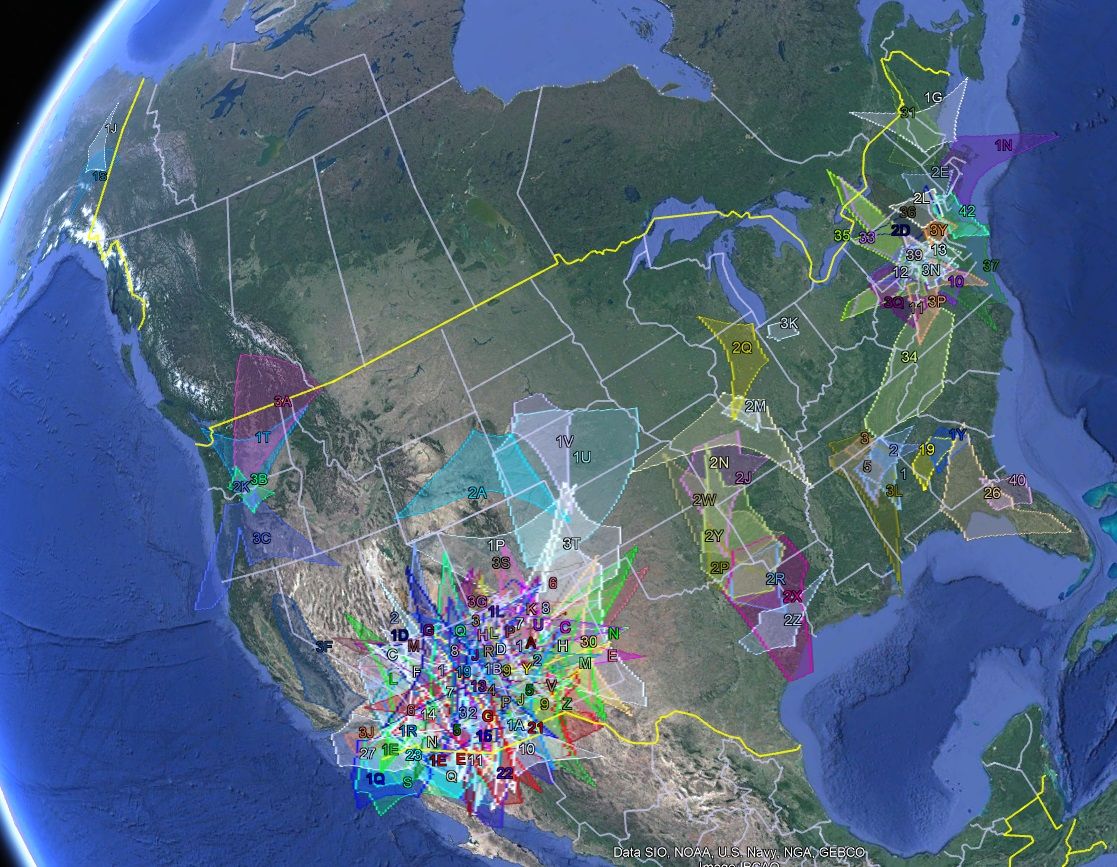
Figure 45 – GMN camera fields intersected at 100 km elevation, global view for cameras installed in the USA, status 2023.
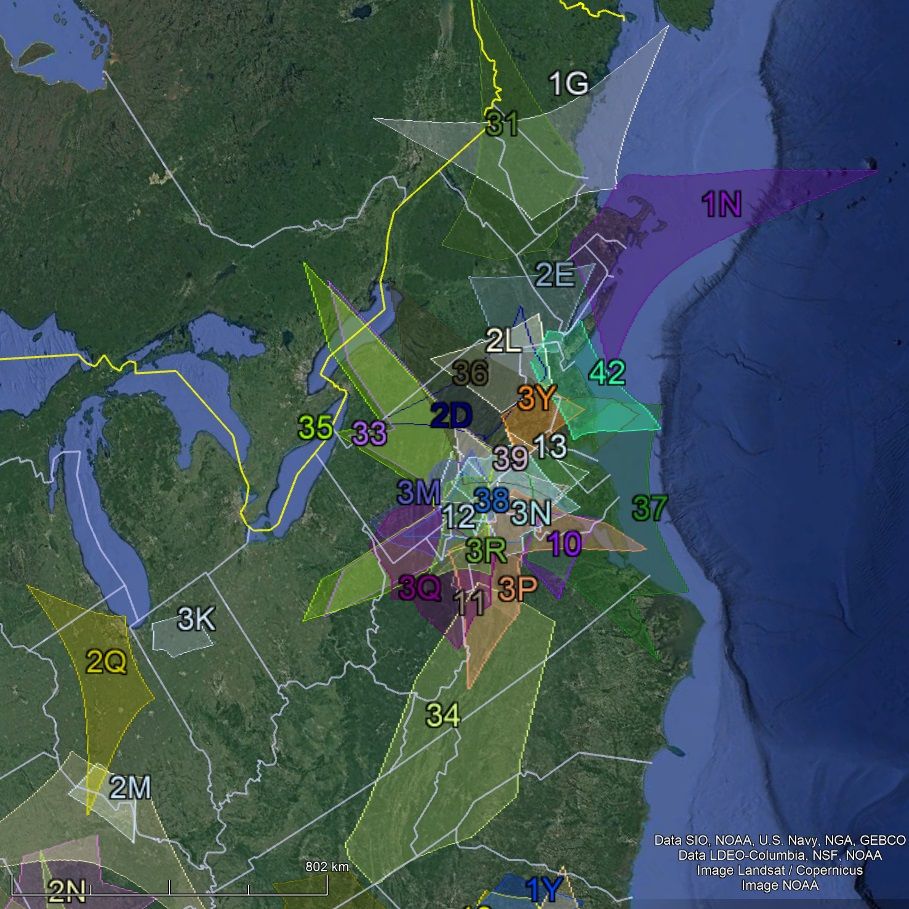
Figure 46 – GMN camera fields in 2023 intersected at 100 km elevation, for cameras in the north-eastern part of the USA.
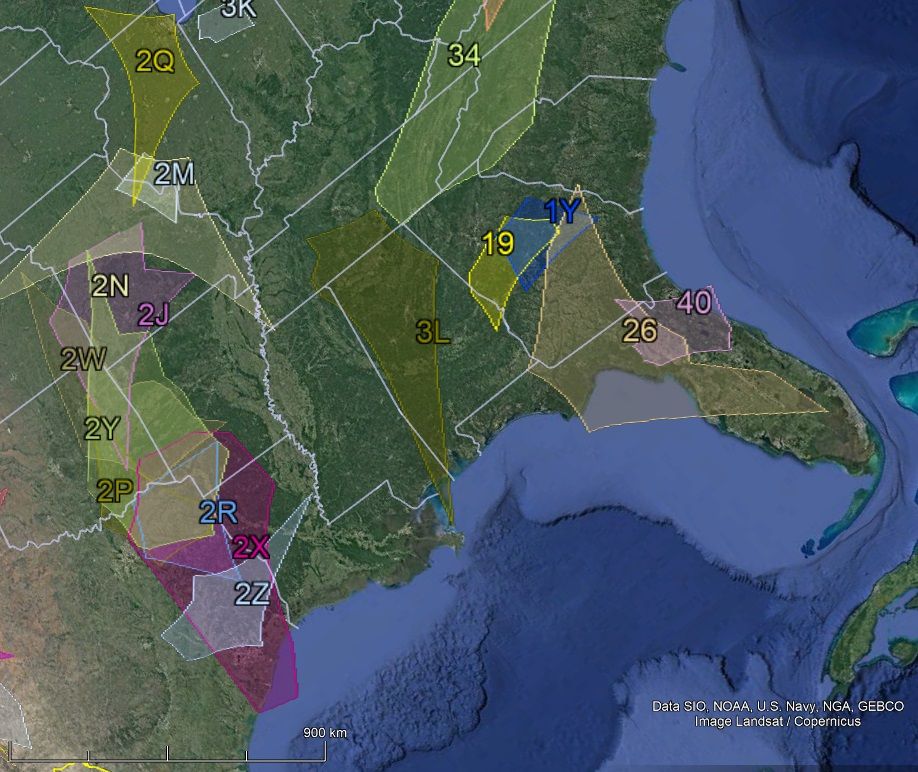
Figure 47 – GMN camera fields in 2023 intersected at 100 km elevation, for cameras in the south-eastern and central parts of the USA.
5.34 South Africa
The first two GMN cameras got installed end of 2022 but no paired meteors were obtained then. In 2023 the number of cameras increased to four and the first 200 orbits were obtained in South Africa (Figure 48).
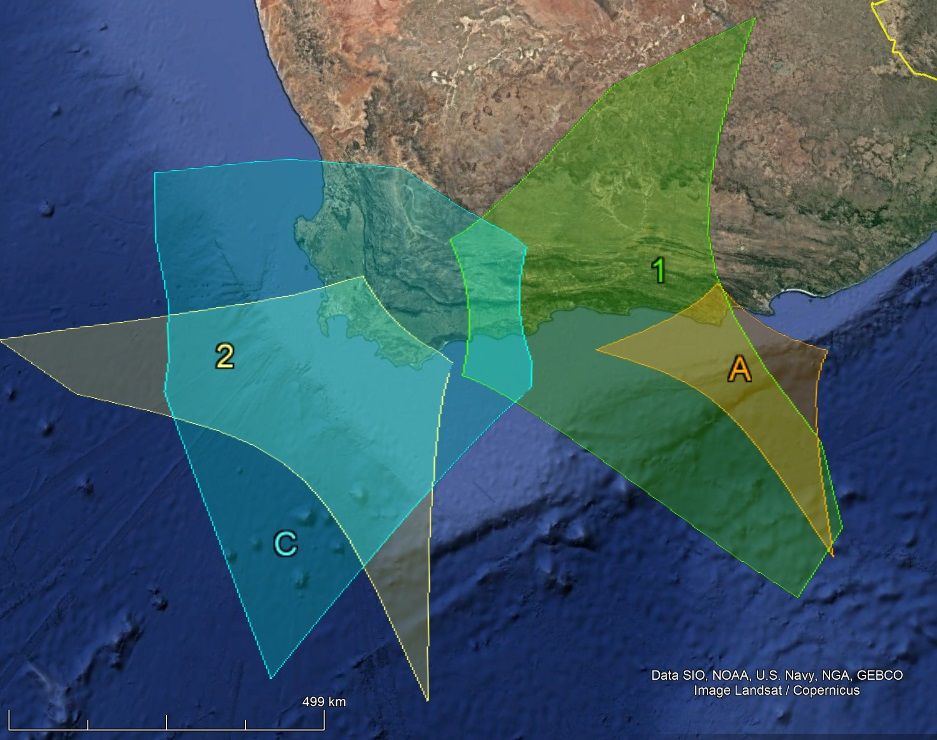
Figure 48 – GMN camera fields in 2023 intersected at 100 km elevation, for cameras active in South Africa.
6 GMN statistics 2023
When a first GMN status report got published, including all data until end October 2020, 140 operational cameras were involved and 144950 orbits had been collected (Roggemans, 2021). Meanwhile, we can compare five years of GMN work. Figure 49 shows the accumulated number of orbits obtained and the number of contributing cameras during each calendar month. The rapid growth of the Global Meteor Network is obvious. The number of cameras involved in collecting orbits for GMN increased from 390 in 2021 to 700 in 2022 and 1066 at the end of 2023.
Table 3 shows that less than 30% of all orbits are collected during the first six months of each year, while more than 70% is obtained in the period July to December. The fast expansion of the Global Meteor Network also means that more cameras were available towards the end of each year than at the beginning of each year, what also influenced the number of orbits obtained. The most important cause for the difference in number of orbits between the first and last six months is the meteor activity itself. Apart from the most active major meteor showers like the Perseids, Taurids, Orionids, Leonids and Geminids, the overall meteor activity is much higher during the second half of the year. This can be seen very well in Figure 49 where the blue curve has a much steeper increase each second half of the year.
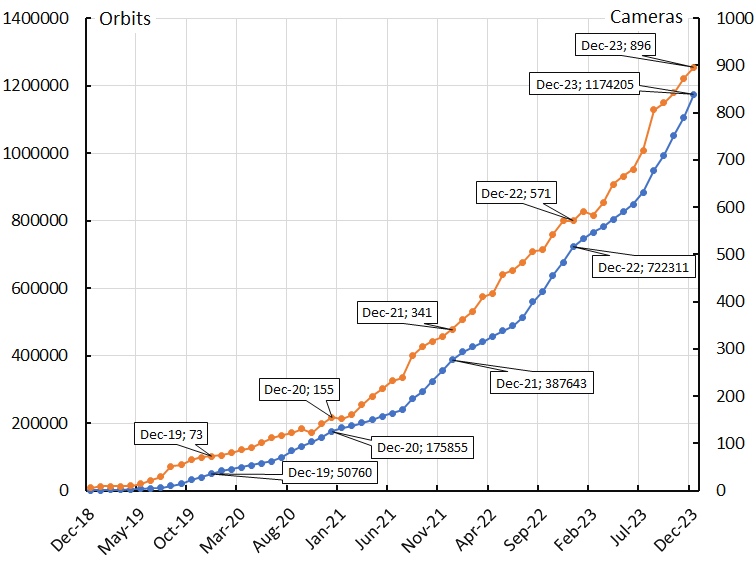
Figure 49 – The accumulated number of orbits (blue) and the actual number of operational cameras involved in triangulations (orange). The numbers at the end of each year are indicated.
Although 1066 different cameras contributed paired meteors during 2023, only 896 or 84% were successfully contributing during December. The explanation is that this report is based on the camera IDs which occur in the orbit dataset and thus successfully recorded paired meteors. Apart from the 896 successful cameras in December there were also a number of cameras functioning without having any paired meteors and thus not listed in the orbit dataset. Persistent unfavorable weather conditions sometimes prevent some cameras from getting paired meteors. A number of cameras struggled with technical issues. For instance, if a camera somehow is moved and has no calibration, no trajectories can be calculated.
Occasionally some hardware or network problem occur, if the connection with the camera board gets lost, the system may ping its camera unsuccessfully until the camera owner fixes the problem. Another hardware problem that is reported now and then is when the sd card crashes and needs replacement.
To prevent loss of valuable observing data, it is strongly recommended to look regularly at the camera status page to check if all cameras report correctly to GMN.
In 2023, 430 new camera IDs contributed paired meteors to GMN, in total 1155 different camera IDs are listed in the orbit dataset, 89 of these camera IDs did not contribute to orbits in 2023, 25 of which didn’t appear in the 2022 orbit data. Table 6 lists the number of cameras active per country for each year since 2018. The number of camera IDs that contributed no camera data in 2023 has been also listed per country. In some cases, old devices were replaced by new, in other cases the camera owner somehow was unable to solve technical issues, had lack of time or lost interest. We know of at least two participants who have died. One whose camera continued transmitting data until vegetation obstructed the camera field of view and the family switched off the system.
Table 3 – Total number of orbits obtained by the Global Meteor Network cameras per calendar month for each year.
| 2018 | 2019 | 2020 | 2021 | 2022 | 2023 | Tot | |
| January | – | 564 | 7539 | 9919 | 23727 | 23972 | 65721 |
| February | – | 1284 | 5330 | 6529 | 14910 | 18602 | 46655 |
| March | – | 537 | 5101 | 8767 | 15409 | 16310 | 46124 |
| April | – | 876 | 7213 | 9655 | 15658 | 22713 | 56115 |
| May | – | 1242 | 5654 | 10217 | 16951 | 22050 | 56114 |
| June | – | 1523 | 5700 | 7954 | 13463 | 23125 | 51765 |
| July | – | 1961 | 10973 | 11325 | 25226 | 35109 | 84594 |
| August | – | 5387 | 19422 | 31292 | 47300 | 65155 | 168556 |
| September | – | 6058 | 14012 | 21189 | 29984 | 44174 | 115417 |
| October | – | 11978 | 13097 | 31501 | 48360 | 59134 | 164070 |
| November | – | 7710 | 13228 | 30381 | 37895 | 54030 | 143244 |
| December | 497 | 11143 | 17826 | 33059 | 45785 | 67520 | 175830 |
| Totals | 497 | 50263 | 125095 | 211788 | 334668 | 451894 | 1174205 |
Table 4 – Total number of operational cameras within the Global Meteor Network per calendar month.
| 2018 | 2019 | 2020 | 2021 | 2022 | 2023 | Tot | |
| January | – | 9 | 75 | 152 | 363 | 591 | 670 |
| February | – | 9 | 80 | 161 | 380 | 583 | 680 |
| March | – | 9 | 86 | 182 | 410 | 609 | 719 |
| April | – | 10 | 91 | 200 | 418 | 648 | 766 |
| May | – | 15 | 101 | 216 | 458 | 665 | 807 |
| June | – | 22 | 112 | 232 | 466 | 680 | 834 |
| July | – | 29 | 117 | 239 | 483 | 720 | 874 |
| August | – | 52 | 122 | 285 | 507 | 806 | 941 |
| September | – | 55 | 131 | 304 | 510 | 821 | 980 |
| October | – | 65 | 122 | 316 | 542 | 842 | 1004 |
| November | – | 71 | 142 | 326 | 571 | 873 | 1032 |
| December | 6 | 73 | 155 | 341 | 571 | 896 | 1067 |
| Totals | 6 | 76 | 173 | 390 | 700 | 1066 | 1155 |
Table 5 – Total number of multi-station events contributing to an orbit result, recorded in each country for each year. The list is sorted on the country ID used in the camera ID. Subnetworks for some countries are counted in the grand total for the country.
| 2018 | 2019 | 2020 | 2021 | 2022 | 2023 | Total | |
| Australia (AU) | 0 | 0 | 0 | 1871 | 12460 | 41887 | 56218 |
| Belgium (BE) | 0 | 921 | 5500 | 8582 | 23174 | 25720 | 63897 |
| Bulgaria (BG) | 0 | 0 | 0 | 419 | 3877 | 3530 | 7826 |
| Brazil (BR) | 0 | 0 | 40 | 1645 | 2760 | 2331 | 6776 |
| Canada (CA) | 0 | 3599 | 10815 | 8809 | 16232 | 15023 | 54478 |
| Canada (CAWE) | 0 | 0 | 0 | 0 | 459 | 425 | 884 |
| Canada (CAWT) | 0 | 0 | 0 | 0 | 0 | 193 | 193 |
| Switzerland (CH) | 0 | 0 | 0 | 3 | 3439 | 4352 | 7794 |
| Czech Republic (CZ) | 0 | 0 | 163 | 464 | 2490 | 11269 | 14386 |
| Germany (DE) | 0 | 200 | 3963 | 7009 | 9128 | 12194 | 32494 |
| Denmark (DK) | 0 | 0 | 0 | 0 | 55 | 1386 | 1441 |
| Spain (ES) | 0 | 0 | 1207 | 15113 | 19301 | 22610 | 58231 |
| Finland (FI) | 0 | 0 | 0 | 0 | 41 | 90 | 131 |
| France (FR) | 0 | 0 | 3176 | 5601 | 11990 | 16682 | 37449 |
| Greece (GR) | 0 | 0 | 0 | 0 | 977 | 3375 | 4352 |
| Croatia (HR) | 0 | 12221 | 35099 | 38370 | 31329 | 27721 | 144740 |
| Hungary (HU) | 0 | 0 | 0 | 0 | 2114 | 7872 | 9986 |
| Ireland (IE) | 0 | 0 | 120 | 424 | 3490 | 1954 | 5988 |
| Israel (IL) | 0 | 0 | 553 | 2009 | 975 | 1096 | 4633 |
| Italy (IT) | 0 | 862 | 5384 | 5447 | 4943 | 5064 | 21700 |
| Japan (JP) | 0 | 0 | 0 | 0 | 0 | 629 | 629 |
| South Korea (KR) | 0 | 0 | 0 | 0 | 7711 | 34044 | 41755 |
| Luxembourg (LU) | 0 | 0 | 0 | 0 | 622 | 2018 | 2640 |
| Mexico (MX) | 0 | 0 | 0 | 0 | 1769 | 2953 | 4722 |
| Malasia (MY) | 0 | 0 | 0 | 0 | 50 | 501 | 551 |
| Netherlands (NL) | 0 | 278 | 4337 | 7605 | 9139 | 9421 | 30780 |
| New Zealand (NZ) | 0 | 0 | 0 | 1146 | 6280 | 47436 | 54862 |
| Poland (PL) | 0 | 0 | 35 | 67 | 398 | 456 | 956 |
| Portugal (PT) | 0 | 0 | 0 | 0 | 327 | 3322 | 3649 |
| Romania (RO) | 0 | 0 | 0 | 0 | 0 | 417 | 417 |
| Russia (RU) | 0 | 5715 | 13438 | 6208 | 5437 | 1992 | 32790 |
| Slovenia (SI) | 0 | 2753 | 3999 | 6001 | 5887 | 6789 | 25429 |
| Slovakia (SK) | 0 | 0 | 0 | 37 | 2026 | 5535 | 7598 |
| United Kingdom (UK) | 0 | 0 | 1889 | 27430 | 78652 | 84688 | 192659 |
| USA (US) | 497 | 27643 | 50607 | 91901 | 114054 | 120162 | 404864 |
| USA (USL) | 0 | 0 | 2149 | 51425 | 79647 | 64903 | 198124 |
| USA (USN) | 0 | 0 | 0 | 0 | 0 | 640 | 640 |
| USA (USV) | 0 | 0 | 0 | 0 | 3431 | 2099 | 5530 |
| Erroneous entry (XX) | 0 | 0 | 0 | 8 | 28 | 0 | 36 |
| South Africa (ZA) | 0 | 0 | 0 | 0 | 0 | 200 | 200 |
Table 6 – Total number of operational cameras in each country for each year. Inactive devices and cameras without orbits are not counted. The list is sorted on the country ID used in the camera ID. Subnetworks for some countries are counted in the grand total for the country. The column 2023 (0) lists the number of cameras which had paired meteors before 2023 but did not appear in the 2023 data.
| 2018 | 2019 | 2020 | 2021 | 2022 | 2023 | 2023 (0) | Total | |
| Australia (AU) | 0 | 0 | 0 | 12 | 29 | 67 | 3 | 70 |
| Belgium (BE) | 0 | 4 | 4 | 10 | 20 | 24 | 1 | 25 |
| Bulgaria (BG) | 0 | 0 | 0 | 2 | 6 | 7 | 2 | 9 |
| Brazil (BR) | 0 | 0 | 2 | 13 | 20 | 34 | 1 | 35 |
| Canada (CA) | 0 | 11 | 18 | 29 | 58 | 67 | 16 | 83 |
| Canada (CAWE) | 0 | 0 | 0 | 0 | 7 | 8 | 0 | 8 |
| Canada (CAWT) | 0 | 0 | 0 | 0 | 0 | 8 | 0 | 8 |
| Switzerland (CH) | 0 | 0 | 0 | 1 | 5 | 5 | 0 | 5 |
| Czech Republic (CZ) | 0 | 0 | 3 | 4 | 6 | 20 | 0 | 20 |
| Germany (DE) | 0 | 4 | 10 | 12 | 18 | 19 | 3 | 22 |
| Denmark (DK) | 0 | 0 | 0 | 0 | 1 | 4 | 0 | 4 |
| Spain (ES) | 0 | 0 | 8 | 23 | 30 | 35 | 1 | 36 |
| Finland (FI) | 0 | 0 | 0 | 0 | 4 | 5 | 0 | 5 |
| France (FR) | 0 | 0 | 10 | 14 | 16 | 18 | 7 | 25 |
| Greece (GR) | 0 | 0 | 0 | 0 | 1 | 4 | 0 | 4 |
| Croatia (HR) | 0 | 23 | 32 | 48 | 45 | 41 | 14 | 55 |
| Hungary (HU) | 0 | 0 | 0 | 0 | 2 | 3 | 0 | 3 |
| Ireland (IE) | 0 | 0 | 2 | 3 | 5 | 5 | 1 | 6 |
| Israel (IL) | 0 | 0 | 3 | 6 | 5 | 6 | 2 | 8 |
| Italy (IT) | 0 | 1 | 1 | 5 | 5 | 7 | 0 | 7 |
| Japan (JP) | 0 | 0 | 0 | 0 | 0 | 2 | 0 | 2 |
| South Korea (KR) | 0 | 0 | 0 | 0 | 47 | 125 | 0 | 125 |
| Luxembourg (LU) | 0 | 0 | 0 | 0 | 1 | 1 | 0 | 1 |
| Mexico (MX) | 0 | 0 | 0 | 0 | 12 | 15 | 0 | 15 |
| Malasia (MY) | 0 | 0 | 0 | 0 | 3 | 5 | 1 | 6 |
| Netherlands (NL) | 0 | 2 | 11 | 11 | 13 | 14 | 5 | 19 |
| New Zealand (NZ) | 0 | 0 | 0 | 2 | 28 | 111 | 1 | 112 |
| Poland (PL) | 0 | 0 | 1 | 1 | 3 | 2 | 1 | 3 |
| Portugal (PT) | 0 | 0 | 0 | 0 | 1 | 1 | 0 | 1 |
| Romania (RO) | 0 | 0 | 0 | 0 | 0 | 3 | 0 | 3 |
| Russia (RU) | 0 | 10 | 21 | 21 | 19 | 15 | 12 | 27 |
| Slovenia (SI) | 0 | 1 | 1 | 2 | 2 | 6 | 0 | 6 |
| Slovakia (SK) | 0 | 0 | 0 | 1 | 3 | 4 | 0 | 4 |
| United Kingdom (UK) | 0 | 0 | 13 | 97 | 191 | 261 | 14 | 275 |
| USA (US) | 6 | 20 | 33 | 72 | 100 | 128 | 3 | 131 |
| USA (USL) | 0 | 0 | 9 | 36 | 47 | 45 | 2 | 47 |
| USA (USN) | 0 | 0 | 0 | 0 | 0 | 3 | 0 | 3 |
| USA (USV) | 0 | 0 | 0 | 0 | 2 | 2 | 0 | 2 |
| Erroneous entry (XX) | 0 | 0 | 0 | 1 | 1 | 0 | 1 | 1 |
| South Africa (ZA) | 0 | 0 | 0 | 0 | 0 | 4 | 0 | 4 |
7 Meteor showers covered by GMN
Using the Working List of Meteor Showers (Jenniskens et al., 2020; Jopek and Kaňuchová, 2017; Jopek and Jenniskens, 2011; Neslušan et al., 2020) as a reference, 425 of the showers listed could be associated with orbits collected by the Global Meteor Network. The number of orbits recorded for each of these showers is listed in Table 7 for each year since 2018.
The GMN meteor shower association has been based on the table of Sun-centered ecliptic shower radiant positions given in Jenniskens et al. (2018). Many entrees of the Working List of Meteor Showers have no matching orbits in the GMN database yet. Some of the showers are periodic and display only some activity once every few years, some showers have been detected only by radar in a fainter range of magnitudes than what GMN cameras cover and others are known as daylight meteor showers. While GMN is getting better coverage at the southern hemisphere, more of the low declination meteor showers will get covered. For a number of listed meteoroid streams their absence in the GMN orbit database may be explained because the evidence for the existence of the shower could be missing. One of the goals of the GMN project is to help to identify ghost meteor showers that should be removed from the Working List.
Table 7 serves as an inventory of what the GMN orbit database has available until end 2023. Of course, the number of shower members detected depends on the criteria used to associate a meteor with a known meteor shower radiant. The GMN shower association criterion assumes that meteors within 1° in solar longitude, within 3° in radiant, and within 10% in geocentric velocity of a shower reference location are members of that shower. Further details about the shower association are explained in Moorhead et al. (2020). This is a rather strict criterion since meteor showers often have a larger dispersion in radiant position and velocity. Therefore, using the orbit similarity criteria (Drummond, 1981; Southworth and Hawkins, 1963; Jopek, 1993) will certainly detect more shower candidates but at the risk of including sporadic orbits that fulfil similarity criteria by pure chance.
In 2023 Global Meteor Network detected some new meteor showers and contributed data about poorly known new meteor showers. The growing coverage of GMN cameras in Australia and New Zealand confirmed the unusual activity of the omega-Carinids in 2023 (Šegon et al., 2023a). In January 2023 two new meteor shower were discovered, one in Draco (Šegon et al., 2023b) and one in Bootes (Šegon et al., 2023c). GMN also confirmed the enhanced activity of the February Hydrids (FHY#1032) in 2023 (Jenniskens, 2023a). In May 2023 a possible new meteor shower was discovered in Sagitta (Šegon et al., 2023d). In December 2023, GMN recorded the first meteors from comet 46P/Wirtanen, confirming the predictions of theoretical models (Roggemans et al., 2023b).
More information and detailed documentation about meteor showers can be found in the new reference work “Atlas of Earth’s Meteor Showers” that appeared in October 2023 (Jenniskens, 2023b).
The main goal of the GMN, not to let any meteor shower activity pass unnoticed is being achieved. Whenever some unexpected meteor activity occurs, the Global Meteor Network has good chances to cover it.
Table 7 – Total number of orbits according to the meteor shower association (IAU number + code) for each year.
| IAU | Meteor Shower | 2018 | 2019 | 2020 | 2021 | 2022 | 2023 | Total |
| Spor | Sporadics | 188 | 27834 | 71186 | 115900 | 188413 | 318794 | 722315 |
| CAP#1 | alpha-Capricornids | 0 | 139 | 793 | 641 | 1563 | 1840 | 4976 |
| STA#2 | SouthernTaurids | 0 | 1388 | 1645 | 3417 | 5171 | 3575 | 15196 |
| SIA#3 | Southern iota-Aquariids | 0 | 25 | 53 | 61 | 91 | 116 | 346 |
| GEM#4 | Geminids | 200 | 2664 | 7309 | 12163 | 17950 | 19655 | 59941 |
| SDA#5 | Southern delta-Aquariids | 0 | 350 | 1560 | 1570 | 4099 | 4138 | 11717 |
| LYR#6 | April Lyrids | 0 | 46 | 733 | 1044 | 1431 | 1451 | 4705 |
| PER#7 | Perseids | 0 | 1809 | 8615 | 14711 | 20480 | 22003 | 67618 |
| ORI#8 | Orionids | 0 | 2771 | 3423 | 6900 | 12690 | 10417 | 36201 |
| DRA#9 | October Draconids | 0 | 4 | 3 | 10 | 10 | 6 | 33 |
| QUA#10 | Quadrantids | 3 | 139 | 919 | 1710 | 2172 | 1017 | 5960 |
| EVI#11 | eta-Virginids | 0 | 5 | 102 | 424 | 408 | 82 | 1021 |
| KCG#12 | kappa-Cygnids | 0 | 51 | 237 | 2554 | 305 | 107 | 3254 |
| LEO#13 | Leonids | 0 | 426 | 912 | 1598 | 2247 | 2362 | 7545 |
| URS#15 | Ursids | 5 | 134 | 336 | 259 | 560 | 402 | 1696 |
| HYD#16 | sigma-Hydrids | 7 | 557 | 778 | 2116 | 1994 | 2737 | 8189 |
| NTA#17 | Northern Taurids | 1 | 963 | 1332 | 2476 | 2803 | 2397 | 9972 |
| AND#18 | Andromedids | 0 | 61 | 126 | 1034 | 316 | 216 | 1753 |
| MON#19 | December Monocerotids | 12 | 184 | 330 | 791 | 727 | 1291 | 3335 |
| COM#20 | Comae Berenicids | 17 | 367 | 762 | 925 | 2183 | 1686 | 5940 |
| AVB#21 | alpha-Virginids | 0 | 15 | 155 | 194 | 226 | 368 | 958 |
| LMI#22 | Leonis Minorids | 0 | 109 | 134 | 269 | 451 | 436 | 1399 |
| EGE#23 | Epsilon Geminids | 0 | 168 | 198 | 597 | 825 | 624 | 2412 |
| NOA#25 | Northern October delta-Arietids | 0 | 145 | 170 | 234 | 330 | 437 | 1316 |
| NDA#26 | Northern delta-Aquariids | 0 | 203 | 687 | 894 | 1390 | 1265 | 4439 |
| KSE#27 | kappa-Serpentids | 0 | 3 | 17 | 45 | 46 | 54 | 165 |
| SOA#28 | Southern October delta-Arietids | 0 | 180 | 324 | 663 | 354 | 576 | 2097 |
| ETA#31 | eta-Aquariids | 0 | 218 | 647 | 1607 | 2961 | 2575 | 8008 |
| NIA#33 | Northern iota-Aquariids | 0 | 108 | 187 | 292 | 351 | 382 | 1320 |
| ZCY#40 | zeta-Cygnids | 0 | 32 | 362 | 607 | 829 | 347 | 2177 |
| DLI#47 | mu-Virginids | 0 | 7 | 99 | 73 | 203 | 205 | 587 |
| TAH#61 | tau-Herculids | 0 | 0 | 0 | 1 | 1241 | 1 | 1243 |
| GDE#65 | gamma-Delphinids | 0 | 1 | 5 | 22 | 27 | 36 | 91 |
| SSG#69 | Southern mu-Sagittariids | 0 | 31 | 87 | 113 | 161 | 354 | 746 |
| SLY#81 | September Lyncids | 0 | 15 | 98 | 149 | 101 | 197 | 560 |
| ODR#88 | omicron-Draconids | 0 | 4 | 20 | 21 | 53 | 31 | 129 |
| PVI#89 | January pi-Virginids | 0 | 1 | 41 | 114 | 189 | 105 | 450 |
| NCC#96 | Northern delta-Cancrids | 1 | 45 | 153 | 197 | 451 | 204 | 1051 |
| SCC#97 | Southern delta-Cancrids | 1 | 81 | 223 | 227 | 584 | 272 | 1388 |
| PIH#101 | pi-Hydrids | 0 | 152 | 272 | 533 | 919 | 649 | 2525 |
| ACE#102 | alpha-Centaurids | 0 | 0 | 0 | 0 | 39 | 40 | 79 |
| BTU#108 | beta-Tucanids | 0 | 0 | 0 | 0 | 0 | 28 | 28 |
| AAN#110 | alpha-Antliids | 0 | 3 | 26 | 19 | 94 | 48 | 190 |
| DME#130 | delta-Mensids | 0 | 0 | 0 | 0 | 3 | 57 | 60 |
| ELY#145 | eta-Lyrids | 0 | 10 | 63 | 202 | 265 | 181 | 721 |
| NOP#149 | Northern May Ophiuchids | 0 | 7 | 25 | 23 | 24 | 61 | 140 |
| SOP#150 | Southern May Ophiuchids | 0 | 3 | 22 | 44 | 21 | 70 | 160 |
| EAU#151 | epsilon-Aquilids | 0 | 15 | 71 | 74 | 123 | 303 | 586 |
| NOC#152 | Northern Daytime omega-Cetids | 0 | 2 | 4 | 7 | 9 | 12 | 34 |
| SSC#161 | Southern omega-Scorpiids | 0 | 9 | 5 | 27 | 16 | 50 | 107 |
| NZC#164 | Northern June Aquilids | 0 | 143 | 602 | 617 | 1321 | 1005 | 3688 |
| SZC#165 | Southern June Aquilids | 0 | 32 | 108 | 131 | 324 | 408 | 1003 |
| JBO#170 | June Bootids | 0 | 0 | 5 | 3 | 36 | 5 | 49 |
| ARI#171 | Daytime Arietids | 0 | 6 | 19 | 34 | 40 | 46 | 145 |
| JPE#175 | July Pegasids | 0 | 43 | 254 | 351 | 690 | 669 | 2007 |
| PHE#176 | July Phoenicids | 0 | 2 | 1 | 24 | 109 | 221 | 357 |
| OCY#182 | omicron-Cygnids | 0 | 1 | 19 | 19 | 36 | 34 | 109 |
| PAU#183 | Piscis Austrinids | 0 | 9 | 55 | 73 | 89 | 104 | 330 |
| GDR#184 | July gamma-Draconids | 0 | 10 | 140 | 84 | 214 | 127 | 575 |
| EUM#186 | epsilon-Ursae Majorids | 0 | 1 | 12 | 5 | 21 | 22 | 61 |
| PCA#187 | psi-Cassiopeiids | 0 | 11 | 45 | 63 | 127 | 80 | 326 |
| XRI#188 | Daytime xi-Orionids | 0 | 0 | 1 | 0 | 0 | 0 | 1 |
| BPE#190 | beta-Perseids | 0 | 11 | 52 | 60 | 174 | 75 | 372 |
| ERI#191 | eta-Eridanids | 0 | 88 | 232 | 321 | 596 | 642 | 1879 |
| UCE#194 | upsilon-Cetids | 0 | 51 | 108 | 168 | 320 | 272 | 919 |
| BIN#195 | beta-Indids | 0 | 0 | 1 | 6 | 5 | 0 | 12 |
| AUD#197 | August Draconids | 0 | 176 | 464 | 582 | 806 | 714 | 2742 |
| AUR#206 | Aurigids | 0 | 58 | 152 | 259 | 336 | 157 | 962 |
| SPE#208 | September epsilon-Perseids | 0 | 196 | 422 | 813 | 854 | 833 | 3118 |
| BAU#210 | beta-Aurigids | 0 | 84 | 267 | 304 | 512 | 340 | 1507 |
| KLE#212 | Daytime kappa-Leonids | 0 | 2 | 4 | 10 | 8 | 24 | 48 |
| NPI#215 | Northern delta-Piscids | 0 | 71 | 120 | 138 | 254 | 237 | 820 |
| SPI#216 | Southern delta-Piscids | 0 | 20 | 47 | 38 | 79 | 175 | 359 |
| NDR#220 | nu-Draconids | 0 | 39 | 123 | 125 | 157 | 169 | 613 |
| DSX#221 | Daytime Sextantids | 0 | 7 | 4 | 27 | 46 | 34 | 118 |
| SOR#225 | sigma-Orionids | 0 | 71 | 114 | 228 | 364 | 310 | 1087 |
| XDR#242 | xi-Draconids | 0 | 33 | 60 | 165 | 158 | 136 | 552 |
| ZCN#243 | zeta-Cancrids | 0 | 2 | 2 | 13 | 10 | 26 | 53 |
| NHD#245 | November Hydrids | 0 | 13 | 39 | 127 | 101 | 131 | 411 |
| AMO#246 | alpha-Monocerotids | 0 | 25 | 30 | 41 | 81 | 80 | 257 |
| NOO#250 | November Orionids | 1 | 396 | 489 | 1340 | 1590 | 953 | 4769 |
| ALY#252 | alpha-Lyncids | 0 | 2 | 5 | 9 | 15 | 8 | 39 |
| CMI#253 | December Canis Minorids | 1 | 65 | 96 | 166 | 320 | 189 | 837 |
| ORN#256 | Northern chi-Orionids | 8 | 172 | 185 | 380 | 560 | 423 | 1728 |
| ORS#257 | Southern chi-Orionids | 3 | 279 | 385 | 759 | 1066 | 971 | 3463 |
| OCT#281 | October Camelopardalids | 0 | 27 | 11 | 57 | 159 | 55 | 309 |
| FTA#286 | omega-Taurids | 0 | 51 | 39 | 89 | 295 | 206 | 680 |
| DSA#288 | Southern December delta-Arietids | 3 | 46 | 69 | 74 | 228 | 259 | 679 |
| DNA#289 | Northern December delta-Arietids | 0 | 20 | 23 | 144 | 113 | 96 | 396 |
| TPU#307 | tau-Puppids | 0 | 1 | 0 | 6 | 12 | 31 | 50 |
| PIP#308 | January pi-Puppids | 1 | 28 | 32 | 62 | 119 | 108 | 350 |
| MVE#318 | mu-Velids | 0 | 15 | 27 | 52 | 96 | 107 | 297 |
| JLE#319 | January Leonids | 0 | 0 | 9 | 7 | 25 | 13 | 54 |
| OSE#320 | omega-Serpentids | 0 | 1 | 1 | 2 | 1 | 0 | 5 |
| LBO#322 | lambda-Bootids | 0 | 0 | 6 | 16 | 40 | 56 | 118 |
| XCB#323 | xi-Coronae Borealids | 0 | 0 | 26 | 48 | 69 | 65 | 208 |
| EPR#324 | epsilon-Perseids | 0 | 1 | 13 | 3 | 13 | 17 | 47 |
| EPG#326 | epsilon-Pegasids | 0 | 12 | 63 | 94 | 127 | 59 | 355 |
| SSE#330 | sigma-Serpentids | 0 | 2 | 3 | 0 | 8 | 4 | 17 |
| AHY#331 | alpha-Hydrids | 1 | 30 | 100 | 130 | 367 | 62 | 690 |
| OCU#333 | October Ursae Majorids | 0 | 51 | 72 | 182 | 194 | 295 | 794 |
| DAD#334 | December alpha-Draconids | 5 | 271 | 419 | 1068 | 1139 | 606 | 3508 |
| XVI#335 | December chi-Virginids | 1 | 68 | 95 | 145 | 207 | 289 | 805 |
| DKD#336 | December kappa-Draconids | 1 | 129 | 54 | 385 | 182 | 423 | 1174 |
| NUE#337 | nu-Eridanids | 0 | 403 | 786 | 1543 | 2290 | 1849 | 6871 |
| OER#338 | omicron-Eridanids | 0 | 243 | 272 | 612 | 779 | 718 | 2624 |
| PSU#339 | psi-Ursae Majorids | 0 | 45 | 37 | 178 | 105 | 150 | 515 |
| TPY#340 | theta-Pyxidids | 2 | 41 | 74 | 114 | 256 | 194 | 681 |
| XUM#341 | January xi-Ursae Majorids | 0 | 0 | 28 | 40 | 66 | 133 | 267 |
| HVI#343 | h-Virginids | 0 | 18 | 189 | 28 | 29 | 7 | 271 |
| FHE#345 | f-Herculids | 0 | 2 | 31 | 69 | 134 | 49 | 285 |
| XHE#346 | x-Herculids | 0 | 6 | 50 | 100 | 152 | 84 | 392 |
| BPG#347 | beta-Pegasids | 0 | 0 | 1 | 8 | 5 | 5 | 19 |
| ARC#348 | April rho-Cygnids | 0 | 12 | 92 | 112 | 262 | 205 | 683 |
| LLY#349 | lambda-Lyrids | 0 | 0 | 3 | 7 | 8 | 6 | 24 |
| JMC#362 | June mu-Cassiopeiids | 0 | 9 | 37 | 92 | 111 | 44 | 293 |
| PPS#372 | phi-Piscids | 0 | 111 | 572 | 662 | 1601 | 952 | 3898 |
| ALN#376 | August Lyncids | 0 | 4 | 11 | 22 | 34 | 45 | 116 |
| OLP#384 | October Leporids | 0 | 24 | 21 | 64 | 72 | 74 | 255 |
| OBC#386 | October beta-Camelopardalids | 0 | 37 | 49 | 93 | 196 | 115 | 490 |
| CTA#388 | chi-Taurids | 0 | 145 | 141 | 439 | 481 | 288 | 1494 |
| THA#390 | November theta-Aurigids | 3 | 50 | 107 | 193 | 254 | 693 | 1300 |
| NDD#391 | November delta-Draconids | 0 | 2 | 2 | 13 | 6 | 0 | 23 |
| NID#392 | November i-Draconids | 0 | 37 | 76 | 167 | 138 | 126 | 544 |
| ACA#394 | alpha-Canis Majorids | 1 | 35 | 26 | 75 | 124 | 107 | 368 |
| GCM#395 | gamma-Canis Majorids | 2 | 34 | 65 | 61 | 157 | 132 | 451 |
| GUM#404 | gamma-Ursae Minorids | 0 | 0 | 35 | 29 | 84 | 162 | 310 |
| DPI#410 | delta-Piscids | 0 | 3 | 12 | 17 | 59 | 98 | 189 |
| CAN#411 | c-Andromedids | 0 | 31 | 222 | 317 | 632 | 439 | 1641 |
| SIC#416 | September iota-Cassiopeiids | 0 | 5 | 46 | 76 | 54 | 82 | 263 |
| SOL#424 | September-October Lyncids | 0 | 29 | 99 | 127 | 297 | 178 | 730 |
| FED#427 | February eta-Draconids | 0 | 1 | 7 | 5 | 31 | 11 | 55 |
| DSV#428 | December sigma-Virginids | 5 | 87 | 194 | 337 | 602 | 395 | 1620 |
| ACB#429 | alpha-Coronae Borealids | 0 | 6 | 28 | 21 | 132 | 115 | 302 |
| JIP#431 | June iota-Pegasids | 0 | 3 | 17 | 10 | 67 | 106 | 203 |
| ZCS#444 | zeta-Cassiopeiids | 0 | 34 | 193 | 330 | 531 | 624 | 1712 |
| KUM#445 | kappa-Ursae Majorids | 0 | 30 | 81 | 192 | 153 | 154 | 610 |
| DPC#446 | December phi-Cassiopeiids | 0 | 24 | 17 | 102 | 86 | 40 | 269 |
| AAL#448 | April alpha-Librids | 0 | 2 | 11 | 14 | 30 | 52 | 109 |
| AED#450 | April epsilon-Delphinids | 0 | 3 | 26 | 42 | 60 | 49 | 180 |
| CAM#451 | Camelopardalids | 0 | 4 | 1 | 2 | 6 | 6 | 19 |
| MPS#456 | May psi-Scorpiids | 0 | 57 | 159 | 259 | 351 | 390 | 1216 |
| JEC#458 | June epsilon-Cygnids | 0 | 5 | 44 | 74 | 48 | 128 | 299 |
| JEO#459 | June epsilon-Ophiuchids | 0 | 41 | 16 | 3 | 43 | 110 | 213 |
| LOP#460 | lambda-Ophiuchids | 0 | 0 | 0 | 3 | 0 | 0 | 3 |
| AXC#465 | August xi-Cassiopeiids | 0 | 7 | 31 | 74 | 116 | 96 | 324 |
| AOC#466 | August omicron-Cetids | 0 | 0 | 15 | 30 | 34 | 52 | 131 |
| LAQ#473 | lambda-Aquariids | 0 | 16 | 34 | 36 | 58 | 104 | 248 |
| ICE#476 | iota-Cetids | 0 | 9 | 38 | 27 | 34 | 60 | 168 |
| TCA#480 | tau-Cancrids | 0 | 131 | 149 | 395 | 634 | 439 | 1748 |
| NZP#486 | November zeta-Perseids | 0 | 11 | 30 | 26 | 76 | 43 | 186 |
| NSU#488 | November sigma-Ursae Majorids | 0 | 13 | 21 | 25 | 59 | 45 | 163 |
| DEL#494 | December Lyncids | 0 | 39 | 59 | 207 | 170 | 169 | 644 |
| DAB#497 | December alpha-Bootids | 0 | 4 | 15 | 23 | 51 | 52 | 145 |
| FPL#501 | February pi-Leonids | 0 | 1 | 31 | 51 | 43 | 52 | 178 |
| DRV#502 | December rho-Virginids | 2 | 58 | 81 | 186 | 235 | 173 | 735 |
| AIC#505 | August iota-Cetids | 0 | 69 | 186 | 262 | 439 | 439 | 1395 |
| FEV#506 | February epsilon-Virginids | 0 | 14 | 127 | 196 | 478 | 360 | 1175 |
| UAN#507 | upsilon-Andromedids | 0 | 25 | 121 | 170 | 434 | 211 | 961 |
| JRC#510 | June rho-Cygnids | 0 | 1 | 19 | 54 | 64 | 98 | 236 |
| RPU#512 | rho-Puppids | 0 | 17 | 53 | 71 | 96 | 185 | 422 |
| OMC#514 | omega-Capricornids | 0 | 0 | 18 | 24 | 48 | 120 | 210 |
| OLE#515 | omicron-Leonids | 0 | 31 | 73 | 138 | 278 | 189 | 709 |
| FMV#516 | February mu-Virginids | 0 | 6 | 81 | 90 | 208 | 116 | 501 |
| ALO#517 | April lambda-Ophiuchids | 0 | 1 | 5 | 29 | 52 | 30 | 117 |
| AHE#518 | April 102-Herculids | 0 | 1 | 13 | 4 | 20 | 27 | 65 |
| BAQ#519 | beta-Aquariids | 0 | 8 | 12 | 41 | 79 | 31 | 171 |
| MBC#520 | May beta-Capricornids | 0 | 5 | 23 | 44 | 41 | 90 | 203 |
| AGC#523 | August gamma-Cepheids | 0 | 31 | 94 | 133 | 270 | 103 | 631 |
| LUM#524 | lambda-Ursae Majorids | 0 | 19 | 14 | 91 | 135 | 35 | 294 |
| SLD#526 | Southern lambda-Draconids | 0 | 18 | 26 | 104 | 93 | 92 | 333 |
| EHY#529 | eta-Hydrids | 4 | 88 | 144 | 315 | 390 | 473 | 1414 |
| ECV#530 | eta-Corvids | 0 | 6 | 45 | 83 | 206 | 211 | 551 |
| GAQ#531 | gamma-Aquilids | 0 | 11 | 43 | 107 | 120 | 94 | 375 |
| JXA#533 | July xi-Arietids | 0 | 15 | 61 | 90 | 191 | 212 | 569 |
| THC#535 | theta-Cetids | 0 | 0 | 4 | 9 | 18 | 29 | 60 |
| FSO#536 | 47-Ophiuchids | 0 | 1 | 1 | 2 | 5 | 0 | 9 |
| TTB#543 | 22-Bootids | 0 | 4 | 7 | 7 | 19 | 16 | 53 |
| JNH#544 | January nu-Hydrids | 0 | 3 | 25 | 17 | 81 | 20 | 146 |
| XCA#545 | xi-Cassiopeiids | 0 | 2 | 6 | 9 | 36 | 13 | 66 |
| FTC#546 | 43-Cassiopeiids | 0 | 17 | 86 | 95 | 115 | 149 | 462 |
| KAP#547 | kappa-Perseids | 0 | 92 | 368 | 564 | 1083 | 689 | 2796 |
| FAN#549 | 49-Andromedids | 0 | 5 | 75 | 79 | 152 | 156 | 467 |
| PSO#552 | pi6-Orionids | 0 | 61 | 183 | 388 | 471 | 361 | 1464 |
| OCP#555 | October gamma-Camelopardalids | 0 | 23 | 32 | 83 | 148 | 85 | 371 |
| PTA#556 | phi-Taurids | 0 | 16 | 13 | 65 | 110 | 81 | 285 |
| SFD#557 | 64-Draconids | 0 | 100 | 125 | 309 | 344 | 191 | 1069 |
| MCB#559 | beta-Canis Majorids | 0 | 10 | 18 | 28 | 56 | 42 | 154 |
| SSX#561 | 6-Sextantids | 1 | 10 | 33 | 40 | 94 | 64 | 242 |
| DOU#563 | December omega-Ursae Majorids | 3 | 38 | 59 | 46 | 171 | 88 | 405 |
| SUM#564 | 61-Ursae Majorids | 0 | 14 | 23 | 17 | 53 | 23 | 130 |
| OHY#569 | omicron-Hydrids | 0 | 16 | 48 | 65 | 225 | 225 | 579 |
| FBH#570 | February beta-Herculids | 0 | 6 | 19 | 16 | 81 | 48 | 170 |
| TSB#571 | 26-Bootids | 0 | 1 | 11 | 14 | 31 | 28 | 85 |
| SAU#575 | 63-Aurigids | 0 | 7 | 19 | 23 | 40 | 60 | 149 |
| CHA#580 | chi-Andromedids | 0 | 16 | 53 | 37 | 120 | 67 | 293 |
| NHE#581 | 90-Herculids | 0 | 11 | 103 | 166 | 235 | 190 | 705 |
| JBC#582 | January beta-Craterids | 0 | 3 | 23 | 49 | 108 | 80 | 263 |
| GCE#584 | Cepheids-Cassiopeiids | 0 | 22 | 56 | 86 | 153 | 102 | 419 |
| THY#585 | 33-Hydrids | 1 | 9 | 24 | 38 | 78 | 73 | 223 |
| FNC#587 | 59-Cygnids | 0 | 6 | 18 | 33 | 60 | 25 | 142 |
| FCA#589 | 50-Cancrids | 0 | 13 | 38 | 66 | 115 | 62 | 294 |
| VCT#590 | 10-CanumVenaticids | 0 | 1 | 5 | 2 | 9 | 5 | 22 |
| ZBO#591 | zeta-Bootids | 0 | 3 | 30 | 40 | 69 | 49 | 191 |
| PON#592 | 91-Piscids | 0 | 3 | 9 | 16 | 24 | 39 | 91 |
| TOL#593 | 28-Lyncids | 0 | 17 | 26 | 80 | 96 | 126 | 345 |
| RSE#594 | Serpentids-Coronae Borealids | 0 | 0 | 3 | 2 | 3 | 27 | 35 |
| POS#599 | 72-Ophiuchids | 0 | 8 | 96 | 190 | 351 | 173 | 818 |
| ICT#601 | iota-Craterids | 1 | 4 | 5 | 7 | 17 | 28 | 62 |
| KCR#602 | kappa-Craterids | 0 | 0 | 5 | 27 | 51 | 37 | 120 |
| FAR#608 | 14-Aurigids | 0 | 4 | 14 | 35 | 39 | 64 | 156 |
| TLY#613 | 31-Lyncids | 0 | 5 | 19 | 90 | 61 | 104 | 279 |
| THD#618 | 12-Hydrids | 0 | 1 | 5 | 7 | 26 | 12 | 51 |
| XCS#623 | xi2-Capricornids | 0 | 33 | 123 | 134 | 309 | 814 | 1413 |
| XAR#624 | xi-Arietids | 0 | 214 | 330 | 288 | 676 | 523 | 2031 |
| LTA#625 | lambda-Taurids | 0 | 43 | 123 | 98 | 298 | 492 | 1054 |
| LCT#626 | lambda-Cetids | 0 | 171 | 53 | 340 | 563 | 42 | 1169 |
| NPS#627 | nu-Piscids | 0 | 79 | 37 | 239 | 293 | 122 | 770 |
| STS#628 | s-Taurids | 0 | 175 | 134 | 415 | 3472 | 258 | 4454 |
| ATS#629 | A2-Taurids | 0 | 126 | 170 | 220 | 464 | 706 | 1686 |
| TAR#630 | tau-Arietids | 0 | 183 | 164 | 611 | 521 | 537 | 2016 |
| DAT#631 | delta-Arietids | 0 | 192 | 63 | 449 | 656 | 227 | 1587 |
| NET#632 | November eta-Taurids | 0 | 54 | 138 | 344 | 141 | 774 | 1451 |
| PTS#633 | p-Taurids | 2 | 75 | 52 | 172 | 172 | 401 | 874 |
| TAT#634 | tau-Taurids | 0 | 150 | 256 | 267 | 682 | 606 | 1961 |
| ATU#635 | A1-Taurids | 0 | 67 | 388 | 665 | 337 | 1090 | 2547 |
| MTA#636 | m-Taurids | 0 | 59 | 25 | 177 | 112 | 182 | 555 |
| FTR#637 | f-Taurids | 0 | 69 | 95 | 236 | 515 | 663 | 1578 |
| DZT#638 | December zeta-Taurids | 2 | 10 | 11 | 37 | 40 | 97 | 197 |
| AOA#640 | August omicron-Aquariids | 0 | 123 | 413 | 479 | 768 | 1117 | 2900 |
| DRG#641 | December rho-Geminids | 0 | 1 | 10 | 4 | 5 | 0 | 20 |
| JLL#644 | January lambda-Leonids | 1 | 39 | 60 | 83 | 147 | 231 | 561 |
| BCO#647 | beta-Comae Berenicids | 0 | 10 | 61 | 114 | 137 | 82 | 404 |
| TAL#648 | 22-Aquilids | 0 | 18 | 188 | 265 | 478 | 317 | 1266 |
| OAV#651 | 68-Virginids | 0 | 27 | 65 | 144 | 237 | 385 | 858 |
| OSP#652 | omicron-Serpentids | 0 | 4 | 18 | 35 | 48 | 36 | 141 |
| RLY#653 | R-Lyrids | 0 | 6 | 63 | 67 | 155 | 71 | 362 |
| APC#655 | April phi-Capricornids | 0 | 1 | 2 | 3 | 6 | 29 | 41 |
| GSG#657 | gamma-Sagittariids | 0 | 1 | 6 | 16 | 13 | 27 | 63 |
| EDR#658 | epsilon-Draconids | 0 | 2 | 27 | 35 | 54 | 19 | 137 |
| EPS#660 | epsilon-Scorpiids | 0 | 3 | 21 | 50 | 36 | 61 | 171 |
| OTH#661 | 110-Herculids | 0 | 1 | 17 | 35 | 49 | 25 | 127 |
| MXA#664 | May xi-Aurigids | 0 | 0 | 0 | 1 | 1 | 0 | 2 |
| MUC#665 | May upsilon-Cygnids | 0 | 3 | 30 | 42 | 55 | 64 | 194 |
| JMP#668 | June mu-Pegasids | 0 | 2 | 20 | 22 | 41 | 52 | 137 |
| MCY#671 | mu-Cygnids | 0 | 0 | 5 | 11 | 22 | 9 | 47 |
| HNJ#672 | June 9-Herculids | 0 | 2 | 5 | 22 | 11 | 0 | 40 |
| FCL#677 | 43-Camelopardalids | 0 | 0 | 0 | 5 | 4 | 0 | 9 |
| MUA#679 | mu-Aquariids | 0 | 10 | 19 | 41 | 53 | 56 | 179 |
| JEA#680 | June epsilon-Arietids | 0 | 7 | 10 | 13 | 24 | 22 | 76 |
| OAQ#681 | omicron-Aquariids | 0 | 4 | 19 | 21 | 28 | 48 | 120 |
| JTS#683 | June theta-Serpentids | 0 | 0 | 8 | 6 | 4 | 20 | 38 |
| JPS#685 | June beta-Pegasids | 0 | 3 | 11 | 5 | 38 | 37 | 94 |
| JRD#686 | June rho-Draconids | 0 | 1 | 3 | 8 | 20 | 26 | 58 |
| KDP#687 | kappa-Delphinids | 0 | 1 | 7 | 4 | 5 | 8 | 25 |
| TAC#689 | tau-Capricornids | 0 | 17 | 64 | 46 | 151 | 160 | 438 |
| ZCE#691 | zeta-Cetids | 0 | 1 | 2 | 20 | 42 | 15 | 80 |
| EQA#692 | epsilon-Aquariids | 0 | 32 | 165 | 331 | 518 | 159 | 1205 |
| ANP#693 | August nu-Perseids | 0 | 23 | 55 | 93 | 200 | 147 | 518 |
| OMG#694 | omicron-Geminids | 0 | 59 | 130 | 219 | 317 | 217 | 942 |
| APA#695 | August psi-Aurigids | 0 | 9 | 13 | 12 | 36 | 34 | 104 |
| OAU#696 | omicron-Aurigids | 0 | 8 | 30 | 41 | 73 | 79 | 231 |
| AET#698 | August eta-Taurids | 0 | 4 | 40 | 47 | 84 | 81 | 256 |
| BCE#701 | beta-Cepheids | 0 | 2 | 10 | 8 | 23 | 37 | 80 |
| ASP#702 | August 78-Pegasids | 0 | 1 | 9 | 7 | 13 | 13 | 43 |
| OAN#704 | omicron-Andromedids | 0 | 53 | 191 | 281 | 408 | 197 | 1130 |
| ZPI#706 | zeta-Piscids | 0 | 28 | 59 | 110 | 162 | 174 | 533 |
| BPX#707 | beta-Pyxidids | 0 | 0 | 1 | 3 | 16 | 15 | 35 |
| RLM#708 | R-Leonis Minorids | 0 | 0 | 2 | 18 | 32 | 46 | 98 |
| FDC#712 | February delta-Cygnids | 0 | 3 | 16 | 14 | 28 | 21 | 82 |
| CCR#713 | chi-Cancrids | 0 | 2 | 12 | 10 | 17 | 25 | 66 |
| RPI#714 | rho-Piscids | 0 | 56 | 120 | 167 | 318 | 181 | 842 |
| ACL#715 | alpha-Camelopardalids | 0 | 145 | 363 | 641 | 945 | 557 | 2651 |
| OCH#716 | October chi-Andromedids | 0 | 43 | 56 | 145 | 213 | 109 | 566 |
| NGB#720 | November gamma-Bootids | 0 | 8 | 3 | 19 | 21 | 16 | 67 |
| DAS#721 | December alpha-Sextantids | 0 | 12 | 10 | 42 | 25 | 23 | 112 |
| FLE#722 | 15-Leonids | 0 | 16 | 16 | 73 | 49 | 45 | 199 |
| LAP#724 | lambda-Piscids | 0 | 0 | 0 | 0 | 1 | 0 | 1 |
| DEG#726 | December epsilon-Geminids | 3 | 15 | 35 | 6 | 81 | 76 | 216 |
| ISR#727 | iota-Serpentids | 1 | 4 | 6 | 1 | 19 | 6 | 37 |
| PGE#728 | phi-Geminids | 0 | 8 | 8 | 5 | 35 | 26 | 82 |
| DCO#729 | delta-Corvids | 0 | 2 | 10 | 3 | 17 | 13 | 45 |
| ATV#730 | April theta-Virginids | 0 | 1 | 11 | 3 | 7 | 7 | 29 |
| FGV#732 | February gamma-Virginids | 0 | 4 | 17 | 24 | 43 | 41 | 129 |
| MOC#734 | March omicron-Cygnids | 0 | 1 | 14 | 15 | 18 | 11 | 59 |
| XIP#736 | xi-Perseids | 0 | 2 | 6 | 14 | 33 | 27 | 82 |
| FNP#737 | 59-Perseids | 0 | 2 | 7 | 11 | 30 | 4 | 54 |
| RER#738 | rho-Eridanids | 0 | 1 | 11 | 28 | 46 | 78 | 164 |
| LAR#739 | lambda-Arietids | 0 | 3 | 12 | 31 | 61 | 36 | 143 |
| OSD#745 | October 6-Draconids | 0 | 22 | 41 | 81 | 128 | 83 | 355 |
| EVE#746 | e-Velids | 0 | 19 | 24 | 202 | 373 | 942 | 1560 |
| JKL#747 | January kappa-Leonids | 0 | 13 | 44 | 87 | 192 | 52 | 388 |
| JTL#748 | January theta-Leonids | 0 | 6 | 32 | 44 | 176 | 92 | 350 |
| NMV#749 | North. March gamma-Virginids | 0 | 13 | 84 | 113 | 193 | 0 | 403 |
| SMV#750 | South. March gamma-Virginids | 0 | 20 | 122 | 178 | 358 | 229 | 907 |
| KCE#751 | kappa-Cepheids | 0 | 38 | 83 | 91 | 150 | 87 | 449 |
| AAC#752 | April alpha-Capricornids | 0 | 0 | 0 | 0 | 2 | 0 | 2 |
| MID#755 | May iota-Draconids | 0 | 0 | 5 | 8 | 19 | 6 | 38 |
| CCY#757 | chi-Cygnids | 0 | 19 | 508 | 48 | 56 | 47 | 678 |
| VOL#758 | Volantids | 0 | 0 | 0 | 2 | 0 | 0 | 2 |
| ZPH#768 | zeta-Phoenicids | 0 | 0 | 0 | 0 | 11 | 0 | 11 |
| SCO#771 | sigma-Columbids | 0 | 1 | 0 | 4 | 8 | 27 | 40 |
| ILU#783 | iota-Lupids | 0 | 0 | 1 | 0 | 3 | 0 | 4 |
| KVE#784 | kappa-Velids | 0 | 0 | 5 | 43 | 155 | 99 | 302 |
| TCD#785 | theta-Carinids | 0 | 0 | 0 | 10 | 53 | 75 | 138 |
| SXP#786 | 6-Puppids | 0 | 2 | 4 | 1 | 15 | 10 | 32 |
| MBE#792 | March beta-Equuleids | 0 | 0 | 0 | 2 | 3 | 6 | 11 |
| KCA#793 | kappa-Cancrids | 0 | 0 | 8 | 6 | 28 | 14 | 56 |
| SED#796 | September epsilon-Draconids | 0 | 19 | 9 | 62 | 97 | 34 | 221 |
| EGR#797 | epsilon-Gruids | 0 | 0 | 0 | 4 | 17 | 0 | 21 |
| ADS#802 | June Aquariids | 0 | 2 | 14 | 15 | 29 | 46 | 106 |
| LSA#803 | lambda-Sagittariids | 0 | 5 | 11 | 43 | 68 | 69 | 196 |
| FLO#807 | February Leonids | 0 | 11 | 100 | 130 | 176 | 126 | 543 |
| XCD#810 | October Cetids | 0 | 29 | 16 | 57 | 116 | 62 | 280 |
| NAA#812 | November alpha-Aurigids | 0 | 6 | 19 | 22 | 36 | 64 | 147 |
| CVD#814 | January Canum Venaticids | 0 | 1 | 11 | 9 | 55 | 48 | 124 |
| UMS#815 | August Ursae Majorids | 0 | 1 | 10 | 9 | 20 | 16 | 56 |
| CVT#816 | February Canum Venaticids | 0 | 2 | 15 | 19 | 34 | 23 | 93 |
| OAG#818 | October Aurigids | 0 | 9 | 11 | 13 | 24 | 30 | 87 |
| NUT#822 | nu-Taurids | 0 | 0 | 4 | 9 | 19 | 52 | 84 |
| FCE#823 | 56-Cetids | 0 | 14 | 33 | 39 | 82 | 85 | 253 |
| DEX#824 | December Sextantids | 0 | 2 | 16 | 12 | 34 | 45 | 109 |
| XIE#825 | xi-Eridanids | 0 | 10 | 11 | 22 | 19 | 69 | 131 |
| ILI#826 | iota1-Librids | 0 | 9 | 52 | 60 | 134 | 126 | 381 |
| NPE#827 | nu-Pegasids | 0 | 1 | 17 | 25 | 42 | 52 | 137 |
| TPG#828 | 31-Pegasids | 0 | 0 | 1 | 1 | 3 | 0 | 5 |
| JSP#829 | July 77-Pegasids | 0 | 6 | 19 | 28 | 43 | 113 | 209 |
| SCY#830 | 63-Cygnids | 0 | 3 | 40 | 24 | 69 | 46 | 182 |
| GPG#831 | gamma-Pegasids | 0 | 4 | 9 | 21 | 33 | 44 | 111 |
| LEP#832 | Leporids | 0 | 4 | 5 | 9 | 29 | 27 | 74 |
| KOR#833 | kappa-Orionids | 0 | 10 | 8 | 20 | 37 | 34 | 109 |
| ACU#834 | April theta-Centaurids | 0 | 1 | 1 | 6 | 5 | 9 | 22 |
| JDP#835 | June delta-Pavonids | 0 | 0 | 0 | 1 | 0 | 0 | 1 |
| ABH#836 | April beta-Herculids | 0 | 0 | 2 | 7 | 18 | 22 | 49 |
| CAE#837 | Caelids | 0 | 2 | 0 | 2 | 20 | 30 | 54 |
| ODS#838 | October delta-Sextantids | 0 | 2 | 0 | 5 | 2 | 0 | 9 |
| PSR#839 | phi-Serpentids | 0 | 1 | 9 | 19 | 21 | 29 | 79 |
| TER#840 | Tau4-Eridanids | 0 | 0 | 4 | 9 | 3 | 17 | 33 |
| DHE#841 | delta-Herculids | 0 | 1 | 7 | 26 | 58 | 25 | 117 |
| CRN#842 | A-Carinids | 0 | 0 | 0 | 6 | 27 | 0 | 33 |
| DMD#843 | December mu-Draconids | 1 | 9 | 9 | 9 | 21 | 13 | 62 |
| DTP#844 | December theta-Pyxidids | 0 | 17 | 8 | 60 | 42 | 61 | 188 |
| OEV#845 | October eta-Virginids | 0 | 0 | 1 | 1 | 0 | 0 | 2 |
| TSC#846 | tau-Sculptorids | 0 | 0 | 0 | 0 | 2 | 0 | 2 |
| BEL#847 | beta-Leonids | 0 | 4 | 1 | 15 | 12 | 12 | 44 |
| OPE#848 | omicron-Perseids | 0 | 2 | 5 | 4 | 11 | 8 | 30 |
| SZE#849 | September zeta-Eridanids | 0 | 1 | 15 | 19 | 23 | 48 | 106 |
| MBA#850 | May beta-Aquariids | 0 | 0 | 2 | 8 | 7 | 0 | 17 |
| BEC#851 | beta-Carinids | 0 | 0 | 0 | 0 | 1 | 0 | 1 |
| AST#852 | alpha-Sculptorids | 0 | 0 | 0 | 0 | 5 | 0 | 5 |
| ZPA#853 | zeta-Pavonids | 0 | 0 | 0 | 0 | 3 | 0 | 3 |
| PCY#854 | psi-Cygnids | 0 | 3 | 28 | 49 | 98 | 69 | 247 |
| ATD#855 | August tau-Draconids | 0 | 0 | 3 | 11 | 9 | 18 | 41 |
| EMO#856 | epsilon-Monocerotids | 0 | 6 | 12 | 14 | 29 | 17 | 78 |
| EVO#857 | eta-Volantids | 0 | 0 | 0 | 0 | 1 | 0 | 1 |
| FPB#858 | February phi-Bootids | 0 | 8 | 34 | 36 | 163 | 81 | 322 |
| MTB#859 | March12-Bootids | 0 | 2 | 8 | 22 | 49 | 21 | 102 |
| PAN#860 | psi-Andromedids | 0 | 0 | 4 | 14 | 32 | 22 | 72 |
| JXS#861 | June xi1-Sagittariids | 0 | 3 | 7 | 3 | 7 | 33 | 53 |
| SSR#862 | 16-Scorpiids | 0 | 1 | 12 | 28 | 62 | 48 | 151 |
| TLR#863 | 12-Lacertids | 0 | 0 | 5 | 12 | 13 | 26 | 56 |
| JSG#864 | June 66-Pegasids | 0 | 0 | 1 | 9 | 9 | 20 | 39 |
| JES#865 | June epsilon-Serpentids | 0 | 4 | 5 | 6 | 16 | 25 | 56 |
| ECB#866 | epsilon-Coronae Borealids | 0 | 2 | 7 | 12 | 12 | 6 | 39 |
| FPE#867 | 52-Pegasids | 0 | 3 | 8 | 3 | 38 | 17 | 69 |
| PSQ#868 | psi3-Aquariids | 0 | 1 | 4 | 2 | 8 | 23 | 38 |
| UCA#869 | upsilon1-Cassiopeiids | 0 | 0 | 16 | 8 | 28 | 29 | 81 |
| JPG#870 | July eta-Pegasids | 0 | 0 | 12 | 9 | 13 | 10 | 44 |
| DCD#871 | delta-Cepheids | 0 | 0 | 6 | 5 | 11 | 11 | 33 |
| ETR#872 | epsilon-Triangulids | 0 | 1 | 10 | 15 | 29 | 39 | 94 |
| OMI#873 | omicron-Cetids | 0 | 3 | 7 | 12 | 18 | 21 | 61 |
| PXS#874 | September xi-Perseids | 0 | 8 | 36 | 38 | 60 | 113 | 255 |
| TEI#875 | tau9-Eridanids | 0 | 12 | 11 | 25 | 40 | 24 | 112 |
| ROR#876 | rho-Orionids | 0 | 9 | 11 | 15 | 35 | 43 | 113 |
| OHD#877 | omega-Hydrids | 0 | 6 | 9 | 26 | 29 | 41 | 111 |
| OEA#878 | October epsilon-Aurigids | 0 | 3 | 4 | 4 | 8 | 23 | 42 |
| ATI#879 | alpha-Taurids | 0 | 6 | 8 | 26 | 39 | 58 | 137 |
| YDR#880 | Y-Draconids | 0 | 16 | 22 | 45 | 74 | 50 | 207 |
| TLE#881 | theta-Leonids | 0 | 3 | 1 | 15 | 17 | 9 | 45 |
| PLE#882 | phi-Leonids | 0 | 3 | 8 | 9 | 14 | 20 | 54 |
| NMD#883 | November mu-Draconids | 0 | 1 | 6 | 3 | 0 | 0 | 10 |
| NBP#884 | November beta-Pyxidids | 0 | 0 | 3 | 2 | 17 | 29 | 51 |
| DEV#885 | December epsilon-Virginids | 0 | 4 | 12 | 8 | 20 | 16 | 60 |
| ACV#886 | alpha-Corvids | 2 | 2 | 7 | 18 | 63 | 24 | 116 |
| DZB#887 | December zeta-Bootids | 0 | 7 | 12 | 10 | 23 | 13 | 65 |
| SCV#888 | 6-Corvids | 0 | 0 | 2 | 7 | 8 | 21 | 38 |
| YOP#889 | Y-Ophiuchids | 0 | 0 | 1 | 2 | 8 | 6 | 17 |
| ESU#890 | eta-Scutids | 0 | 1 | 3 | 5 | 8 | 10 | 27 |
| FSL#891 | February sigma-Leonids | 0 | 6 | 30 | 29 | 90 | 44 | 199 |
| MCN#892 | March Centaurids | 0 | 0 | 0 | 3 | 9 | 5 | 17 |
| EOP#893 | eta-Ophiuchids | 0 | 0 | 21 | 37 | 59 | 71 | 188 |
| JMD#894 | June mu-Draconids | 0 | 3 | 18 | 25 | 21 | 0 | 67 |
| OAB#895 | October alpha-Comae Berenicids | 0 | 0 | 0 | 1 | 3 | 0 | 4 |
| OTA#896 | 130-Taurids | 0 | 8 | 20 | 12 | 48 | 61 | 149 |
| OUR#897 | October alpha-UrsaeMinorids | 0 | 9 | 2 | 22 | 27 | 10 | 70 |
| SGP#898 | September gamma-Piscids | 0 | 5 | 12 | 24 | 10 | 30 | 81 |
| EMC#899 | epsilon-Microscopiids | 0 | 1 | 0 | 5 | 20 | 29 | 55 |
| BBO#900 | beta-Bootids | 0 | 2 | 28 | 61 | 173 | 44 | 308 |
| TLC#901 | 34-Lyncids | 0 | 1 | 5 | 5 | 15 | 21 | 47 |
| DCT#902 | delta-Cetids | 0 | 11 | 18 | 30 | 48 | 86 | 193 |
| OAT#903 | October alpha-Triangulids | 0 | 8 | 13 | 9 | 25 | 35 | 90 |
| OCO#904 | omicron-Columbids | 0 | 2 | 4 | 13 | 6 | 50 | 75 |
| MXD#905 | March xi-Draconids | 0 | 0 | 4 | 8 | 6 | 11 | 29 |
| ETD#906 | eta-Draconids | 0 | 4 | 26 | 22 | 59 | 27 | 138 |
| MCE#907 | mu-Cepheids | 0 | 0 | 8 | 19 | 27 | 17 | 71 |
| SEC#909 | September epsilon-Columbids | 0 | 0 | 1 | 6 | 6 | 0 | 13 |
| BTC#910 | beta2-Cygnids | 0 | 3 | 30 | 24 | 63 | 26 | 146 |
| TVU#911 | 21-Vulpeculids | 0 | 3 | 18 | 39 | 75 | 49 | 184 |
| BCY#912 | beta-Cygnids | 0 | 0 | 30 | 58 | 77 | 46 | 211 |
| FVI#913 | 41-Virginids | 0 | 0 | 0 | 0 | 1 | 0 | 1 |
| AGE#914 | alpha-Geminids | 0 | 0 | 3 | 0 | 2 | 0 | 5 |
| DNO#915 | delta-Normids | 0 | 0 | 0 | 2 | 2 | 41 | 45 |
| ATH#916 | April 21-Herculids | 0 | 0 | 0 | 0 | 4 | 0 | 4 |
| OVI#917 | omicron-Virginids | 0 | 1 | 1 | 2 | 1 | 0 | 5 |
| TAG#918 | theta-Aurigids | 0 | 4 | 7 | 14 | 32 | 18 | 75 |
| ICN#919 | iota-Centaurids | 0 | 0 | 1 | 1 | 3 | 17 | 22 |
| XSC#920 | xi-Scorpiids | 0 | 5 | 10 | 28 | 47 | 53 | 143 |
| JLC#921 | July lambda-Capricornids | 0 | 3 | 21 | 8 | 27 | 27 | 86 |
| PPE#922 | August phi-Pegasids | 0 | 1 | 2 | 2 | 9 | 0 | 14 |
| FBO#923 | 15-Bootids | 0 | 0 | 1 | 1 | 5 | 0 | 7 |
| SAN#924 | 62-Andromedids | 0 | 1 | 3 | 21 | 5 | 26 | 56 |
| EAN#925 | eta-Andromedids | 0 | 3 | 3 | 3 | 15 | 23 | 47 |
| OMH#926 | October mu-Hydrids | 0 | 0 | 0 | 1 | 2 | 0 | 3 |
| OCR#1033 | omega-Carinids | 0 | 0 | 0 | 0 | 0 | 6 | 6 |
| ARD#1130 | Arids | 0 | 0 | 0 | 6 | 0 | 1 | 7 |
| OZP#1131 | October zeta-Perseids | 0 | 0 | 0 | 14 | 8 | 0 | 22 |
| Totals | 497 | 50263 | 125095 | 211788 | 334668 | 451894 | 1174205 |
Acknowledgment
This report is based on the data of the Global Meteor Network which is released under the CC BY 4.0 license. We thank all the participants in the Global Meteor Network project for their contribution and perseverance, operators whose cameras provided the data used in this work and contributors who made important code contributions The Global Meteor Network results were obtained thanks to the efforts of the following volunteers (list cut-off date as it was at the end of 2023):
Adam Mullins, Aden Walker, Adrian Bigland, Adriana Roggemans, Alain Marin, Alaistar Brickhill, Alan Beech, Alan Maunder, Alan Pevec, Alan Pickwick, Alan Decamps, Alan Cowie, Alastair Emerson, Aled Powell, Alejandro Barriuso, Aleksandar Merlak, Alex Bell, Alex Haislip, Alex Hodge, Alex Jeffery, Alex Kichev, Alex McConahay, Alex Pratt, Alex Roig, Alex Aitov, Alexander Wiedekind-Klein, Alexandre Alves, Alfredo Dal’ Ava Júnior, Alison Scott, Amy Barron, Anatoly Ijon, Andre Rousseau, Andre Bruton, Andrea Storani, Andrei Marukhno, Andres Fernandez, Andrew Campbell-Laing, Andrew Challis, Andrew Cooper, Andrew Fiamingo, Andrew Heath, Andrew Moyle, Andrew Washington, Andrew Fulher, Andrew Robertson, Andy Stott, Andy Sapir, Ange Fox, Angel Sierra, Angélica López Olmos, Anna Johnston, Ansgar Schmidt, Anthony Hopkinson, Anthony Pitt, Anthony Kesterton, Anton Macan, Anton Yanishevskiy, Antony Crowther, Anzhari Purnomo, Arie Blumenzweig, Arie Verveer, Arnaud Leroy, Attila Nemes, Barry Findley, Bart Dessoy, Bela Szomi Kralj, Bernard Côté, Bernard Hagen, Bev M. Ewen-Smith, Bill Cooke, Bill Wallace, Bill Witte, Bill Carr, Bill Thomas, Bob Evans, Bob Greschke, Bob Hufnagel, Bob Marshall, Bob Massey, Bob Zarnke, Bob Guzik, Brenda Goodwill, Brendan Cooney, Brendon Reid, Brian Chapman, Brian Murphy, Brian Rowe, Brian Hochgurtel, Wyatt Hochgurtel, Brian Mitchell, Bruno Bonicontro, Callum Potter, Carl Elkins, Carl Mustoe, Carl Panter, Charles Thody, Charlie McCormack, Chris Baddiley, Chris Blake, Chris Dakin, Chris George, Chris James, Chris Ramsay, Chris Reichelt, Chris Chad, Chris O’Neill, Chris White, Chris Jones, Chris Sale, Christian Wanlin, Christine Ord, Christof Zink, Christophe Demeautis, Christopher Coomber, Christopher Curtis, Christopher Tofts, Christopher Brooks, Chuck Goldsmith, Chuck Pullen, Ciaran Tangney, Claude Boivin, Claude Surprenant, Clive Sanders, Colin Graham, Colin Marshall, Colin Nichols, Con Stoitsis, Craig Young, Creina Beaman, Daknam Al-Ahmadi, Damien Lemay, Damien McNamara, Damir Matković, Damir Šegon, Damjan Nemarnik, Dan Klinglesmith, Dan Pye, Daniel Duarte, Daniel J. Grinkevich, Daniela Cardozo Mourão, Danijel Reponj, Danko Kočiš, Dario Zubović, Dave Jones, Dave Mowbray, Dave Newbury, Dave Smith, David Akerman, David Attreed, David Bailey, David Brash, David Castledine, David Hatton, David Leurquin, David Price, David Rankin, David Robinson, David Rollinson, David Strawford, David Taylor, David Rogers, David Banes, David Johnston, David Rees, David Cowan, David Greig, David Hickey, David Colthorpe, Dean Moore, Debbie Godsiff, Denis Bergeron, Denis St-Gelais, Dennis Behan, Derek Poulton, Didier Walliang, Dimitris Georgoulas, Dino Čaljkušić, Dmitrii Rychkov, Dominique Guiot, Don Anderson, Don Hladiuk, Dorian Božičević, Dougal Matthews, Douglas Sloane, Douglas Stone, Dustin Rego, Dylan O’Donnell, Ed Breuer, Ed Harman, Edd Stone, Edgar Mendes Merizio, Edison José Felipe Pérezgómez Álvarez, Edson Valencia Morales, Eduardo Fernandez Del Peloso, Edward Cooper, Ehud Behar, Eleanor Mayers, Emily Barraclough, Enrico Pettarin, Enrique Arce, Enrique Chávez Garcilazo, Eric Lopez, Eric Toops, Errol Balks, Erwin van Ballegoij, Erwin Harkink, Eugene Potapov, Ewan Richardson, Fabricio Borges, Fernando Dall’Igna, Fernando Jordan, Fernando Requena, Filip Matković, Filip Mezak, Filip Parag, Fiona Cole, Florent Benoit, Francis Rowsell, François Simard, Frank Lyter, Frantisek Bilek, Gabor Sule, Gaétan Laflamme, Gareth Brown, Gareth Lloyd, Gareth Oakey, Garry Dymond, Gary Parker, Gary Eason, Gavin Martin, Gene Mroz, Geoff Scott, Georges Attard, Georgi Momchilov, Germano Soru, Gilton Cavallini, Gordon Hudson, Graeme Hanigan, Graeme McKay, Graham Stevens, Graham Winstanley, Graham Henstridge, Graham Atkinson, Graham Palmer, Greg Michael, Greg Parker, Gustav Frisholm, Gustavo Silveira B. Carvalho, Guy Létourneau, Guy Williamson, Guy Lesser, Hamish Barker, Hamish McKinnon, Haris Jeffrey, Harri Kiiskinen, Hartmut Leiting, Heather Petelo, Heriton Rocha, Hervé Lamy, Herve Roche, Holger Pedersen, Horst Meyerdierks, Howard Edin, Hugo González, Iain Drea, Ian Enting Graham, Ian Lauwerys, Ian Parker, Ian Pass, Ian A. Smith, Ian Williams, Ian Hepworth, Ian Collins, Igor Duchaj, Igor Henrique, Igor Macuka, Igor Pavletić, Ilya Jankowsky, Ioannis Kedros, Ivan Gašparić, Ivan Sardelić, Ivica Ćiković, Ivica Skokić, Ivo Dijan, Ivo Silvestri, Jack Barrett, Jacques Masson, Jacques Walliang, Jacqui Thompson, James Davenport, James Farrar, James Scott, James Stanley, James Dawson, Jamie Allen, Jamie Cooper, Jamie McCulloch, Jamie Olver, Jamie Shepherd, Jan Hykel, Jan Wisniewski, Janis Russell, Janusz Powazki, Jason Burns, Jason Charles, Jason Gill, Jason van Hattum, Jason Sanders, Javor Kac, Jay Shaffer, Jean Francois Larouche, Jean Vallieres, Jean Brunet, Jean-Baptiste Kikwaya, Jean-Fabien Barrois, Jean-Louis Naudin, Jean-Marie Jacquart, Jean-Paul Dumoulin, Jean-Philippe Barrilliot, Jeff Holmes, Jeff Huddle, Jeff Wood, Jeff Devries, Jeffrey Legg, Jeremy Taylor, Jesse Stayte, Jesse Lard, Jessica Richards, Jim Blackhurst, Jim Cheetham, Jim Critchley, Jim Fordice, Jim Gilbert, Jim Rowe, Jim Seargeant, Jochen Vollsted, Jocimar Justino, John W. Briggs, John Drummond, John Hale, John Kmetz, John Maclean, John Savage, John Thurmond, John Tuckett, John Waller, John Wildridge, John Bailey, Jon Bursey, Jonathan Alexis Valdez Aguilar, Jonathan Eames, Jonathan Mackey, Jonathan Whiting, Jonathan Wyatt, Jonathon Kambulow, Jorge Augusto Acosta Bermúdez, Jorge Oliveira, Jose Carballada, Jose Galindo Lopez, José María García, José-Luis Martín, Josip Belas, Josip Krpan, Jost Jahn, Juan Luis Muñoz, Jure Zakrajšek, Jürgen Dörr, Jürgen Ketterer, Justin Zani, Karen Smith, Karl Browne, Kath Johnston, Kees Habraken, Keith Maslin, Keith Biggin, Keith Christie, Ken Jamrogowicz, Ken Lawson, Ken Gledhill, Kevin Gibbs-Wragge, Kevin Morgan, Kevin Faure, Klaas Jobse, Korado Korlević, Kyle Francis, Lachlan Gilbert, Larry Groom, Laurent Brunetto, Laurie Stanton, Lawrence Saville, Lee Hill, Leith Robertson, Len North, Leslie Kaye, Lev Pustil’Nik, Lexie Wallace, Lisa Holstein, Llewellyn Cupido, Logan Carpenter, Lorna McCalman, Louw Ferreira, Lovro Pavletić, Lubomir Moravek, Luc Turbide, Lucia Dowling, Luciano Miguel Diniz, Ludger Börgerding, Luis Fabiano Fetter, Maciej Reszelsk, Magda Wisniewska, Manel Colldecarrera, Marc Corretgé Gilart, Marcel Berger, Marcelo Domingues, Marcelo Zurita, Marcio Malacarne, Marco Verstraaten, Margareta Gumilar, Marián Harnádek, Mariusz Adamczyk, Mark Fairfax, Mark Gatehouse, Mark Haworth, Mark McIntyre, Mark Phillips, Mark Robbins, Mark Spink, Mark Suhovecky, Mark Williams, Mark Ward, Marko Šegon, Marshall Palmer, Marthinus Roos, Martin Breukers, Martin Richmond-Hardy, Martin Robinson, Martin Walker, Martin Woodward, Martin Connors, Martyn Andrews, Mary Waddingham, Mary Hope, Mason McCormack, Mat Allan, Matej Mihelčić, Matt Cheselka, Matthew Howarth, Megan Gialluca, Mia Boothroyd, Michael Cook, Michael Mazur, Michael O’Connell, Michael Krocil, Michael Camilleri, Michael Kennedy, Michał Warchoł, Michel Saint-Laurent, Miguel Diaz Angel, Miguel Preciado, Mike Breimann, Mike Hutchings, Mike Read, Mike Shaw, Mike Ball, Milan Kalina, Minesh Patel, Miranda Clare, Mirjana Malarić, Muhammad Luqmanul Hakim Muharam, Murray Forbes, Murray Singleton, Murray Thompson, Myron Valenta, Nalayini Brito, Nawaz Mahomed, Ned Smith, Nedeljko Mandić, Neil Graham, Neil Papworth, Neil Waters, Neil Petersen, Nelson Moreira, Neville Vann, Nial Bruce, Nicholas Hill, Nicholas Ruffier, Nick Howarth, Nick James, Nick Moskovitz, Nick Norman, Nick Primavesi, Nick Quinn, Nick Russel, Nick Powell, Nick Wiffen, Nicola Masseroni, Nigel Bubb, Nigel Evans, Nigel Owen, Nigel Harris, Nikola Gotovac, Nikolay Gusev, Nikos Sioulas, Noah Simmonds, Norman Izsett, Ollie Eisman, Pablo Canedo, Paraksh Vankawala, Pat Devine, Patrick Franks, Patrick Poitevin, Patrick Geoffroy, Patrik Kukić, Paul Cox, Paul Dickinson, Paul Haworth, Paul Heelis, Paul Kavanagh, Paul Ludick, Paul Prouse, Paul Pugh, Paul Roche, Paul Roggemans, Paul Stewart, Paul Huges, Pedro Augusto Hay Day, Penko Yordanov, Pete Graham, Pete Lynch, Peter G. Brown, Peter Campbell-Burns, Peter Davis, Peter Eschman, Peter Gural, Peter Hallett, Peter Jaquiery, Peter Kent, Peter Lee, Peter McKellar, Peter Meadows, Peter Stewart, Peter Triffitt, Peter Leigh, Peter Felhofer, Pető Zsolt, Phil James, Philip Gladstone, Philip Norton, Philippe Schaak, Phillip Wilhelm Maximilian Grammerstorf, Pierre Gamache, Pierre de Ponthière, Pierre-Michael Micaletti, Pierre-Yves Pechart, Pieter Dijkema, Predrag Vukovic, Przemek Nagański, Radim Stano, Rajko Sušanj, Raju Aryal, Ralph Brady, Raoul van Eijndhoven, Raul Truta, Raul Elias-Drago, Reinhard Kühn, Remi Lacasse, Renato Cássio Poltronieri, René Tardif, Richard Abraham, Richard Bassom, Richard Croy, Richard Davis, Richard Fleet, Richard Hayler, Richard Johnston, Richard Kacerek, Richard Payne, Richard Stevenson, Richard Severn, Rick Fischer, Rick Hewett, Rick James, Ricky Bassom, Rob Agar, Rob de Corday Long, Rob Saunders, Rob Smeenk, Robert Longbottom, Robert McCoy, Robert Saint-Jean, Robert D. Steele, Robert Veronneau, Robert Peledie, Robin Boivin, Robin Earl, Robin Rowe, Roel Gloudemans, Roger Banks, Roger Morin, Roland Idaczyk, Rolf Carstens, Romulo Jose, Ron James Jr, Roslina Hussain, Ross Skilton, Ross Dickie, Ross Welch, Russell Jackson, Russell Brunton, Ryan Frazer, Ryan Harper, Salvador Aguirre, Sam Green, Sam Hemmelgarn, Sam Leaske, Sarah Tonorio, Scott Kaufmann, Sebastian Klier, Seppe Canonaco, Seraphin Feller, Serge Bergeron, Sergio Mazzi, Sevo Nikolov, Simon Cooke-Willis, Simon Holbeche, Simon Maidment, Simon McMillan, Simon Minnican, Simon Parsons, Simon Saunders, Simon Fidler, Simon Oosterman, Simon Peterson, Simon lewis, Sofia Ulrich, Srivishal Sudharsan, Stacey Downton, Stan Nelson, Stanislav Korotkiy, Stanislav Tkachenko, Stef Vancampenhout, Stefan Frei, Stephane Zanoni, Stephen Grimes, Stephen Nattrass, Steve Berry, Steve Bosley, Steve Carter, Steve Dearden, Steve Homer, Steve Kaufman, Steve Lamb, Steve Rau, Steve Tonkin, Steve Trone, Steve Welch, Steve Wyn-Harris, Steven Shanks, Steven Tilley, Stewart Doyle, Stuart Brett, Stuart Land, Stuart McAndrew, Sue Baker Wilson, Sylvain Cadieux, Tammo Jan Dijkema, Terry Pundiak, Terry Richardson, Terry Simmich, Terry Young, Thiago Paes, Thomas Blog, Thomas Schmiereck, Thomas Stevenson, Tihomir Jakopčić, Tim Burgess, Tim Claydon, Tim Cooper, Tim Gloudemans, Tim Havens, Tim Polfliet, Tim Frye, Tioga Gulon, Tobias Westphal, Tom Warner, Tom Bell, Tommy McEwan, Tommy B. Nielsen, Torcuill Torrance, Tosh White, Tracey Snelus, Trevor Clifton, Ubiratan Borges, Urs Wirthmueller, Uwe Glässner, Vasilii Savtchenko, Ventsislav Bodakov, Victor Acciari, Viktor Toth, Vincent McDermott, Vladimir Jovanović, Waily Harim, Warley Souza, Washington Oliveira, Wenceslao Trujillo, William Perkin, William Schauff, William Stewart, William Harvey, William Hernandez, Wullie Mitchell, Yakov Tchenak, Yfore Scott, Yohsuke Akamatsu, Yong-Ik Byun, Yozhi Nasvadi, Yuri Stepanychev, Zach Steele, Zané Smit, Zbigniew Krzeminski, Željko Andreić, Zhuoyang Chen, Zoran Dragić, Zoran Knez, Zoran Novak, Asociación de Astronomía de Marina Alta, Costa Blanca Astronomical Society, Perth Observatory Volunteer Group, Royal Astronomical Society of Canada Calgary Centre.
References
Dijkema T. J. (2022). “Visualizing meteor ground tracks on the meteor map”. eMetN, 7, 73–75.
Drummond J. D. (1981). “A test of comet and meteor shower associations”. Icarus, 45, 545–553.
Gural P. and Šegon D. (2009). “A new meteor detection processing approach for observations collected by the Croatian Meteor Network (CMN)”. WGN, the Journal of the IMO, 37, 28–32.
Harman E., Eschman P., Massey B., and Olivera W. (2023). “Using GUI RMS on Linux to support multiple cameras”. eMetN, 8, 185–196.
Jenniskens P., Baggaley J., Crumpton I., Aldous P., Pokorny P., Janches D., Gural P. S., Samuels D., Albers J., Howell A., Johannink C., Breukers M., Odeh M., Moskovitz N., Collison J., Ganju S. (2018). “A survey of southern hemisphere meteor showers”. Planetary and Space Science, 154, 21–29.
Jenniskens P., Jopek T.J., Janches D., Hajduková M., Kokhirova G.I., Rudawska R. (2020). “On removing showers from the IAU Working List of Meteor Showers”. Planetary and Space Science, 182, id. 104821.
Jenniskens P. (2023a). “February Hydrids (FHY#1032) in 2023”. eMetN, 8, 181–182.
Jenniskens P. (2023b). Atlas of Earth’s Meteor Showers. Elsevier, USA, ISBN: 978-0-443-23577-1, 824 pages.
Jopek T. J. (1993). “Remarks on the meteor orbital similarity D-criterion”. Icarus, 106, 603–607.
Jopek T. J. and Jenniskens P. M. (2011). “The Working Group on Meteor Showers Nomenclature: A History, Current Status and a Call for Contributions”. In Meteoroids: The Smallest Solar System Bodies, Proceedings of the Meteoroids Conference held in Breckenridge, Colorado, USA, May 24-28, 2010. Edited by W.J. Cooke, D.E. Moser, B.F. Hardin, and D. Janches, NASA/CP-2011-216469., 7–13.
Jopek T. J. and Kaňuchová Z. (2017). “IAU Meteor Data Center – the shower database: A status report”. Planetary and Space Science, 143, 3–6.
Moorhead A. V., Clements T. D., Vida D. (2020). “Realistic gravitational focusing of meteoroid streams”. Monthly Notices of the Royal Astronomical Society, 494, 2982–2994.
Mroz E. J. (2021). “Optimizing Camera Orientation for the New Mexico Meteor Array”. eMetN, 6, 562–567.
Neslušan L., Poručan V., Svoreň J., Jakubík M. (2020). “On the new design othe IAU MDC portal”. WGN, Journal of the International Meteor Organization, 48, 168–169.
Roggemans P., Cambell-Burns P., McIntyre M., Šegon D. and Vida D. (2023). “Global Meteor Network report 2022”. eMetN, 8, 77–98.
Roggemans P., Vida D., Scott J.M., Jenniskens P., Šegon D., and Rollinson D. (2024). “First observed meteors from comet 46P/Wirtanen (lambda-Sculptorids, LSC)”. eMetN, 9, 6–14.
Šegon D., Vida D., Roggemans P., Wood J., Boothroyd M., Fraser R., Hanigan G., Poulton D., Scott G., Scott J. and Zink C. (2023a). “2023 activity omega-Carinids (OCR#1033)”. eMetN, 8, 74–76.
Šegon D., Vida D., Roggemans P. (2023b). “New meteor shower in Draco”. eMetN, 8, 171–176.
Šegon D., Vida D., Roggemans P. (2023c). “New meteor shower in Bootes”. eMetN, 8, 177–180.
Šegon D., Vida D., Roggemans P. (2023d). “A possibly new meteor shower in Sagitta”. eMetN, 8, 246–251.
Southworth R. R. and Hawkins G. S. (1963). “Statistics of meteor streams”. Smithson. Contrib. Astrophys., 7, 261–286.
Vida D., Zubović D., Šegon D., Gural P. and Cupec R. (2016). “Open-source meteor detection software for low-cost single-board computers”. In: Roggemans A. and Roggemans P., editors, Proceedings of the International Meteor Conference, Egmond, the Netherlands, 2-5 June 2016. International Meteor Organization, pages 307–318.
Vida D., Gural P., Brown P., Campbell-Brown M., Wiegert P. (2019). “Estimating trajectories of meteors: an observational Monte Carlo approach – I. Theory”. Monthly Notices of the Royal Astronomical Society, 491, 2688–2705.
Vida D., Gural P., Brown P., Campbell-Brown M., Wiegert P. (2020). “Estimating trajectories of meteors: an observational Monte Carlo approach – II. Results”. Monthly Notices of the Royal Astronomical Society, 491, 3996–4011.
Vida D., Šegon D., Gural P. S., Brown P. G., McIntyre M. J. M., Dijkema T. J., Pavletić L., Kukić P., Mazur M. J., Eschman P., Roggemans P., Merlak A., Zubrović D. (2021). “The Global Meteor Network – Methodology and first results”. Monthly Notices of the Royal Astronomical Society, 506, 5046–5074.
Vida D., Blaauw Erskine R. C., Brown P. G., Kambulow J., Campbell-Brown M., Mazur M. J. (2022). “Computing optical meteor flux using global meteor network data”. Monthly Notices of the Royal Astronomical Society, 515, 2322–2339.
Zubović D., Vida D., Gural P. and Šegon D. (2015). “Advances in the development of a low-cost video meteor station”. In: Rault J.-L. and Roggemans P., editors, Proceedings of the International Meteor Conference, Mistelbach, Austria, 27-30 August 2015. International Meteor Organization, pages 94–97.

